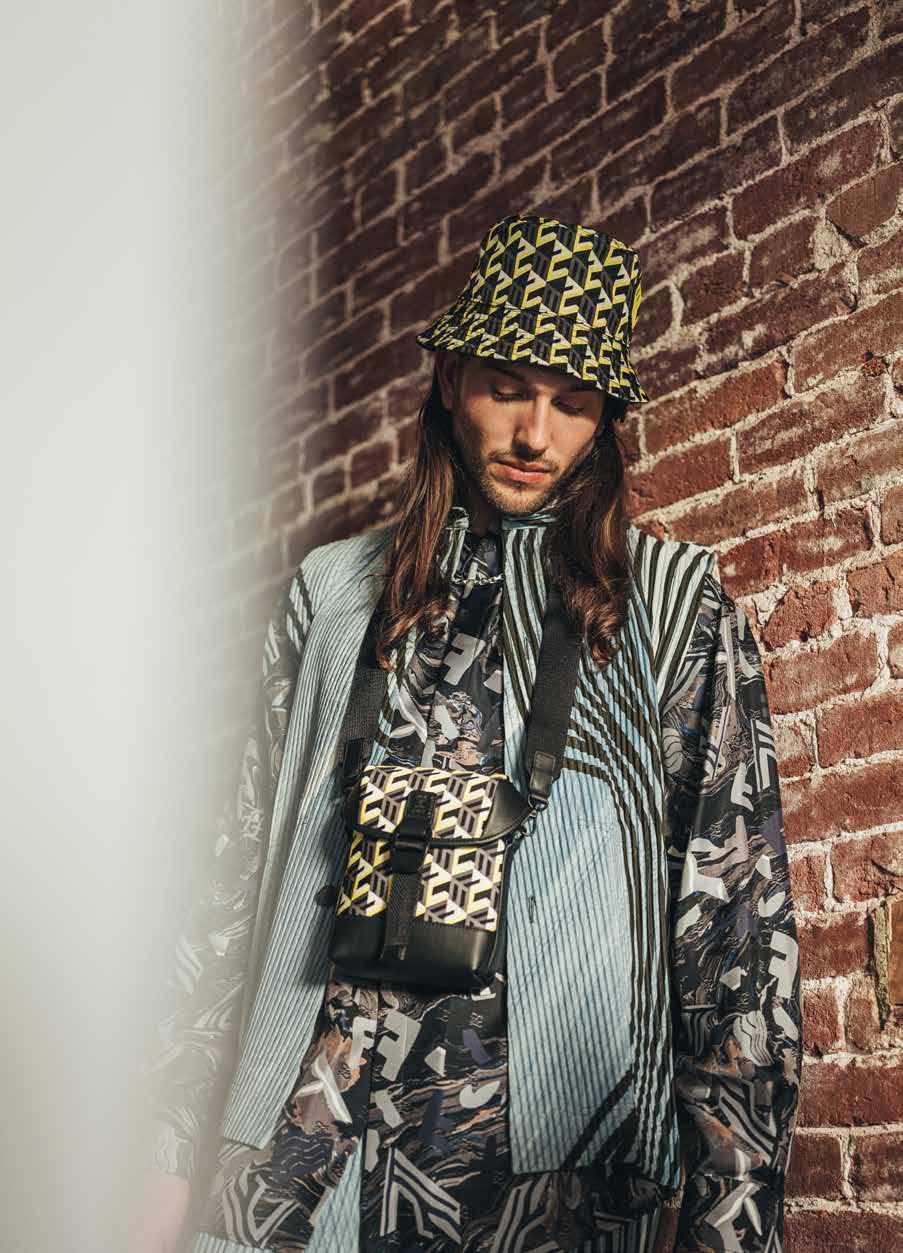
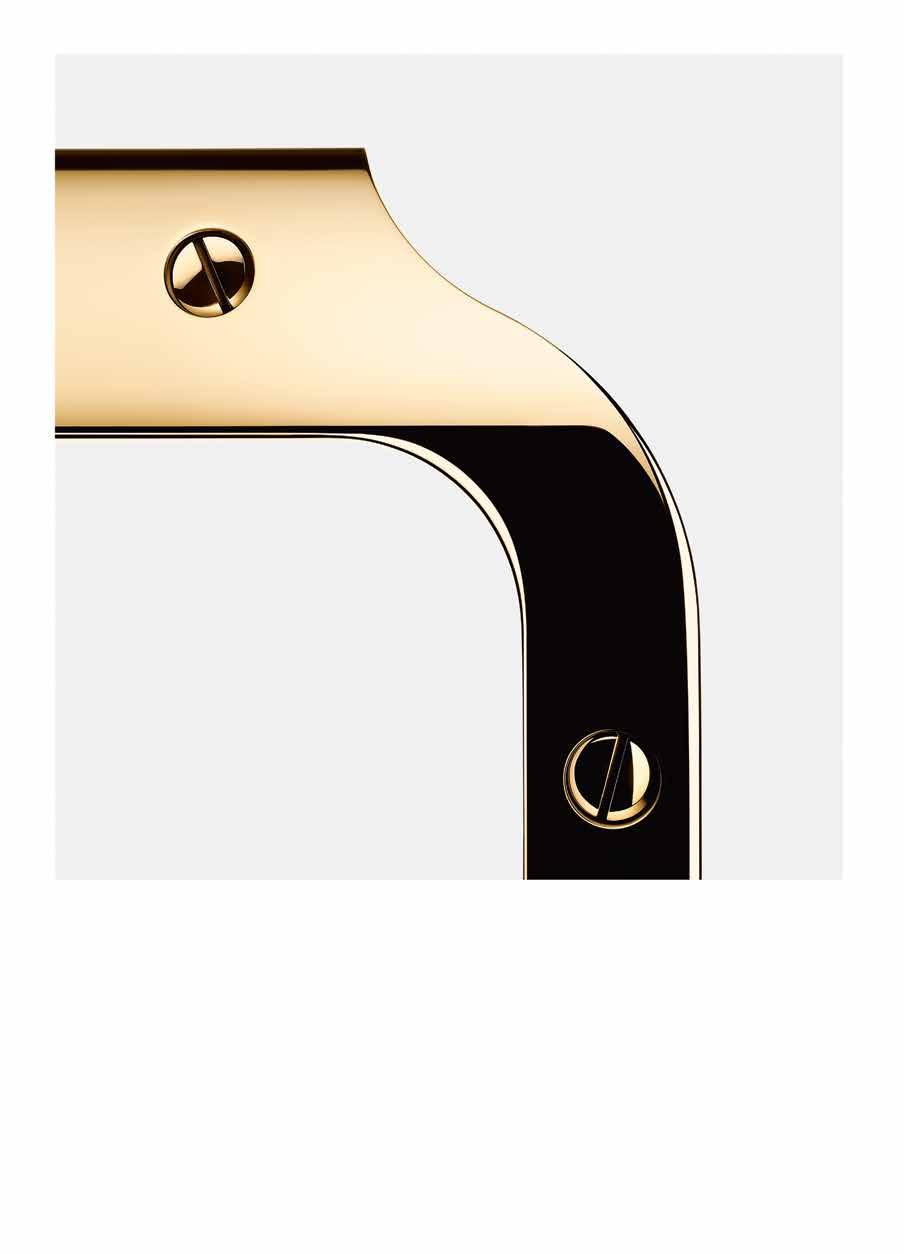
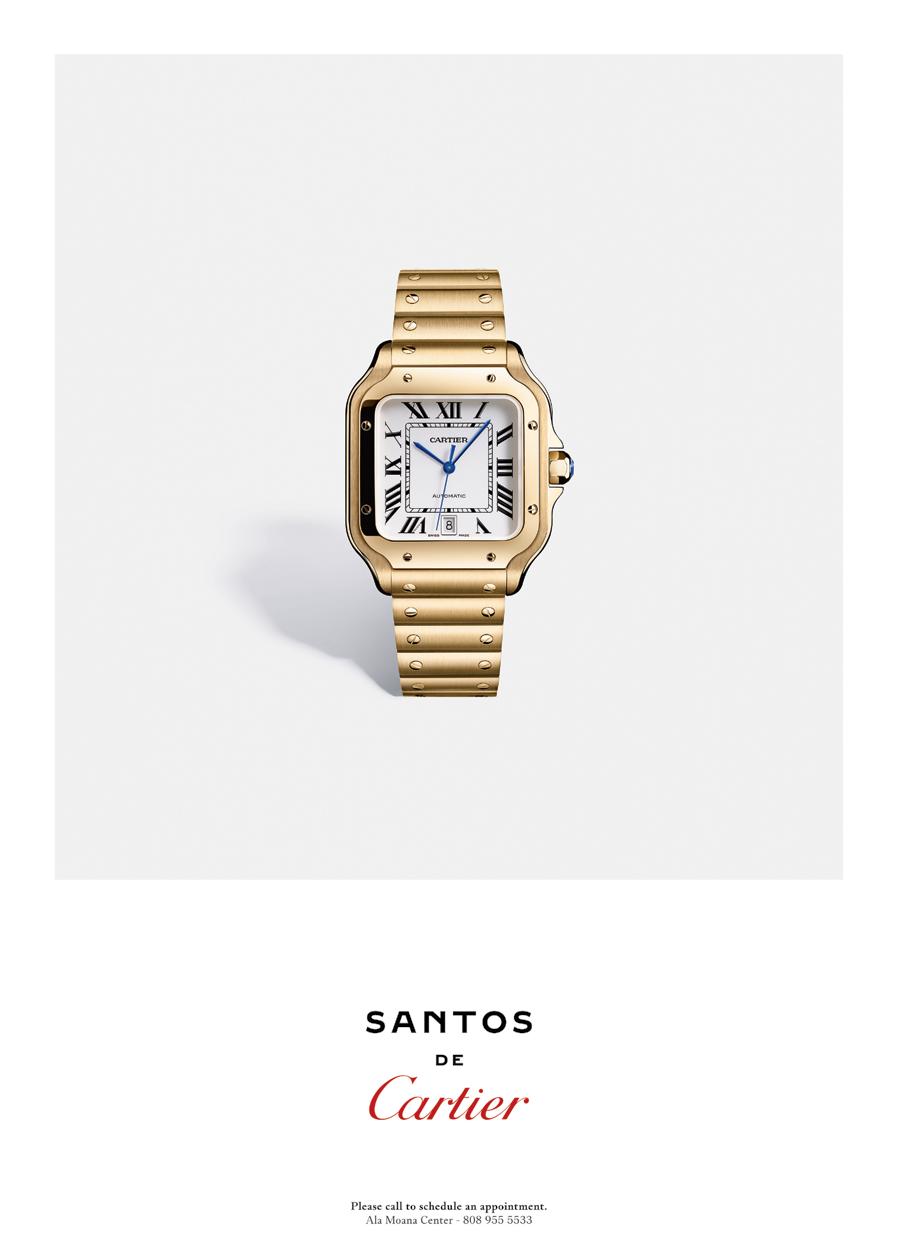

TBD

TBD
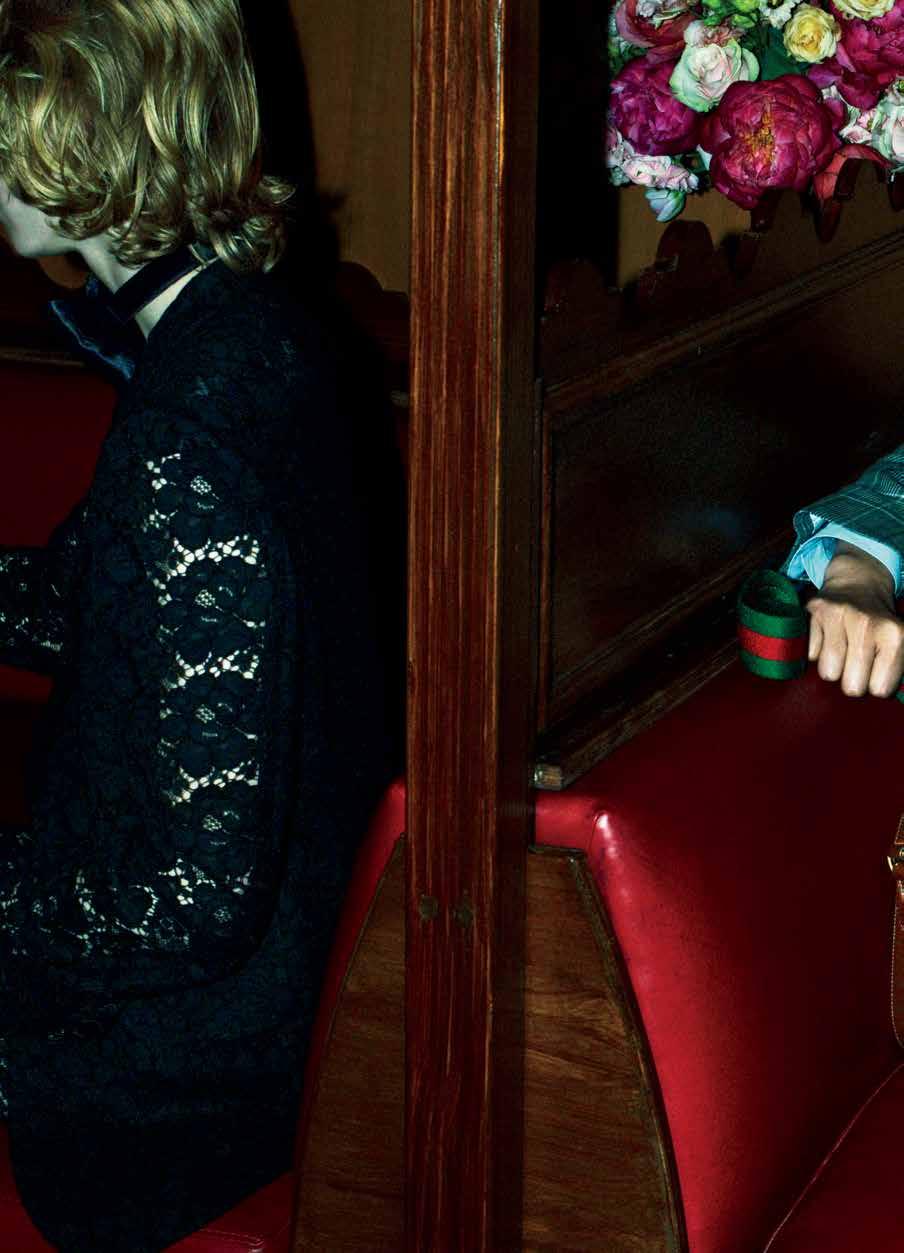

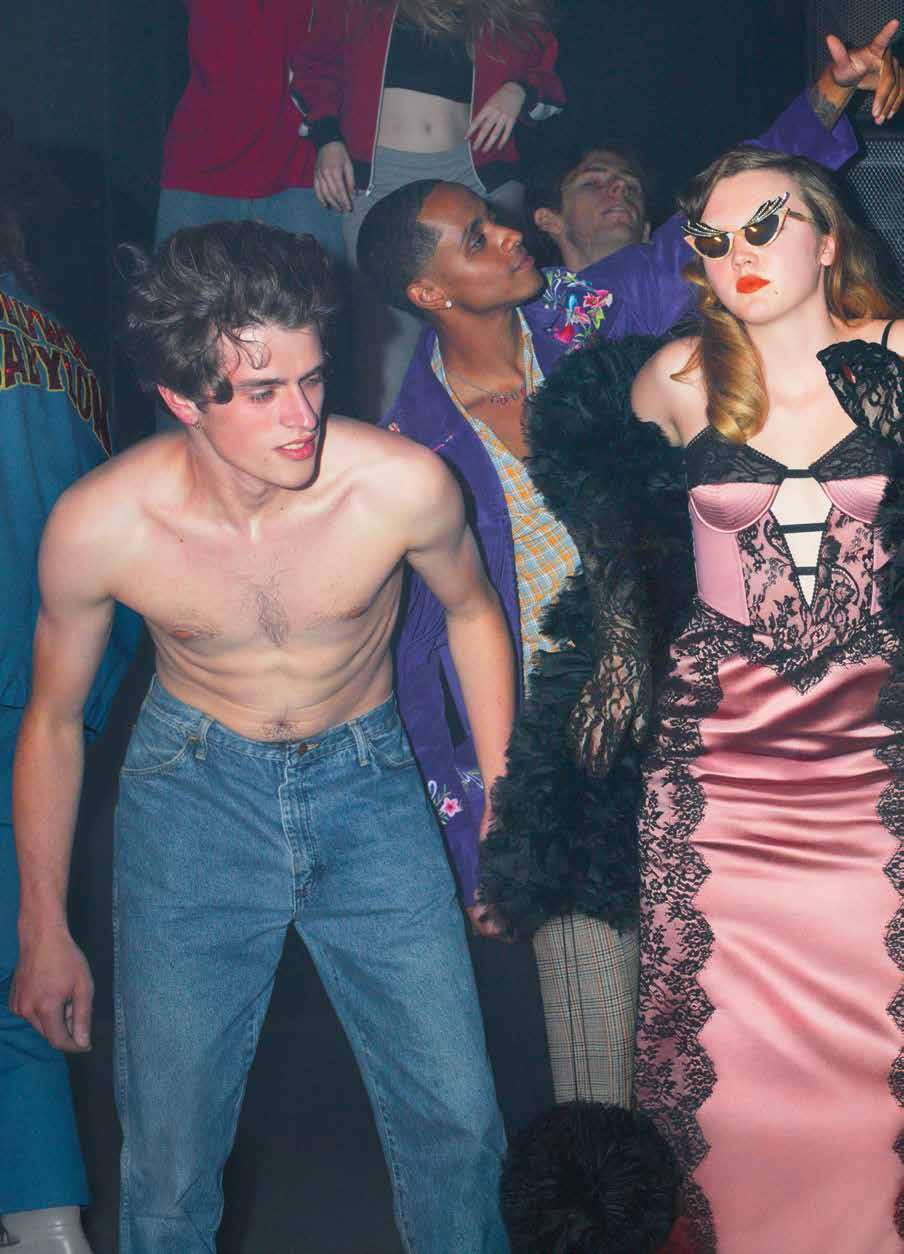




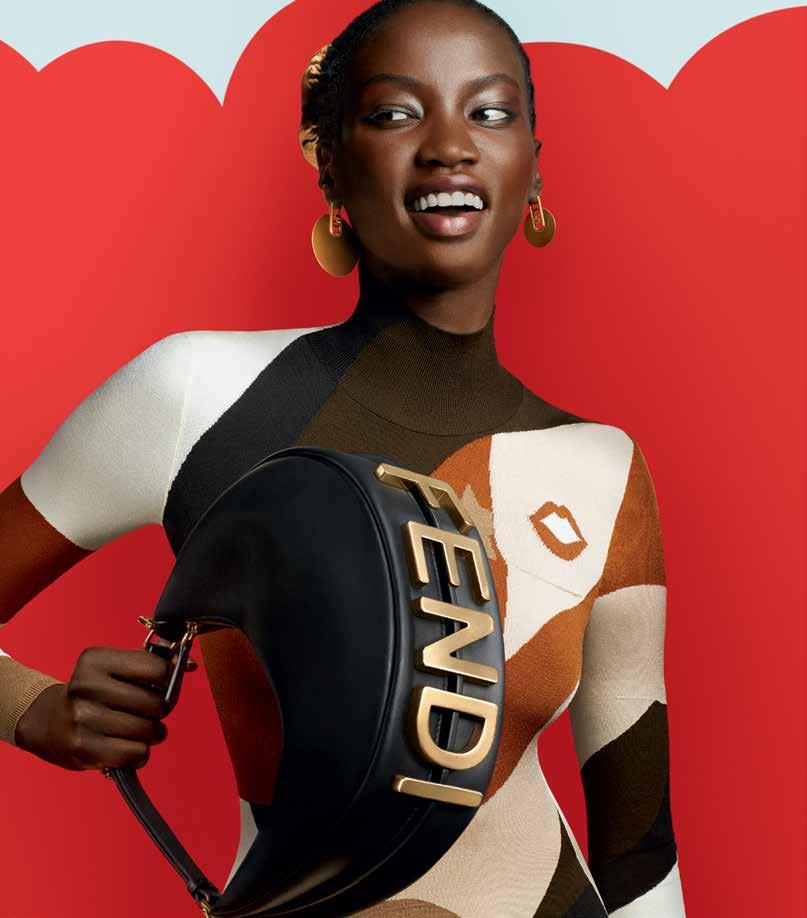
ROYAL HAWAIIAN CENTER ALA MOANA CENTER 646 520 2830 FENDI.COM
ROMA
We can never truly know what tomorrow holds, but as our days continue to regain a sense of normalcy, we can begin to consider how best to chart a path forward. In recent years, current events have demanded a hyper focus on the present moment and, at times, obscured the road ahead. This issue, we set our sights on the future. Take a tour of the cutting-edge facilities at the University of Hawai‘i West O‘ahu, where a new generation of content creators are navigating the uncharted landscape of new media. Find snapshots from Expo 2020 Dubai—a world’s fair designed to showcase the achievements of nations around the world—and the infrastructure that will remain as part of a forward-thinking urban development called District 2020. Also inside, hear how Worldwide Walls is using NFTs (nonfungible tokens, which have taken the art world by storm) to fund arts education and community beautification efforts in Honolulu’s Kalihi-Pālama neighborhood.
We also step into the mind and studio of artist Solomon Enos, whose fantastical visions for Indigenous futures offer lessons for right now. Because in the end, we look forward in order to not only chart a course for the next generation, but to imagine how we might live better today.
明日には何が待ち受けているのか。正確に知ることは誰にもできま せん。しかし、日々の暮らしが少しずつ平常に戻りつつある今、この先 どんな道を選んでいくべきか考えられるようになりました。近年の世 界の状況下で、私たちはそのときその瞬間だけに意識を向けるほか なく、先のことから目をそらさざるを得ませんでしたが、今号では視 線を未来に向けています。
ハワイ大学ウエストオアフ校の最新鋭の施設では、新世代のコ ンテンツクリエイターたちが、地図のないニューメディアの世界を手 探りで前に進んでいます。ドバイで開催された万国博覧会「エキスポ 2020」のスナップショット。そこには世界各国の功績だけでなく、未 来を見据えたインフラが都市開発に生かされ、会期が終わったあとも 「ディストリクト2020」として存続していく姿が映し出されています。
「ワールドワイド・ウォールズ」がNFTで得た資金でホノルル市カリ ヒ=パラマ地区の美術の授業やコミュニティの美化運動を支援する 物語も紹介します。
アーティストであるソロモン・イーノス氏のスタジオを訪れ、彼の 心のなかも覗いてきました。ハワイアンの人々を空想的な視点から 描くイーノス氏の世界には、今こそ生かせる教訓がいくつも潜んでい ます。なぜなら、結局のところ私たちは次世代のために最善の道を選 ぼうとしているだけでなく、私たち自身が今日という日をよりよく生 きる方法を模索しているのですから。
12 LETTER From the Developer
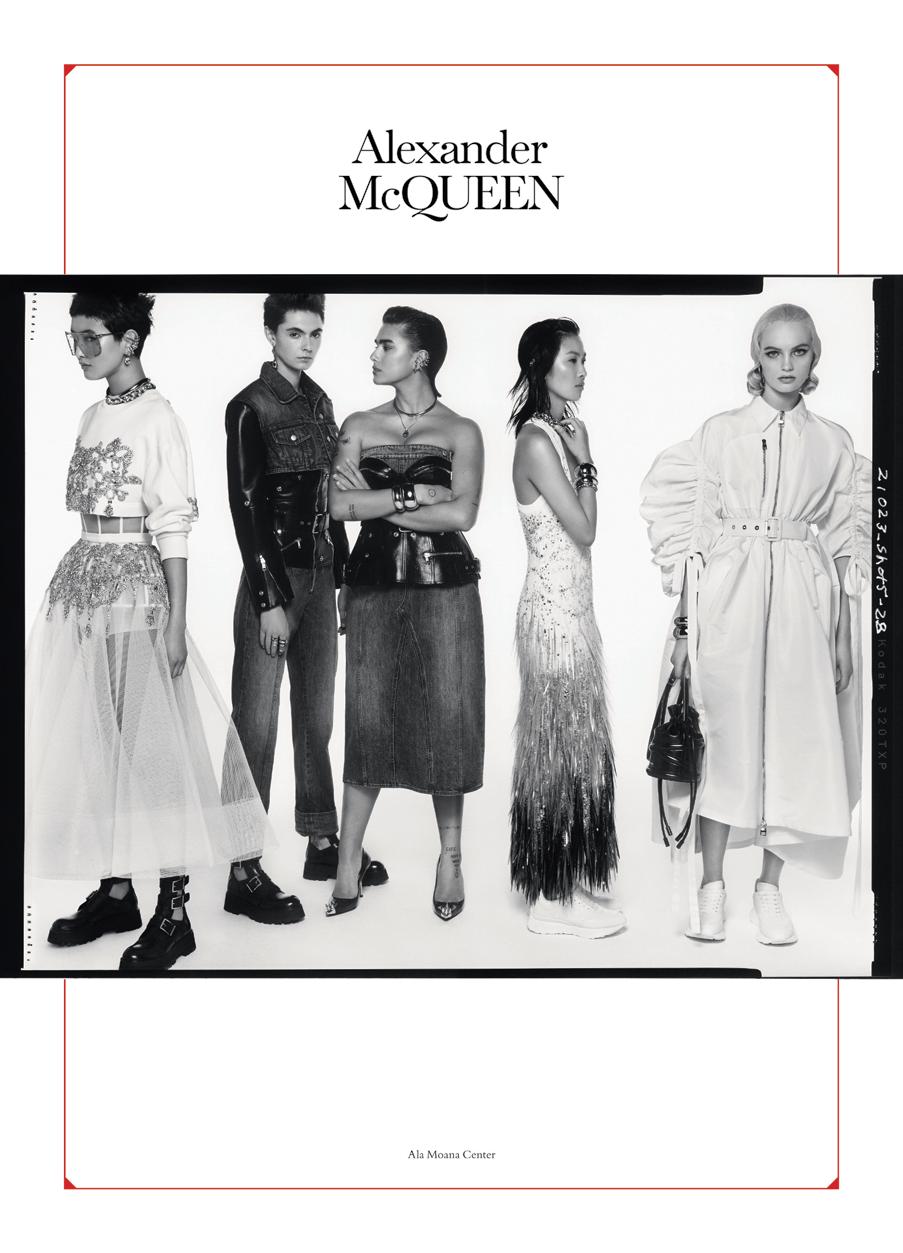
CEO & PUBLISHER
Jason Cutinella
VP BRAND DEVELOPMENT
Ara Laylo
EDITORIAL DIRECTOR
Lauren McNally
EDITOR-AT-LARGE
Matthew Dekneef
SENIOR EDITOR
Rae Sojot
DIGITAL EDITOR
Eunica Escalante
SENIOR PHOTOGRAPHER
John Hook
DESIGNERS
Nico Enos
Mai Lan Tran
TRANSLATIONS
Japanese Yuzuwords by Tomoko Shirota
Korean AT Marketing
CREATIVE SERVICES
Marc Graser
VP Global Content
Gerard Elmore
VP Film
Sheri Salmon
Creative Services Manager
Kaitlyn Ledzian
Brand Production Manager
Taylor Kondo
Brand Production Coordinator
Blake Abes
Romeo Lapitan
Erick Melanson
Filmmakers
Jhante Iga
Video Editor
Brigid Pittman
Digital Content &
Social Media Manager
PUBLISHED BY:
NMG Network
36 N. Hotel St. Ste. A Honolulu, HI 96817
ADVERTISING
Mike Wiley
VP Sales mike@nmgnetwork.com
Kristine Quine Sales Strategy Director
Courtney Asato
Marketing & Advertising Executive
Nick Lui-Kwan Account Executive
Codey Mita Sales & Marketing Coordinator
OPERATIONS
Joe V. Bock Partner / General Manager - Hawai‘i
Francine Naoko Beppu VP Integrated Marketing
Gary Payne VP Accounting
Tim Didjurgis Operations Director
© 2022 by Nella Media Group, LLC. All rights reserved. No part of this publication may be reprinted without the written consent of the publisher. Opinions are solely those of the contributors and are not necessarily endorsed by NMG Network.
PALM is published exclusively for:
MACNAUGHTON & KOBAYASHI GROUP
14
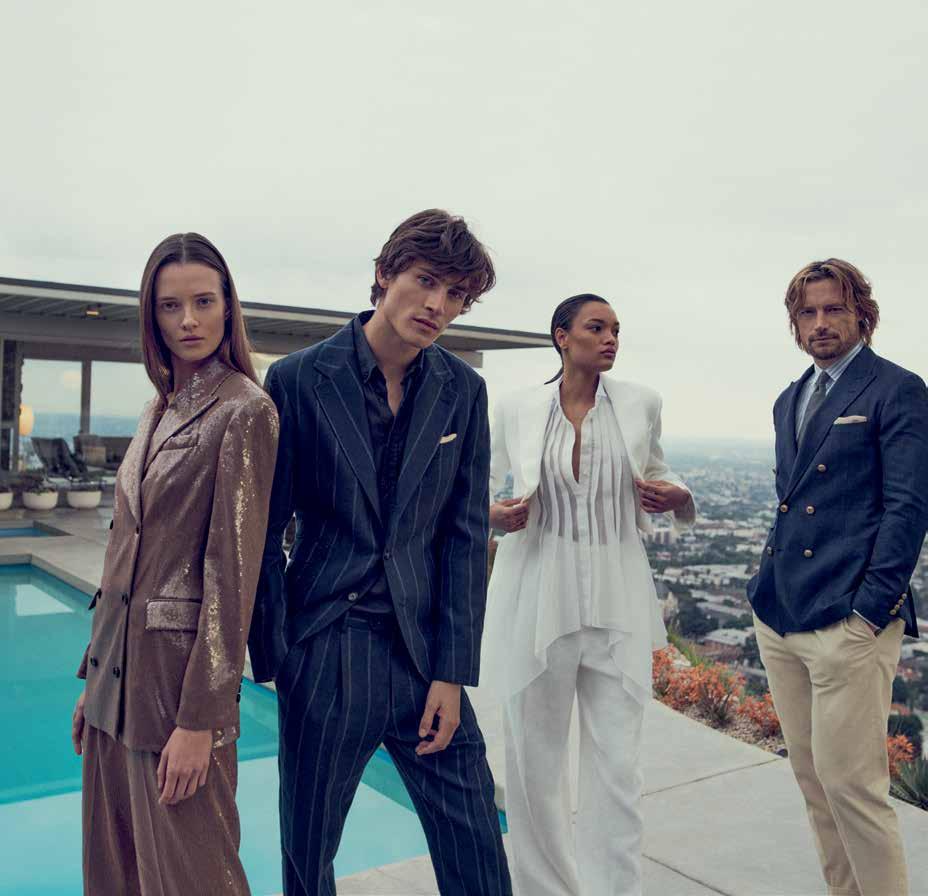
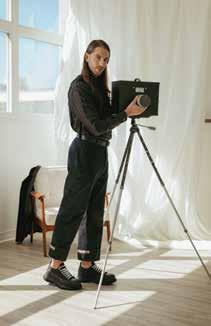
A moment with Allen Freese in a loft space on Hotel Street in Chinatown, captured by
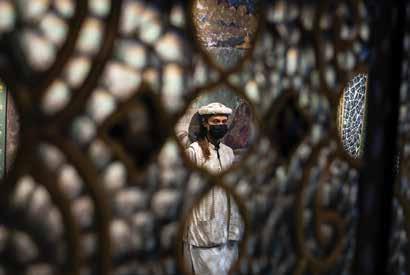
102 16 TABLE OF CONTENTS ARTS 22 Escapist Activism 34 Token of Goodwill BUSINESS 44 The Learning Curve CULTURE 56 Beyond Borders DESIGN 70 Building for Tomorrow 80 Downtown Dapper 94 Feels Like Home ESCAPES 102 Future Perfect 118 Human Nature FARE 132 Baked with Aloha 80 ON THE COVER
Mark Kushimi.
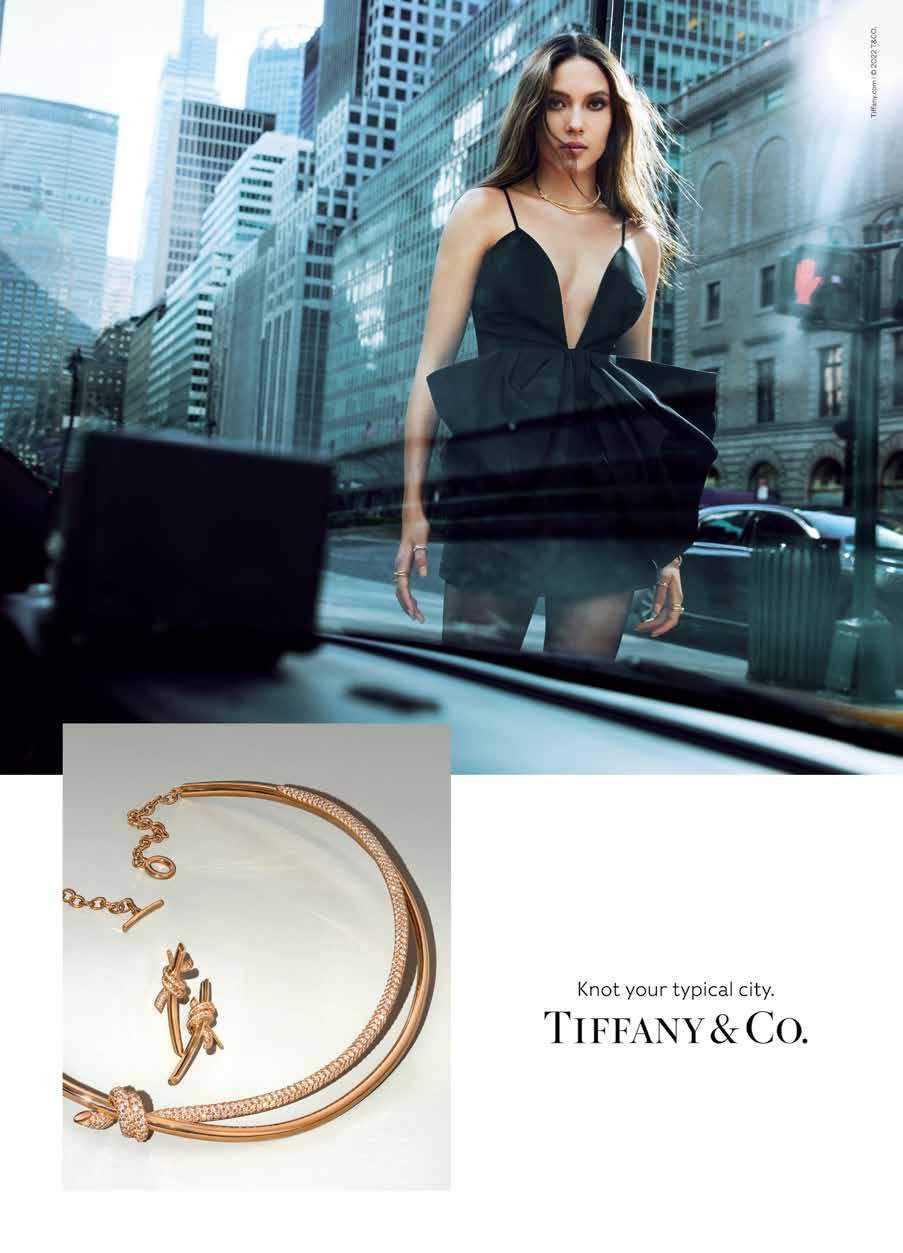

表紙
写真:マーク・クシミ
モデル:アレン・フリース
撮影場所:ホテルストリート
アート 22
現実逃避をしながら社会を変える人 34
善意のしるし
ビジネス 44
学習曲線
文化 56 あらゆる境界を超えて
デザイン 70
未来の建築 80 ダウンタウンダッパー 94
まさに我が家 エスケープ 102
未来型の都市へ 118
あるべき姿 食 132
アロハなおやつを召し上がれ

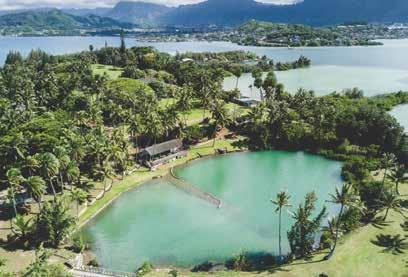
18 102 118 目次

ON DISPLAY AND FOR SALE: WORLD-CLASS ART ON WAIKIKI Works
by Picasso, Rembrandt, Renoir, Chagall, Toulouse-Lautrec, Peter Max, Michael Godard, Romero Britto, and others.
マイケル・ゴダード、ロメロ・ブリット、その他巨匠の作品。 FINE ART MUSEUM GALLERY & AUCTIONS EST. 1969 PARK WEST ® On the Waikiki Beach Walk. ワイキキ・ビーチ・ウォーク内 808.859.4871 parkwesthawaii.com
展示および販売中:世界中から集められた貴重な作品をワイキキで見ることができます ピカソ、レンブラント、ルノアール、シャガール、ロートレック、ピーター・マックス、
notions
AR TS
that amplify
A PALM アート
Visual
the soul of the city
21
A
PALM PALM
Escapist Activism
現実逃避をしながら社会を変える人
写真 = クリス・ローラー
22 PALM
文 = ジェイド・スノウ
ARTS Solomon Enos A
Text by Jade Snow
Images by Chris Rohrer

In the fantastic cultural multiverse of artist
Solomon Enos, a vision of harmony and hope reigns.
アーティストのソロモン・イーノスさんの多元的な空想の世界は、調和と希望に あふれた未来へのビジョンがつかさどる世界です。
Translation by Eri Toyama Lau
翻訳 = ラウ外山恵理
예술가 솔로몬 에노스(Solomon Enos)의 환상적 인 컬쳐 멀티버스에는 조화와 희망의 비전이 물들
여있습니다.

The home studio of Native Hawaiian artist Solomon Enos is an unassuming trove of wonders. An Oculus virtual reality headset is nestled amid paint cans splattered in earthy hues. A hardcover copy of The Epic Tale of Hi‘iakaikapoliopele (his breathtaking illustration of the eponymous goddess on its cover) is sandwiched on a congested shelf, its load suspended precariously above the board game Warhammer and a crate of handmade sculptures. An army of tiny figurines stands en masse atop the shelf, where a mo‘o (lizard) creeps among vines growing through the wood. “I am as organized as a forest,” he laughs.
ネイティブハワイアンのアーティスト、ソロモン・イーノスさんの自宅のスタジオは、 つつましくも神秘に満ちた宝物であふれている。大地を思わせる色彩が飛び散る ペンキ缶が転がり、オキュラス社のバーチャルリアリティ・ヘッドセットがひっそり 埋もれている。「ヒイアカイカポリオペレ物語」のハードカバーが、ぎゅうぎゅうに詰 まった本棚に押し込められている。表紙を飾る息をのむようなイラストは、イーノス さんが描いた主人公の女神。「ウォーハンマー」のボードゲームとハンドメイドの彫 刻が詰まったコンテナの上で、本棚は危うい均衡をたもっている。棚のてっぺんの 小さなフィギュアたちの横で、木に絡みついた蔓のあいだをモオ(とかげ)がささっ と移動する。「森と同じで、僕は整理整頓が苦手なんです」イーノスさんは笑った。
24 A PALM ARTS Solomon Enos
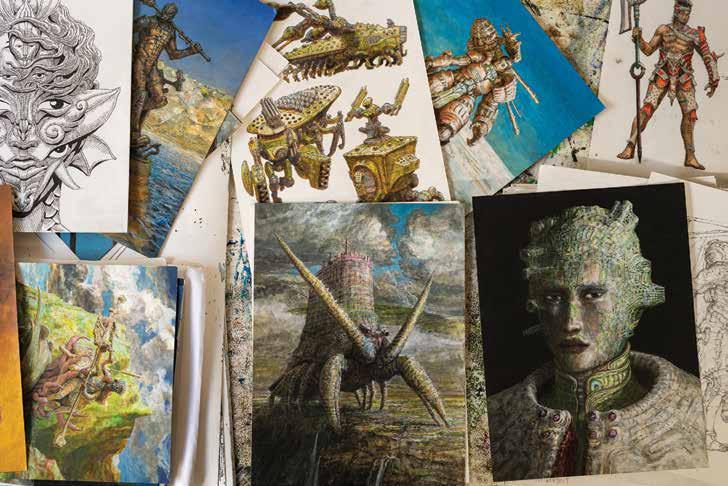
For the last 15 years, artist Solomon Enos has been exploring a simple but endlessly evocative question: What would it be like if Hawai‘i had never been interrupted by Western contact?
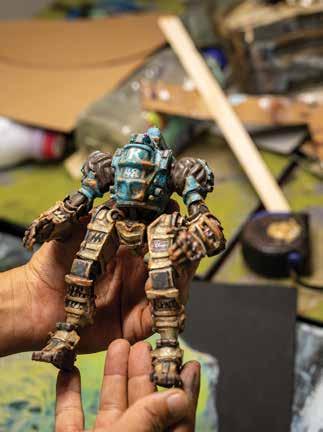
The world of Polyfantastica is populated by reimagined life forms with dynamic abilities and characteristics of both flora and fauna.
Fittingly, nature is where Enos’ story begins. Growing up, Enos was immersed in a sense of kuleana (responsibility) to the ‘āina (land) through the work of his father, Eric, a talented Hawaiian artist who founded the nonprofit Ka‘ala Cultural Learning Center in Wai‘anae Valley in 1978. There, the Enos family welcomed volunteers, often troubled by addiction and broken homes, and worked tirelessly to restore the valley and heal their community. In caring for the land and teaching valuable resource management, they also passed on Hawaiian knowledge in the process.
Though his spirit remained connected to the ‘āina, Enos’ imagination wandered. “My brothers wanted to do things outside growing up, but I wanted to go inside,” Enos says, gesturing to himself. He had a natural talent for art in his youth, which caught the attention of close family and friends. He recalls the advice of Uncle Eddie Ka‘anā‘anā, a beloved Ka‘ala partner and famed kalo farmer, who took notice of the boy’s earliest works. While up in the mountains one day, when Enos was about 12 years old, Uncle Eddie pulled him aside. “He took my hand, closed his eyes for maybe 15 seconds,” Enos remembers, “and said, ‘Solomon, if you’re given a gift and you don’t share it, it’s going to make you sick.’” That profound statement stayed with him ever since and has guided his lifelong practice of art and activism.
いかにもといおうか、イーノスさんの物語は自 然のなかで育まれてきた。父親の活動を通してアイナ (土地)に対するクリアナ(責任)を強く意識しながら 大人になったそうだ。イーノスさんの父、エリックさん は才能あるハワイアンのアーティストで、1978年、ワ イアナエ・ヴァレーでカアラ・カルチュアル・ラーニン グ・センターという非営利団体を立ち上げた人だ。イ ーノスさん一家は依存症に苦しむ人や家庭環境に問 題がある人々をボランティアとして歓迎し、ワイアナ エヴァレー一帯の秩序を取り戻し、コミュニティに平 穏な日々を取り戻すために献身的に働いた。土地の 手入れや貴重な資源の管理術を教えることで、ハワ イアンとして受け継がれてきた知識を人々に伝えた。 イーノスさんの魂がアイナから離れることはな かったが、彼のイマジネーションはあてもなくさまよ った。「小さい頃から兄は外向的で外へ外へと出てい こうとしましたが、僕の思考はつねに内側に向かって いました」イーノスさんはそう言って自分を指差した。 彼が持って生まれた芸術的才能は、幼いうちから親 しい家族や家族の友人に注目されたそうだ。イーノ スさんがアンクルと呼ぶエディ・カアナアナさんは、カ アラのラーニングセンターのパートナーとして人々に 愛された人で、カロ栽培でも有名だったが、そのカア ナアナさんもイーノスさんの作品にいち早く目を留め た。イーノスさんが12歳くらいの頃、山のなかでアン クル・エディに脇に呼ばれたそうだ。「アンクル・エディ は僕の手を握り、15秒くらいだったか目を閉じたあ とに言ったんです。才能に恵まれたら、その才能を役 に立てないと、どこかがおかしくなってしまうよって」 意味深長な言葉は、以来イーノスさんの頭に焼きつ いて、アーティスト、そしてアクティビストとしての彼の 人生を導いてきた。
PALM A
26 ARTS Solomon Enos



Enos finds endless inspiration in the juxtaposition of opposites—tradition and technology, urban and rural, Kū and Hina. His work, which explores Indigenous perspectives in the context of the modern world, seeks lessons within these dichotomies. “The most important technology we have is compassion,” he declares, a theme woven throughout his art, most notably his mindbending series Polyfantastica, a body of work that depicts an expansive universe he’s been developing over the last 15 years (think the science fiction of Star Wars, with the heart and soul of Avatar).
A visual thought experiment, Polyfantastica contemplates a simple question that piqued Enos’ curiosity more than a decade ago: What would it be like if Hawai‘i had never been interrupted by Western contact? To date, the project includes 400 drawings of futuristic beings, artifacts, and technologies chronicled over an imagined 40,000-year timeline divided by four thematic epochs—Wa Kuu, Wa Rono, Wa Tane, and Wa Tanaroa—each based on a Hawaiian akua (god) and their defining characteristics. Enos is meticulous in his illustrations, which include animalic warriors and “walking landscapes”—natural environments shaped into massive humanoids. He combines elements of flora and fauna into reimagined life forms with dynamic features, abilities, even built-in defense mechanisms.
“I think of [Polyfantastica] as activist escapism, or escapist activism,” Enos explains, turning one of his 40 handcrafted epoxy figures upright on a nearby table. Fantastical and impressively detailed, they are among the many creatures that populate the world of Polyfantastica. “They are basically kaona (hidden meanings) for how kūpuna (ancestors) thought of themselves,” Enos says. “They don’t just start at their po‘o (head) and end at their feet. They are the sky, they are the land, they are the mountains and oceans that surround them. For them, when you see someone doing hewa (wrong), you feel it. It’s an extrapolation of that very idea, but I’m telling it through the lens of science fiction.”
Polyfantastica’s conceit is so audacious and nebulous it could fuel any number of iterations in film, animation, and virtual reality, all mediums in which his exciting cultural multiverse could thrive and evolve. For now,
イーノスさんは対極にあるのもの同士に、果てしないインスピレーション を感じるそうだ。伝統とテクノロジー。都会と辺境の地。クウ(ハワイアンの神の ひとりで、男性的エネルギーを象徴する)とヒナ(ハワイアンの女神のひとりで、 女性的エネルギーを象徴する)。モダンな世界観のなかでハワイらしい視点を探 るイーノスさんの作品群は、こうした対比のなかに意味を求めてきた。「わたした ちが持っているもっとも重要なテクノロジー、それはじつは”他者を理解する力” です」イーノスさんの作品にはその思想が織り込まれている。もっとも顕著に現 れているのが、奇想天外な作品群「ポリファンタスティカ」。イーノスさんが15年 以上前から制作し続けているこの作品群は、壮大な宇宙観を表現している(「ス ターウォーズ」的なサイエンスフィクションに「アヴァター」的な叙情を融合させ たものを思い浮かべてほしい)。
ポリファンタスティカ」は、10数年前にイーノスさんの好奇心を刺激したある 疑問の答えを、視覚的に表す実験だ。西洋人が来なかったらハワイはどうなってい たか? イーノスさんがこれまでに描いた400枚以上のスケッチは、未来的な生物、 工芸品、テクノロジーなどを、4万年におよぶ想像上のタイムテーブルに沿って記録 してきた。「ワ・クウ」「ワ・ロノ」「ワ・タネ」「ワ・タナロア」という四つの時代には、それぞ れ特徴的なハワイアンのアクア(神)をベースとしたテーマがある。動物を思わせる 戦士たちや、巨大な人型ロボットに変わる自然の塊「動く景色」など、イーノスさんの イラストは細部までじつに丁寧に描写する。植物や動物の要素を融合させ、ダイナミ ックな特徴や能力、防衛機能さえもそなえた生物を創造してしまうのだ。 「僕は、ポリファンタスティカは、社会改革を目指す人の現実逃避、あるい は現実逃避をする人の社会改革、ととらえています」近くのテーブルには40体近 くの手づくりのエポキシ樹脂製フィギュアが並んでいる。倒れていたひとつを起 こしながら、イーノスさんは説明した。奇抜で呆れるほど手の込んだフィギュアた ちは、ポリファンタスティカの世界で暮らすたくさんの生物たちの一部だ。「彼ら は、僕たちのクプナ(祖先)が自分たちの存在をどうとらえていたかを示すカオナ (隠された意味)なのです。その姿は、単純にポオ(頭)からはじまって足で終わ るというものではありません。彼ら自身が空であり、大地であり、彼らを取り囲む 山であり、海だったのです。彼らの世界では、誰かがヘヴァ(悪い)な行いをしてい るのを見たとき、見るというより感じるのです。それこそがファンタスティカの中 核にある思想なのですが、僕はそれをサイエンスフィクションというレンズを通し て伝えようとしてきたのです」
30 A PALM
Solomon Enos
ARTS

“I think of it like a cultural laboratory,” Enos says of Polyfantastica “It’s based on our traditional stories, but because they’re my own ideas, it’s noa (free of taboo, released from restrictions). I can cut it open, I can play with it, change it—it’s happening in a cultural sandbox.”
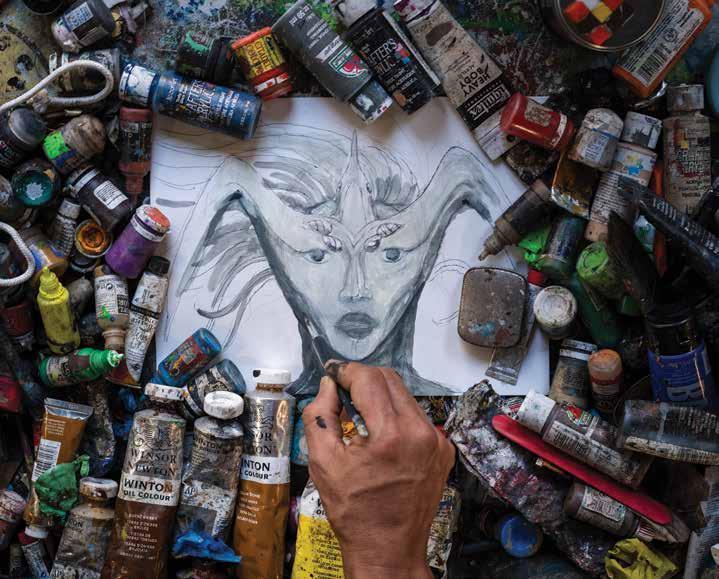
To date, Polyfantastica includes hundreds of drawings of futuristic beings, artifacts, and technologies chronicled over an imagined 40,000-year timeline.
though, the ideas are still a work in progress, a universe unfolding in the numerous sketchbooks and miniature sculptures he’s made over the years.
Enos insists that today’s clickbait culture calls for a renewed emphasis on peace and compassion. “War and conflict hold our attention,” he says, “but so can profound beauty and mystery.” Polyfantastica, then, is an invitation to contemplate “how humans and the natural world can be rewoven around narratives of harmony and hope.” It’s a place to engage deeply with one’s imagination. In the realm of Polyfantastica, philosophy, creativity, people, and nature are one.
さまざまな文化が多元的に広がる刺激的な宇宙「ポリファンタスティカ」
のコンセプトは大胆かつ幅広い意味を持つため、映画やアニメーション、バーチ ャルリアリティなど、どんなメディアでも再現できる可能性を秘めている。だが 今はまだ発展途上の段階。イーノスさんの宇宙は、彼が何年もかけて描いてき た数々のスケッチブックとミニチュアのフィギュアの世界で広がるばかりだ。
イーノスさんは、クリックベイトが横行する現代文化こそが、穏やかさと 他者への理解の大切さを改めて浮き彫りにしていると語る。「戦争や衝突に人 々は関心を奪われがちですが、壮大な美や神秘もまた人の心を奪います」つま りポリファンタスティカは「調和や希望を基調として物語を紡ぎ直したら、自然 界、そして人間はどんなふうだったか」を深く考えるきっかけなのだ。心に広が る想像の世界に没頭する場所であり、哲学、創造力、人、そして自然がひとつに なる場所。それがポリファンタスティカという宇宙なのだ。
32 A PALM ARTS Solomon Enos


702 SOUTH BERETANIA STREET, HONOLULU, HI 96813 | (808) 543-5388 | CSWOANDSONS.COM
Token of Goodwill
Text by Naz Kawakami
Images by Lan Nguyen, Chris Rohrer, and courtesy of the artists
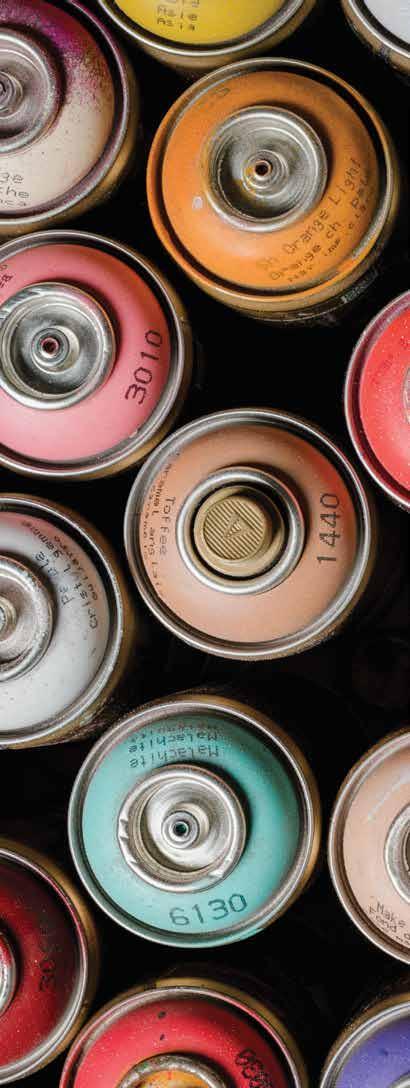
34 PALM 善意のしるし 文 = ナズ・カワカミ 写真 = ラン・ニュゲン、クリス・ローラー、 アーティスト提供
ARTS NFTs A

Through splashy NFTs, Worldwide
Walls fuels a quiet effort to champion the arts in the Kalihi-Pālama area.
HきらびやかなNFTの世界を通して、「ワー ルドワイド・ウォールズ」はカリヒ=パラマ 地区のアートを支援する努力をひっそり と続けています。

화려한 NFT를 통해 월드와이드 월스는 칼리히-
팔라마 지역의 예술을 옹호하기 위한 조용한
노력에 박차를 가하고 있습니다.
awai‘i-based arts organization Worldwide Walls, formerly known as Pow! Wow!, has done a lot of good in communities around the world. It has provided artists with professional and creative opportunities and facilitated meaningful engagement between the public and the arts through its international mural festivals. Now, the team behind Worldwide Walls has turned their focus toward education in underrepresented and underserved communities in their own backyards.
Through its NFT for Good initiative, Worldwide Walls has launched an NFT-based gallery on MakersPlace, a digital marketplace for NFTs, to fund the beautification of public housing, community centers, and schools, as well as provide funds to expand its existing educational programs. A cohort of local artists—Jasper Wong, Lucky Olelo, Woes, Shar Tuiasoa, and Wooden Wave—have contributed works of art for the gallery, committing 10 percent of proceeds to the project’s goals, which focus primarily on the Kalihi-Pālama neighborhood.
An industry valued at more than $40 billion, NFTs are one of today’s most exciting and controversial technological developments, due in part to its reshaping of the culture and economics of the global art world. An NFT, or “non-fungible token,” is a set of data which is
ハワイに拠点を置く団体「ワールドワイド・ウォール ズ」(元「パウ! ワウ!」)は世界各地のコミュニテ ィに大きく貢献してきた。国際的なミューラル(壁 画)フェスティバルを通じて、アーティストたちがプ ロとしてクリエイティブな活動を行う場と、一般の 人々がアートと触れ合う有意義な機会を提供して きたのだ。そして今、ワールドワイド・ウォールズを 支えるチームは、これまで冷遇されがちだった、自 分たちの裏庭ともいうべきコミュニティの教育支 援に取り組もうとしている。
「NFT・フォー・グッド」という名の新しい構想 のもと、ワールドワイド・ウォールズはNFTで取引さ れるデジタル市場「メイカーズプレイス」でNFTベ ースのギャラリーを立ち上げた。そこから得られる 利益を、公営住宅やコミュニティセンター、公立校 の美化だけでなく、すでに始動している教育プログ ラムの拡張費用にあてようというのだ。ジャスパー・ ウォング、ラッキー・オレロ、ウォーズ、シャー・トゥイ アソア、そしてウッドゥンウェイブといったアーティ ストたちがこのギャラリーで作品を展示し、収益の 10パーセントは、カリヒ=パラマ地区に重点を置い たプロジェクトのために使われる予定だ。
市場全体の価値は400億ドルといわれる NFTは、グローバルなアートシーンを文化的、経済 的に大きく変えつつあるという点で、現在もっとも エキサイティングで、なおかつ物議をかもしている テクノロジーだ。「非代替性トークン」すなわちNFT は、暗号通貨の売買が記録されるデジタル台帳、ブ ロックチェーン上に保存されるデータ単位で、特殊 なグラフィックイメージやデジタルアート作品(ビ デオ、写真……というより、むしろデジタルファイル
Translation by Eri Toyama Lau 翻訳 = ラウ外山恵理
36 A ARTS NFTs
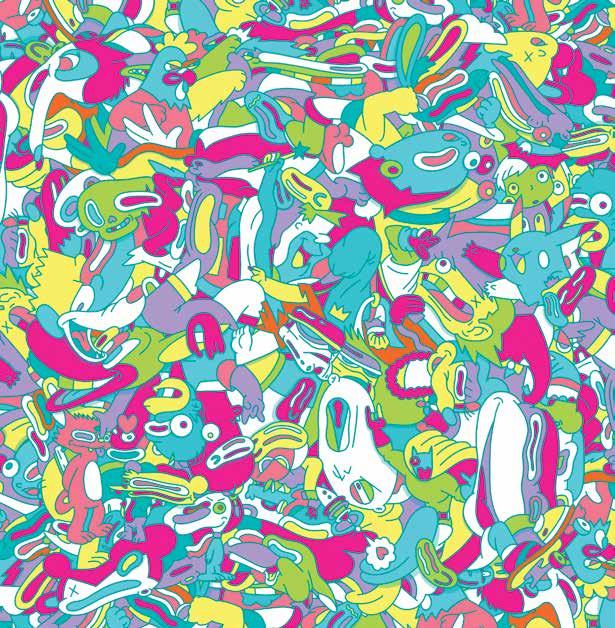 Above, NFT artwork by Jasper Wong titled Saturdaze On opposite page, Lucky Olelo in front of his completed mural for Pow! Wow! Hawai‘i 2019.
Above, NFT artwork by Jasper Wong titled Saturdaze On opposite page, Lucky Olelo in front of his completed mural for Pow! Wow! Hawai‘i 2019.
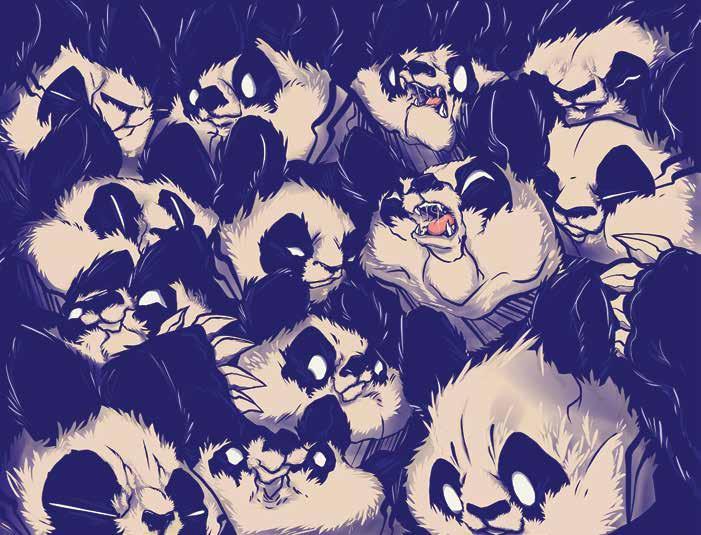
Above, NFT artwork by Woes titled Midnight , from the series Wall Of Fur N Fang On opposite page, Wooden Wave works on a mural for Worldwide Walls’ 10-year anniversary exhibition at Bishop Museum in 2021.
stored on a blockchain, a digital ledger where cryptocurrency transactions are recorded, and is represented by a specific graphic image or work of digital art (a video, a photograph—any digital file, really). The NFT itself, then, is not the artwork, but rather the transaction data recorded on the blockchain, which verifies the work’s authenticity, ownership, and monetary value, and serves as the apparatus by which artists and art collectives like Worldwide Walls are able to operate outside of traditional art institutions.
Though most famous for its forward-thinking mural events in cities such as Honolulu, London, and Venice, Worldwide Walls has also been devoted to quieter projects at home, including filling in the gaps in
ならなんでもあり)に象徴される。NFTそのものは アート作品ではなく、ブロックチェーンに記録され た売買のデータで、そのデータが作品の真正性、 所有権、資産的価値を明らかにする。ワールドワイ ド・ウォールズのようなアーティストやアート作品 の集団が既存の美術団体を通さずに活動すること を可能にした機関ともいうべきものなのだ。
ホノルルやロンドン、ベニスなどの都市で行わ れた未来志向のミューラルイベントでその名を広 めた「ワールドワイド・ウォールズ」だが、ハワイの 公立校の美術教育に欠けているものを補おうとす るなど、地域に密着した地道なプロジェクトにも力 を注いできた。ワールドワイド・ウォールズの創設 者であるジャスパー・ウォングさんはカラニ高校の 卒業生。公立校の授業がどれほどお粗末だったか は、自身の体験を通して理解している。「公立高校
38 PALM A ARTS NFTs

public arts education in the islands. A Kalani High School alumnus, founder Jasper Wong experienced those gaps firsthand. “As a public school kid, I remember art and music being forgotten to a degree,” Wong says. “When there are budget cuts, public schools tend to remove art and music curriculum first, and in Hawai‘i, there are always budget cuts.”
Dismissed as nothing more than a hobby, art is often put on the chopping block for its perceived lack of value, Wong explains. The booming popularity and monetization of NFTs, however, have begun to turn that perception on its head, with digital works of art going for upwards of millions of dollars, sold and traded independently of formal institutions and galleries and entirely over the internet. “NFTs validated digital art within the fine art world,” Wong says, allowing artists to offer up their work on the global market and turn a profit. Moreover, NFTs provide Worldwide Walls a language in which to educate students on the business side of the art that they produce.
Worldwide Walls is working in support of institutions like Palama Settlement, which has been engaged in community outreach and education for more than a century. During the pandemic, as students started distance learning, many didn’t have ready access to computers or the internet to keep up with their education. As a result, students either dropped several grades behind or fell out of the school system altogether. This issue is what the community center has been addressing as of late, and where Worldwide Walls seeks to support them: by teaching art curriculum and helping to provide necessary materials such as art supplies and iPads.
Through NFT for Good, Worldwide Walls will ultimately provide the Kalihi-Pālama area with new murals and works of art for the community to view, enjoy, and, perhaps most importantly of all, share in their creation. After all—if the organization’s years of collaborative mural festivals have proven anything—it’s what goes into a work of art that makes it beautiful.
に通った身として、美術や音楽がどれだけ軽んじられていたかはよくわかって います」ウォングさんは語る。「予算がカットされるたびに美術と音楽のカリキ ュラムが切り捨てられるのです。そして、ハワイでは年がら年中予算がカットさ れていますからね」
ただの趣味。価値のないもの。そうした考えのもと、美術はばっさり切り捨 てられるばかりだったとウォングさんは説明する。しかし今、突然脚光を浴び、 資金を引き寄せるNFTは、そんな美術への考え方を一変させた。デジタルアー ト作品の価値が数百万ドルまで跳ね上がり、形式ばった美術団体やギャラリ ーを通さなくても、インターネットのみで独自に売買される昨今。アーティスト がグローバルな市場で自分の作品を展示し、利益を得る手段を与えたことで、 「NFTはデジタルアートを芸術作品として認めさせたのです」それだけではな い。NFTのおかげでワールドワイド・ウォールズは、生徒たちが自分の作品の商 品価値を学ぶための格好の言語を提供してくれた。
ワールドワイド・ウォールズは、一世紀以上前から地域での奉仕活動や教 育に貢献しているパラマ・セトルメントのような機関を支援している。パンデミ ックで遠隔教育がはじまったとき、授業を受けるためのコンピュータやインタ ーネットへのアクセスがない子供たちが大勢いた。その結果、進級できなかっ た生徒や、学校を中退してしまった生徒も多かった。ワールドワイド・ウォール ズは、美術の授業で教壇に立ったり、作品制作用の材料やアイパッドなど必要 な教材を提供したりして、コミュニティセンターが以前から取り上げていた問 題に取り組んでいる。
NFT・フォー・グッドを通して、ワールドワイド・ウォールズはカリヒ=パラ マ地区に新しい壁画やアート作品を提供する予定だ。こうした作品は、コミュ ニティで暮らす人々の目を楽しませるためのものだが、それ以上に、アーティス トが作品を生み出すプロセスを目撃できることの意義のほうが大きいかもし れない。ワールドワイド・ウォールズが数年来続けている、アーティストが集ま ってミューラルをつくり上げるフェスティバル。それが何を証明したかといえ ば、結局のところ、作品を美しくするものは、そこに注がれる魂の美しさだとい うことだろう。
40 PALM
ARTS NFTs A
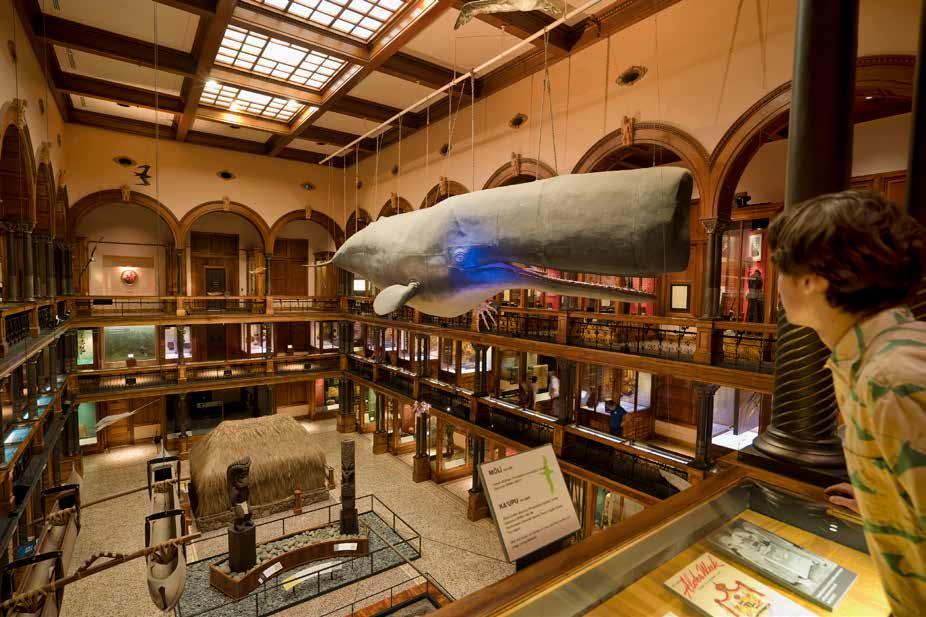


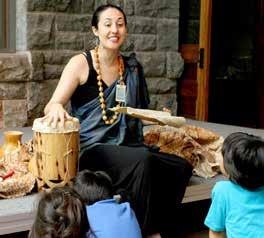
Discover Hawai‘i's Museum Open Daily 9 am - pm bishopmuseum.org 1525 Bernice Street, Honolulu, Hawai‘i 96817 808.847.3511 Living Culture | Natural Science | Immersive Programs
Top: Hawaiian Hall by Ann Cecil. Bottom row: Pacific Hall by Linny Morris
Trends that drive
BU SIN ESS
B PALM ビジネス
the economy
43
PALM B
The Learning Curve
学習曲線
Text by Lindsey Kesel
文 = リンゼイ・ケセル
Images by Josiah Patterson
写真 = ジョサイア・パターソン
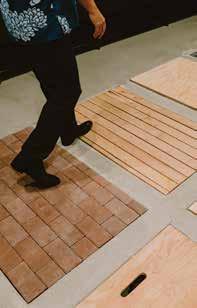
Film producer and Academy for Creative Media founder Chris Lee is pictured at ACM’s state-of-the-art Creative Media Facility in Kapolei.

44 PALM B BUSINESS Creative Media

Twenty years in the making, a neoteric hub for students stepping into a new frontier of digital media takes shape.
Translation by Mikiko Shirakura
翻訳 = 白倉三紀子
제작 20년 만에 디지털 미디어의 새로운 영역으로
발을 들여놓는 학생들을 위한 네오테릭 허브가
구체화되었습니다.

Establishing the first industry-standard digital media production center for students in Hawai‘i was always part of Chris Lee’s master plan to create a pipeline for homegrown industry talent. But first, he had to convince the University of Hawai‘i’s board of regents that the state needed something much bigger than a typical film school.
In 2002, UH hired the ‘Iolani School graduate and former president of production for Columbia and TriStar Pictures to create a filmmaking degree program at its Mānoa campus. Lee, a prescient thinker, hoped to extend that vision toward a system-wide academy with state構想20年。デジタルメディア業界の最先端を目指す学生の新しい学 びの場がついに誕生しました。
業界の標準を満たすハワイ初の「学生向けデジタルメディア制作センター」の 設立。メディア業界で活躍するハワイの人材パイプラインをつくりたいと考えて いたクリス・リーさんが、その計画の一環としてかねてより温めていたプロジェ クトだ。だが、その実現にはまずハワイ大学の理事会を説得し、いわゆる映画 専門学校よりもはるかに大規模なものが必要だということを理解してもらわな ければならなかった。
2002年、ハワイ大学は、私立イオラニ校の卒業生であり、コロンビアピ クチャーズやトライスターピクチャーズでプロダクション担当社長を務めたク リス・リーさんを起用し、マノア校に映画製作の学位を取得できるプログラム
46 PALM B BUSINESS Creative Media
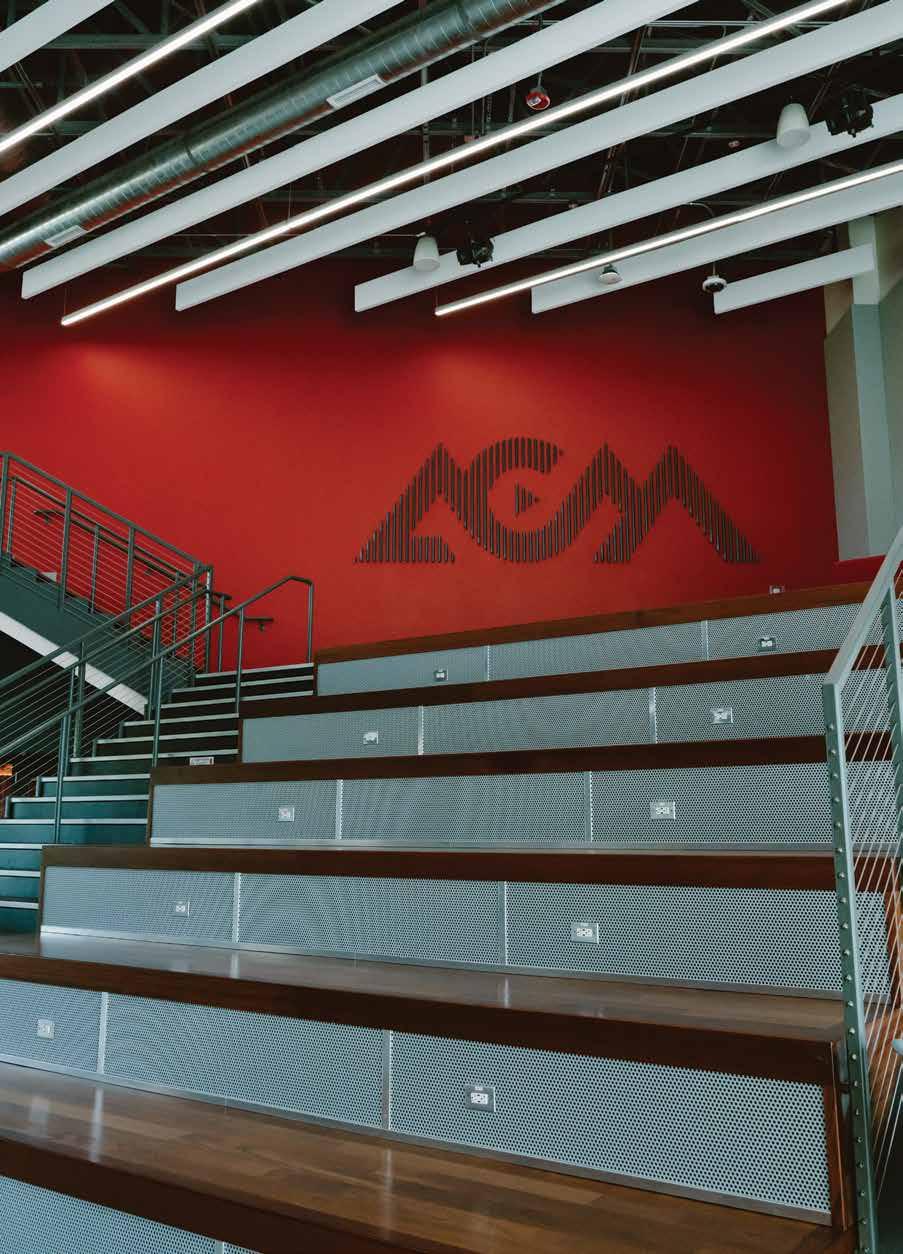

of-the-art facilities and tech that looked to the future of media in order to diversify Hawai‘i’s economy and create living-wage jobs.
With that in mind, he proposed leveraging existing resources from the university’s 10 campuses across the islands to launch the filmmaking program at Mānoa, then gradually add additional creative media programs with complementary curriculum at other campuses. Eventually, the academy would offer training in all facets of production, including short-form media already emerging as a result of smartphones and social media.
After a year of getting feedback on his concept from everyone from motion picture and TV industry players to policymakers and local high school students, the Academy of Creative Media got the green light from the board in December 2003. “From the start, [the academy] was designed as a catalyst for developing 21st-century jobs in the global creative marketplace right here in Hawai‘i,” Lee says, “and a platform for our Indigenous stories to be told to the broadest possible audience.”
Over the next decade, ACM built out the Mānoa program and helped start or enhance creative media programs at other locations, including UH Hilo, Maui Community College, and Kaua‘i Community College.
を開設した。先見の明があるリーさんは、このプログラムからスタートして、ゆく ゆくはメディアの未来を見据えた最先端の施設やテクノロジーを備えた総合 アカデミーへと発展させ、ハワイ経済の幅を広げて、きちんと生活費を稼げる 仕事を創出していきたいと考えていた。
リーさんは、ハワイ州各島にある10のキャンパスにすでにあるリソース を活用しながら、まずはマノア校で映画製作プログラムを立ち上げ、その後、補 完的なカリキュラムを提供するクリエイティブ・メディア・プログラムを他のキャ ンパスで展開することを提案した。やがては、スマートフォンやソーシャルメディ アの普及にともなって増えつつある短編メディアなどにも対応する多様なトレ ーニングを提供する、というコンセプトである。
それから映画やテレビの業界関係者、政策担当者、地元の高校生など、 さまざまな意見をヒアリングし、1年後の2003年12月、アカデミー・オブ・クリ エイティブ・メディア(ACM)の設立が理事会で承認された。「アカデミーには 設立当初から2つの役割がありました。ひとつは、ここハワイで、グローバルなク リエイティブ市場で通用する21世紀にふさわしい仕事を生み出す触媒として の役割。もうひとつは、ハワイ固有の物語をより多くの人々に伝えるためのプラ ットフォームとしての役割です」とリーさんは説明する。
48 PALM B BUSINESS Creative Media
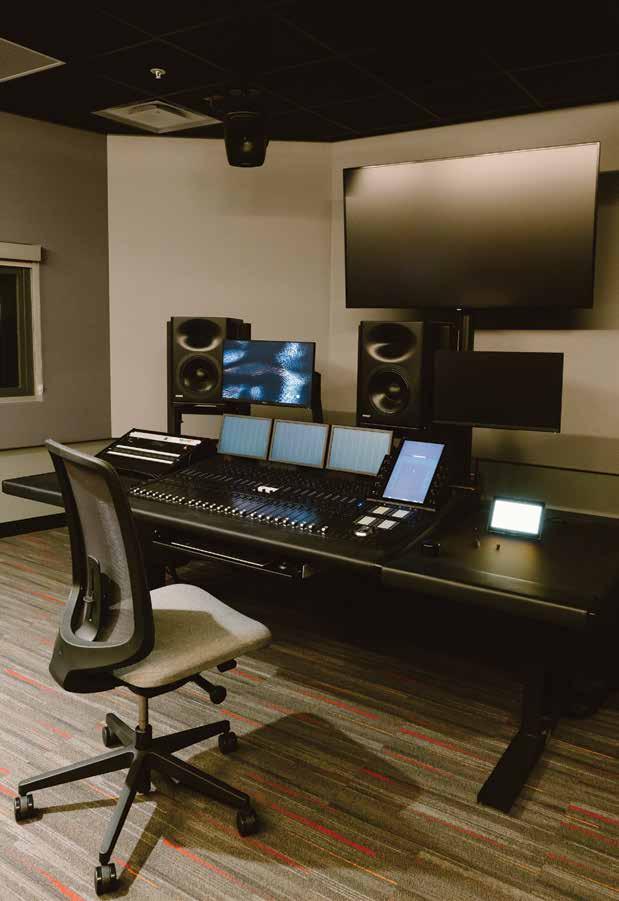
The facility’s award-winning design, which integrates 33,000 square feet of production, learning, and gathering spaces, complements ACM’s suite of best-in-class media hardware and software.
UH West O‘ahu in Kapolei, the only public university on O‘ahu’s leeward side, joined the ACM system in 2013. Students from any of the university’s seven community colleges could attend UH West O‘ahu ACM for their junior and senior years and earn a concentration in creative media as part of a bachelor’s degree in humanities or applied science. While UH Mānoa ACM focuses on traditional filmmaking, the newer UH West O‘ahu ACM incorporates dramatic advances in the production and distribution of media. Coursework encompasses a wide range of emerging digital storytelling mediums, from video games and apps to podcasts and virtual reality.
In its first year, just nine students were enrolled, and they shared a cozy, multipurpose double classroom divided by a movable visual partition. Then, in 2016, the UH West O‘ahu ACM program was promised a quantum leap forward when Governor Ige approved $37 million in legislative funds for a cuttingedge student production center. The result was the Creative Media Facility, the ACM student production facility at UH West O‘ahu, which was completed in 2020. One of the first design-build projects for the University of Hawai‘i, the 33,000-foot facility serves as a physical hub for the ACM System and provides students with the technology, equipment, and space they need to become competitive media professionals.
“Just one look inside and you know not to expect your typical education here,” says Sharla Hanaoka, director for UH West O‘ahu ACM. The structure’s three wings house spaces optimized for today’s digital learner, including a 3,000-square-foot sound stage for shooting films, a 100-seat theater with Dolby Atmos mixing capabilities for playback, Hawai‘i’s only Foley suite, editing suites for post-production, color grading, and sound mixing, and a mill shop to construct original film sets. In the Create(x) Emerging Media Lab, students will experiment with virtual and augmented reality. In the e-sports room, students can build video games and invite players to test their prototypes. “It’s exciting for them to have non-friends play their games and give feedback,” Hanaoka says. The flex-classrooms and computer labs are outfitted with interactive teaching boards, remote learning equipment, and modular furniture that give instructors freedom to shape the learning experience.
At the building’s nexus, a lobby named the Roy and Hilda Takeyama Family Foundation Gathering Space, seating risers sit opposite an elevated 16-by9-foot LED Planar video wall ready to showcase student work, welcome visitors, and host e-sports tournament spectators. There’s also an incubator space for coworking, collaboration, and student- and alumni-run business ventures. Though the Covid-19 pandemic waylaid a complete opening, ACM students will eventually be able to access the facility all day and night, and enjoy a café in the lobby.
それから10年の間にACMは「マノアプログラム」を構築。さらにハワイ 大学ヒロ校、マウイ・コミュニティ・カレッジ、カウアイ・コミュニティ・カレッジな ど他校のクリエイティブ・メディア・プログラムの立ち上げや拡張も支援した。 2013年には、オアフ島リーワード地区唯一の公立大学であるカポレ イのハワイ大学ウエストオアフ校がACMのシステムに参加。これにより、同 大学の7つのコミュニティカレッジの学生も、3年次と4年次にウエストオア フ校のACMに通い、人文科学または応用科学の学位取得ため、クリエイテ ィブメディアの単位を取得できるようになった。マノア校のACMが伝統的 な映画製作に重点を置いているのに対し、ウエストオアフ校の新しいACM は、劇的に進歩する新時代のメディア制作・配信にも対応していて、履修科 目にビデオゲームやアプリ、ポッドキャスト、バーチャルリアリティを組み込 むなど、新しいデジタル・ストーリーテリング・メディアも幅広く扱っている。
初年度の在籍者はわずか9人で、くだけた雰囲気の多目的ホールを 可動式のパーティションで仕切り、教室として使っていたが、2016年にイ ゲ州知事が最先端の学生向け制作センターに3,700万ドルの助成金を 承認したことで、ウエストオアフ校のACMプログラムの規模拡大が約束さ れ、2020年には学生向け制作施設「クリエイティブ・メディア・ファシリテ ィ」が完成した。ハワイ大学初のデザインビルド方式のプロジェクトとして 建設されたおよそ1000坪にもおよぶこの施設は、ACMの物理的な拠点 となり、学生たちがメディア業界で競争力のあるプロになるために必要な 技術、機器、スペースを提供する。
「ひと目見れば、従来とは違う授業が行われていることはおわかりで しょう」とハワイ大学ウエストオアフ校ACMのディレクター、シャーラ・ハナ オカさんは語る。この建物の3つの棟には、最先端のデジタル技術を学ぶた めの80坪強の防音設備付映画撮影スタジオ、ドルビーアトモスのミキシン グ機能を備えた100席のシアター、ハワイ唯一のフォーリー(効果音)スタ ジオ、ポストプロダクションやカラーグレーディング、サウンドミキシングを 行う編集スタジオ、オリジナルの映画セットを製作する工房などがそろって いる。クリエイト(x)・エマージング・メディア・ラボでは、仮想現実や拡張現 実を使った実験を行うことができ、eスポーツルームでは、学生たちが制作 したゲームのプロトタイプを自分が招待したプレイヤーに試してもらうこと ができる。「自分のゲームを友達以外の人にプレイしてもらって意見や感想 を聞くのは、学生たちにとって大きな刺激なんです」とハナオカさんは言う。 フレックスクラスルームとコンピュータラボには、インタラクティブな講義 用ボード、リモート学習用の機材、モジュラー式の什器などがあり、講師は 自由な発想で授業を構築できるようになっている。
建物に付随する「ロイ&ヒルダ・タケヤマ・ファミリー財団ギャザリン グ・スペース」と名付けられたロビーには階段状の客席があり、正面に設置 された約5x3メートルのプラナー製LEDビデオウォールで学生の作品を 展示したり、訪問者を歓迎したり、eスポーツのトーナメントを上映したりし ている。また、コワーキングやコラボレーション、学生や卒業生が運営する ビジネスベンチャーのためのインキュベータースペースもある。コロナの影 響ですべての施設がオープンしているわけではないが、いずれは昼夜を問 わず多彩な施設を利用できるようになり、コーヒーを飲みながらロビーで のひとときをも楽めるようになるだろう。
50 PALM B BUSINESS Creative Media
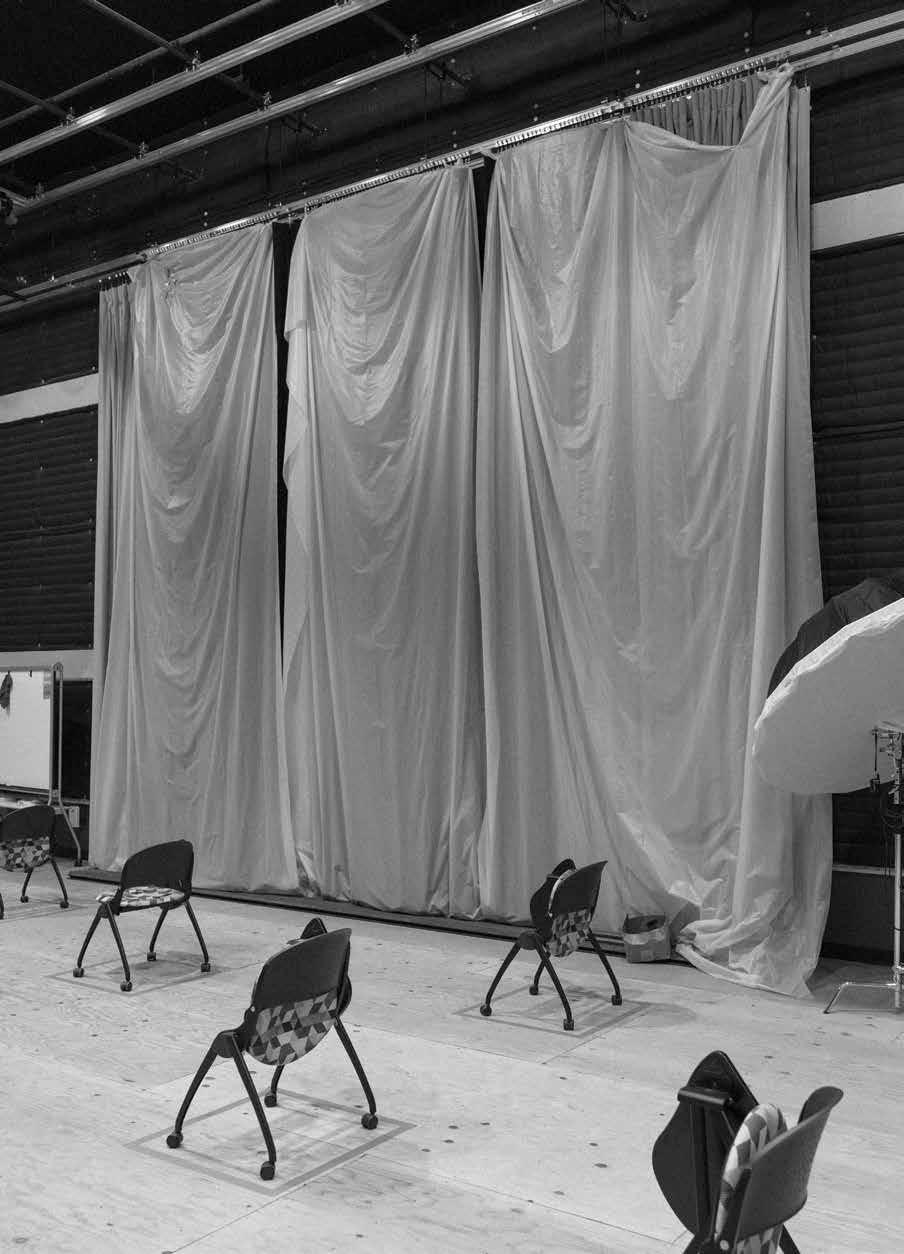
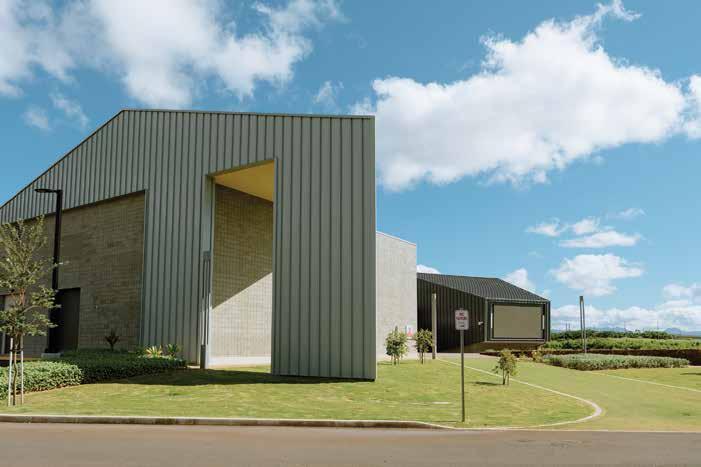
During the project’s research phase, the planning team visited vanguard campuses like University of Southern California, Emerson College, Chapman University, and Google’s YouTube Space.
For the spring 2022 semester, UH West O’ahu ACM counts 260 students on its roster—its largest enrollment yet. The hope is that the Creative Media Facility continues to help Hawai‘i retain local talent by offering a world-class education in the digital arts, and that it turns out graduates with skill sets deep enough to successfully navigate a dynamic and changing field. As the program evolves its digital content curriculum to meet the demands of emerging media, the goal is to see 100 percent of students procure meaningful jobs. “We’re producing a new iteration of graduates by giving them the tools they need to go out in the world, then come back and take over,” Hanaoka says. “In the end, we’re building successorship.”
ハワイ大学ウエストオアフ校のACMに は、2022年春学期生として過去最高の260名が 登録している。クリエイティブ・メディア・ファシリテ ィが今後も世界レベルのデジタルアート教育を提 供していくことで、ハワイの優れた人材の留保に貢 献し、激動する社会で通用するスキルセットを備え た卒業生を輩出することが期待されている。新興メ ディアの需要に合わせてデジタルコンテンツのカリ キュラムを進化させ、すべての学生が有意義な就 職先を獲得できるようにするのが目標だ。 ハナオカさんは言う。「わたしたちは優秀な 人材を輩出する仕組みをつくろうとしているので す。ここで得た知識や技術を駆使して世界で活躍 し、やがて戻ってきて、次の世代を育てる。つまり、 後継者を育成するシステムを確立したいのです」
52 PALM
BUSINESS Creative Media B
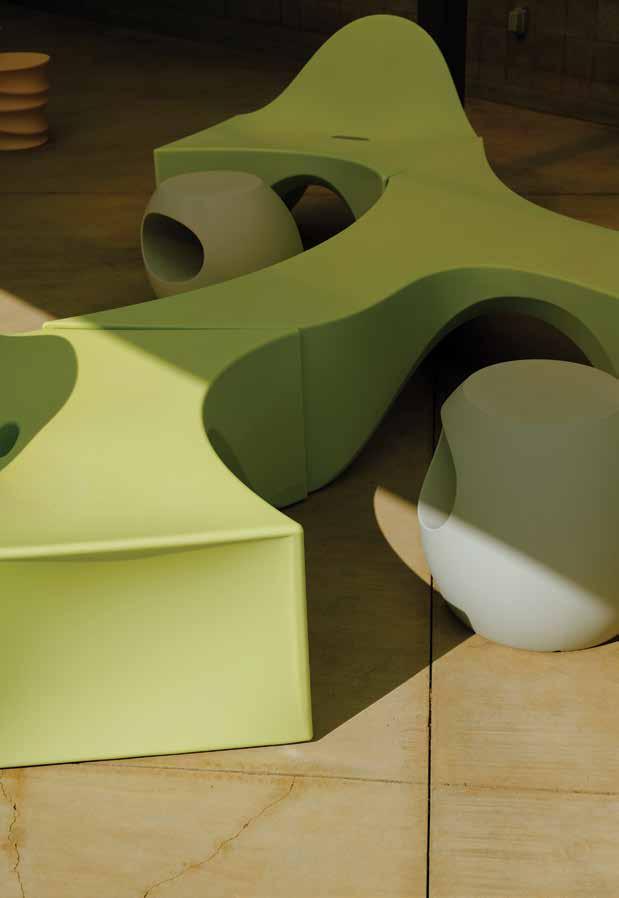 According to ACM Director Sharla Hanaoka, the facility was designed to promote “as much dreaming as possible.”
According to ACM Director Sharla Hanaoka, the facility was designed to promote “as much dreaming as possible.”
A sense
CUL TU RE of place that
文化 PALM C 54
fosters the human spirit
55 C PALM
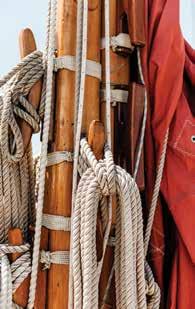
Beyond Borders
Text by Rae Sojot
Images by John Bilderback, John Hook, and courtesy of Polynesian Voyaging Society
The Polynesian Voyaging Society prepares for a multi-leg journey to inspire communities throughout the Pacific to rise to the challenges of a rapidly changing world.

56 PALM C CULTURE Moananuiākea あらゆる境界を超えて 文 = ローエ・ソジョット 写真
ポリネシアン航海協会(PVS)提供
= ジョン・ビルダーバック、ジョン・フック、

Another bold voyage is on the horizon for Hōkūle‘a and Hikianalia as the famed canoes set out to unite the Pacific.
太平洋の島々をひとつにするため、かのホクレア号とヒキアナリア 号が今いちど果敢な旅に出ようとしています。
Translation by Mikiko Shirakura
翻訳 = 白倉三紀子
유명한 카누가 태평양을 하나로 묶기 위해 출발함
에 따라 호쿠레샤를 향한 또 다른 대담한 항해가 눈
앞에 펼쳐지고 있습니다.
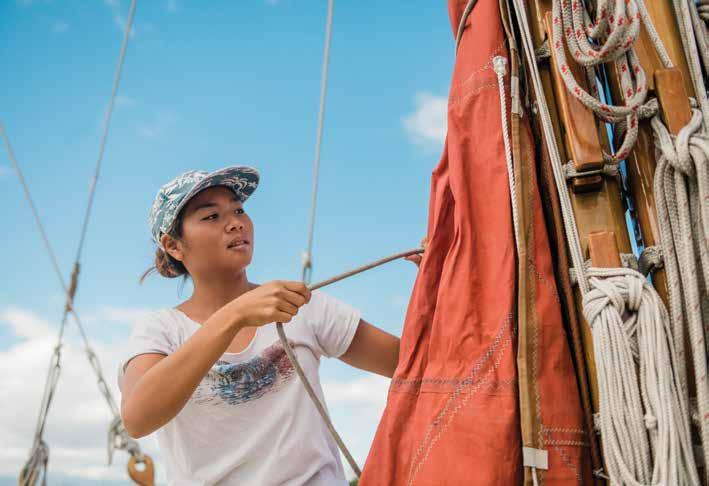
In Spring 2023, the Polynesian Voyaging Society will launch one of its most extensive campaigns yet: a 41,000-mile, 42-month circumnavigation of the Pacific. Coined the Moananuiākea Voyage, sister canoes Hōkūle‘a and Hikianalia will sail the ancient sea roads, visiting 46 countries and archipelagoes, 100 Indigenous territories, and 345 ports along the way. The four-year journey is a monumental undertaking, but a crucial one— an effort to reconnect with other Indigenous communities and build relationships with those not yet visited. Here, three PVS members share personal voyaging stories from aboard Hōkūle‘a, reflecting on the lessons learned and the relationships forged along the way.
2023年春、ポリネシア航海協会(PVS)は、航海距離約6万6,000キロ、42か 月間にわたる、これまでで最大級の環太平洋航海プロジェクトを開始する。
「モアナヌイアケア・ボヤージュ(MoananuiākeaVoyage)」と名付けられた このプロジェクトでは、姉妹カヌーであるホクレア号(Hōkūleʻa)とヒキアナリ ア号(Hikianalia)が古代海路を航海し、46の国や群島、100の先住民族の領 土、345の港を訪れる。4年にもわたるこの壮大な旅は、他の先住民コミュニテ ィとのつながりを深め、まだ訪れていないコミュニティとの関係を築くための重 要な取り組みとなる。
今回紹介するのは、ホクレア号での航海から得た教訓、そこで築いた関 係性など、PVSの3人のメンバーが語るそれぞれの航海の物語である。
PALM 58 C CULTURE Moananuiākea
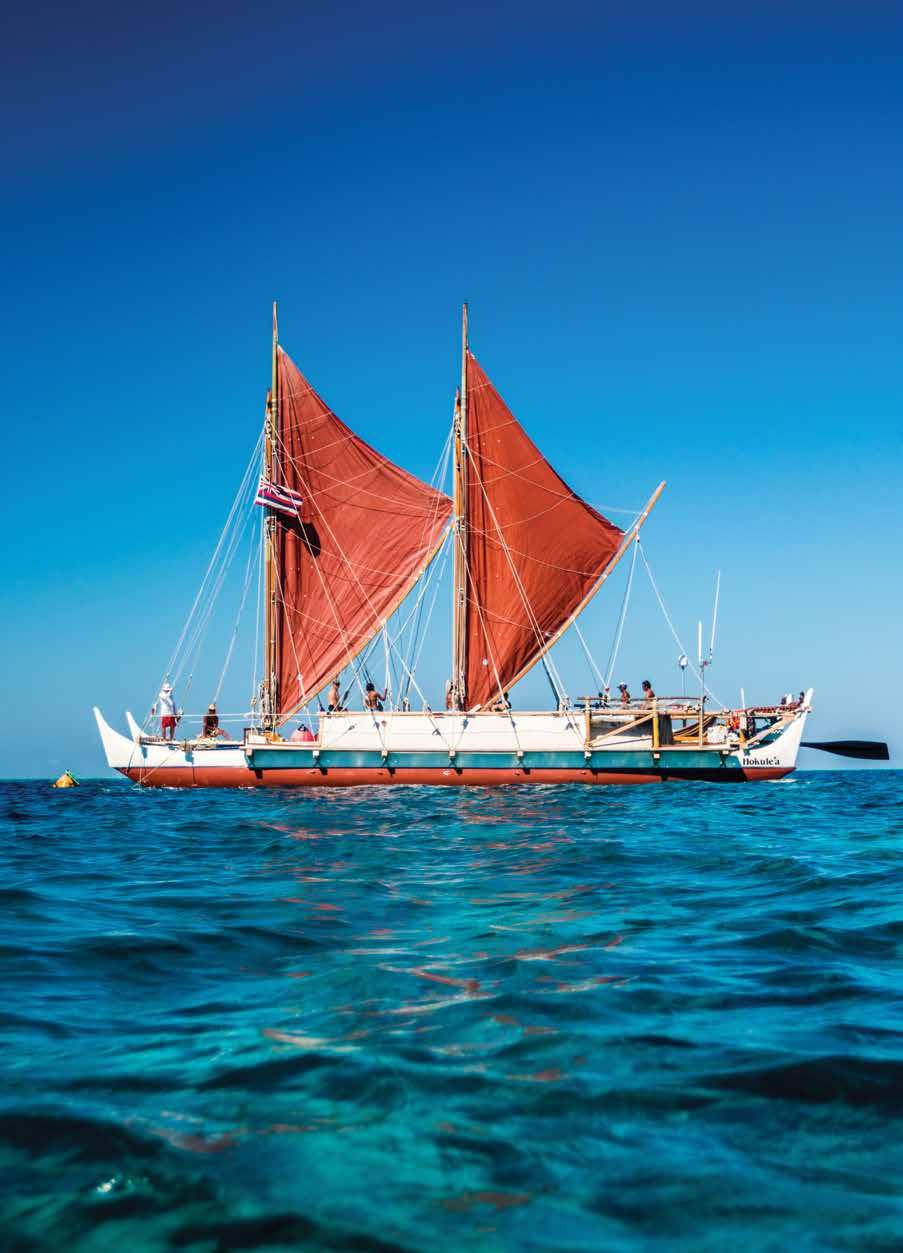
THE YOUNG NAVIGATOR
For 24-year-old Kai Hoshijo, teamwork really does make the dream work. In 2021, she and four other young crew members from PVS were selected to sail Hōkūle‘a to Nihoa, an island in the uninhabited Northwestern Hawaiian Islands. The journey—a relatively smooth two-day stretch across 280 miles— was known for one key navigational challenge. “The difficulty,” Hoshijo says, “is that Nihoa is so small.”
The opportunity to test their burgeoning voyaging skills without the use of modern navigational tools was both thrilling and nerve-racking, Hoshijo admits. Although the journey would include senior society members, the young crew members represented the organization’s next vanguard of navigators, and so the pressure was on. They spent hours poring over maps to create a sail plan, followed by hours of fine-tuning it. Once at sea, they rotated stations—from maintaining the steering blade and keeping the mark from the back corner, to scanning for cues from sea and sky. Sailing into the night, the young crew fell into a natural, easy rhythm. Lacking watches, they measured time by the stars. “We kept switching off every 15 minutes or so,” Hoshijo says. “We just got into a flow.”
Hoshijo and the others had pinned their hopes on the sunrise. Because Nihoa, measuring less than 1 square kilometer, is situated northwest of Hawai‘i, timing was critical. “The sun will rise in the east and then shine on the island,” Hoshijo explains, noting that the window, however, is small. “If you don’t have that, you might just sail past it and then you’re lost.”
But as night slowly crested into dawn, only a vast ocean surrounded them. Doubt crept in. Do we keep our line? Do we switch our line? None of them had ever spotted an island on their own before. “It was like, ‘What are we looking for?’” Hoshijo says.
Two more hours had passed when suddenly crewmate Nālamakū Ahsing spotted an irregular blur fixed on the horizon. Some 35 miles away, a small triangle had appeared. “Like a cloud that didn’t move,” Hoshijo remembers. It was Nihoa. A torrent of emotion washed over Hoshijo, first relief then sheer elation at what they had accomplished. On deck, the crew exploded into joyous celebration. “It was very powerful for us to have our teachers there to see how we came together and supported each other through the process,” Hoshijo says. “I think it was powerful for them too.”
That moment left an indelible impression on Hoshijo and crystallized for her the myriad lessons Hokūlē‘a offers: the importance of generational knowledge, the power of commitment and hard work, the ability to trust oneself and others. “To have five young people laulima (work together) to make something happen,” she says, “it’s more than just sailing. It’s values.”
若き航海士
24歳のカイ・ホシジョウさんにとって、夢の実現に欠かせないのがチームワ ークだ。2021年、ホシジョウさんとPVSの若手クルー4名は、ホクレア号で 北西ハワイ諸島の無人島ニホアに向かうメンバーに抜擢された。2日間で 450キロを航海するという比較的容易な旅ではあったが、ひとつ難関があ ることが分かっていた。「その難関とは、ニホアが非常に小さい島だという ことです」とホシジョウさんは語る。
近代的な航海道具を使わず、自分たちの航海技術を試す機会となっ たこの旅は、スリリングであると同時に緊張を伴うものだった。先輩クルー も参加することになっていたものの、選ばれた若いクルーたちは、次世代の 航海士を代表するとあって、大きなプレッシャーを感じていた。何時間もか けて海図を見ながら計画を立て、さらに何時間もかけて微調整を行った。
出航後は、ステアリングブレードの保持や後方からの航路の維持、海や空 からヒントを読み取るなど、持ち場をローテーションで変えていった。夜に なると、若いクルーたちはゆったりとした自然のリズムに身を委ねた。時計 を持たない彼らは、星を見て時間を測った。「15分おきぐらいに明かりを消 して、ひたすら集中していました」
ホシジョウさんと他のクルーたちは、朝日に望みを託していた。ニホ アは、ハワイ島の北西に位置する1平方キロメートル足らずの小さな島な ので、タイミングが極めて重要だった。「太陽が東から昇ると、島が照らし出 されます」とホシジョウさんは説明する。ただし、それを見つけられるチャン スはとても小さい。「そのヒントがなければ、ただ通り過ぎて、見失ってしま う恐れがあります」
夜が明けて、空が徐々に白んでくる。だが、彼らの周りにあるのは広 大な海のみ。頭に疑念がよぎる。進路を維持するべきか。それとも変える べきか。メンバーの中の誰ひとり、これまでに自力で島を発見した経験が なかった。「何を探せばいいんだろう、という感じでした」とホシジョウさん は思い返す。
さらに2時間が経過した頃、突然、クルーのひとり、ナーラマク・アシ ングさんが水平線上に、不規則にモヤモヤとしたものがあるのを発見し た。56キロほど離れたところに、小さな三角形が姿を現したのだ。「それ は、動かない雲のように見えました」。その三角形がニホアだった。大きな 安堵、そして達成感と高揚感。ホシジョウさんの中に感情の波が押し寄せ た。甲板では、他のクルーたちも喜びを爆発させていた。「私たちが協力し 合い、支え合いながら任務を成し遂げる姿を先生方に見ていただけたこと は、とても嬉しく感動的でした」とホシジョウさん。「先生方も、とても喜ん でくださったと思います」
あの瞬間はホシジョウさんに強い印象を残し、代々受け継がれている知 識の大切さ、コミットメントと懸命な努力がもたらすパワー、自分と他人を 信じる力など、ホクレア号はいつまでも心に残る多くの教訓をもたらした。 彼女は言う。「5人の若者がラウリマ(協力)して何かを成し遂げる。それは、 単にセーリングという一言では片付けられない、大きな価値をもたらす経 験だったと思います」
60 C CULTURE Moananuiākea PALM
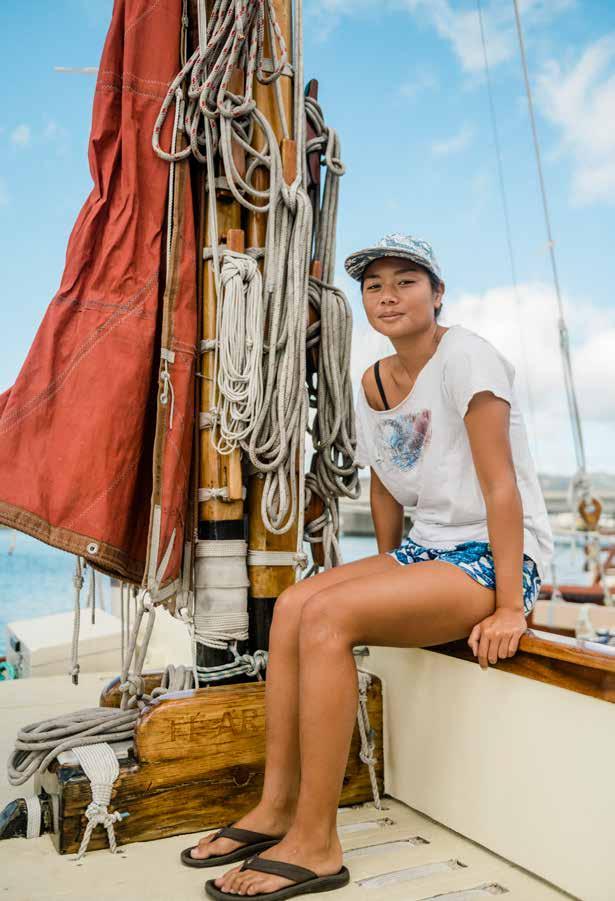
For Kai Hoshijo, wayfinding by traditional navigational methods is about more than successfully getting from point A to point B—it’s about teamwork and perpetuating generational knowledge and values.
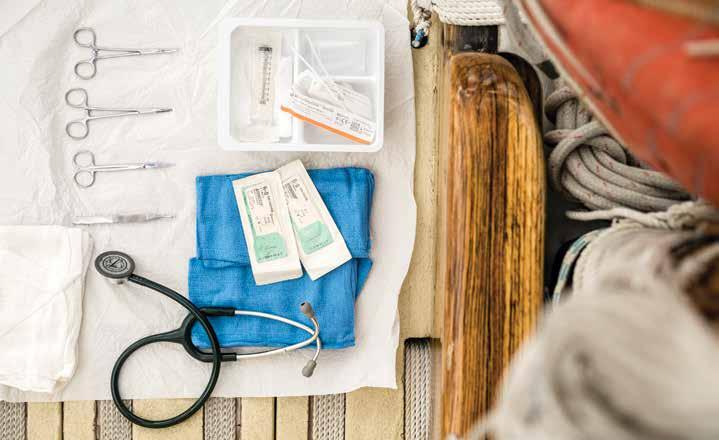
At sea, triage, treatment, and recovery all happen on deck without the accoutrements of a fully staffed and supplied ER center.
THE GOOD DOCTOR
Kelly Tam Sing remembers the palpable excitement surrounding Hōkūle‘a’s maiden voyage from Hawai‘i to Tahiti. It was 1976, and Tam Sing was five years old. “Everybody was talking about Hōkūle‘a,” he recalls. “It was a huge deal.” For the young Tam Sing, who loved the ocean, Hōkūle‘a represented the stuff of dreams and adventure at sea.
Nearly five decades later, Tam Sing now lives out a small slice of that childhood dream as one of Polynesian Voyaging Society’s volunteer medical officers. Tasked with handling any medical concerns that arise while voyaging, Tam Sing notes that his background and skill as an emergency medicine doctor comes in handy, saying, “You have to be able to take care of anything that comes along.” At sea, triage, treatment, and recovery all happen on deck without the accoutrements of a fully staffed and supplied ER center. The ability to think on one’s feet and do more with less is key. “You make do with what you have,” Tam Sing says, referencing the three cooler chests lashed to the deck. Inside, medical supplies are packed tight: gear for suturing wounds and abscesses, IVs for fluid resuscitation, chemical ice packs, and specialized medicine for pain and sedation.
優れた船医
ケリー・タム・シンさんは、ホクレア号がハワイからタヒチまでの処女航海を 成功させた時の興奮を今も忘れていない。1976年、タム・シンさんがまだ5 歳だった当時のことを振り返り、こう語る。「あの時は、誰もがホクレア号の 話をしていました。とてつもなく大きな偉業でしたからね」。海を愛する幼い 日のタム・シンさんにとって、ホクレア号はまさに夢と冒険の象徴だった。
それから50年近く経った今、タム・シンさんはポリネシア航海協会の ボランティア船医として、幼い頃の夢の一部を実現している。航海中に起き るさまざまな医学的な問題に対応するという任務では、救急医としての自 身の経歴とスキルが役立っているという。「どんなことにも対処しなければ なりません」。海上には、人材や医療用物資の揃う救急医療センターのよう な施設はないため、トリアージから治療、回復まで、すべてが甲板の上で行 われる。素早く決断し、少ない労力で効率よく多くのことをこなせるかどう かが鍵となる。甲板に固定された3つのクーラーボックスを指差しながら、 タム・シンさんは言う。「ここにあるもので、工夫して対応するしかありませ ん」。ボックスの中には、傷や膿瘍を縫合するための器具、輸液蘇生のため の点滴、化学氷嚢、鎮痛剤や鎮静剤などがぎっしりと詰まっている。 最も多い症状は、船酔い、日焼け、便秘である。「カヌーにはプライバ シーがないので、恥ずかしさから、便秘になる人が多いんです」。とはいえ、 航海の経験を積めば積むほど、病気になることも減るそうだ。
62 PALM
C CULTURE Moananuiākea

The most common ailments include seasickness, sunburn, and constipation. “Constipation is an issue because there is no privacy on the canoe,” Tam Sing explains. “Everyone gets shy.” Thankfully, Tam Sing adds, the more experienced the voyagers, the fewer hang-ups along the way.
Although practicing expedition medicine appeals to Tam Sing’s love for travel and adventure, his work with PVS ultimately strikes a deeper, more personal chord. Prior to joining the organization in 2007, Tam Sing, who is of Hawaiian descent, felt detached from his Native identity. PVS gave him a bridge and a meaningful way to contribute to his community. “I feel more connected to my culture because I am more connected to my community,” Tam Sing says. “I can give my services as a way to honor my ancestors.”
As preparations for the Moananuiākea Voyage get underway, Tam Sing’s perennial focus is the health and safety of the crew. “I’m always looking to preempt and prevent any kind of medical disaster,” he says. He humbly waves off any potential hero status that accompanies his role. Instead, Tam Sing notes this positive paradox: a successful journey is one where his expertise is never needed.
THE MASTER STUDENT
Nainoa Thompson, exemplary Native Hawaiian navigator and PVS president, has always been drawn to the water. As a child the ocean was his refuge; as a man it has become the fulcrum of his life’s work with Hōkūle‘a. But, when asked if he considers himself a “master navigator,” he is quick to disclaim the title. “Oh, I never say that,” he says, with visible embarrassment. “I’m a student, but thank you.” His words are sincere.
Growing up, Thompson struggled in school. His saving grace was an instinctual impulse to search for a teacher. “For me, it’s always been that if you need to learn something,” he says, “go find the person who knows.” During Hōkūle‘a’s nascent years in the ’70s, this approach would be the linchpin in first recovering and then relearning ancient voyaging traditions. “We were trying to do stuff that no one was doing anymore, but we had no manual or blueprint to follow,” he recalls. So he did what he’d always done before: He sought out teachers.
船医として航海に同行することは、旅と冒険を愛するタム・シンさ んに満足感を与えてくれると同時に、PVSでの活動は、彼の心の琴線に 深く触れるものでもあるという。ハワイ先住民の血を引くタム・シンさん は、2007年にPVSに参加するまでは、先住民としてのアイデンティティか ら切り離されていると感じていた。PVSは、そんな彼に先住民コミュニテ ィとのつながりを取り戻すきっかけをもたらし、貢献するための有意義な 方法を与えたのだ。タム・シンさんは言う。「自分のコミュニティとの絆を深 めることで、自分の文化とのつながりをより強く感じられるようになりまし た。医療サービスの提供という行為が、先祖に敬意を払うひとつの方法と なっています」
モアナヌイアケア・ボヤージュの準備が進む中、タム・シンさんがいつ も注視しているのは、クルーの健康と安全だ。「あらゆる医療上の問題を想 定し、事前に防げるよう常に目を配っています」と彼は言う。医師というヒ ーロー的要素を秘めたポジションにいるが、彼はあくまでも謙虚である。彼 の中には「自分の専門知識が一度も必要とされないことが、航海の成功に つながる」というポジティブな逆説があるのである。
熟練した生徒
ハワイ先住民の模範的な航海士であり、PVS会長でもあるナイノア・トン プソンさんは、ずっと海に惹かれてきた。子供のころは海が彼の隠れ家であ り、大人になってからは、ホクレアを中心としたライフワークの拠点となっ た。そんな彼だが、自分のことをマスター・ナビゲーター(熟練航海士)だと 思うかと問われると、照れくさそうに「そんなふうには思ったことはありませ ん」と否定する。「そんなふうに言っていただいて、ありがとうございます。で も、私はまだ生徒です」。その言葉には誠意がある。 幼い頃は学校で苦労していたというトンプソンさん。そんな彼を救 ったのは、先生を探す、という本能的なひらめきだった。「私はこれまでずっ と、何か学びたいことがあったら、それに詳しい先生を探す、というやり方で やって来ました」。70年代のホクレアの創成期にも、この方法で、古代の伝 統航海術を復活させ、学び直した。彼はこう振り返る。「私たちがやろうとし ていたのは、すでに廃れて誰もやっていなかったことだったので、マニュアル
64 PALM C CULTURE Moananuiākea

prepares for a multi-leg journey to inspire communities throughout the Pacific to rise to the challenges of a rapidly changing world
The Polynesian Voyaging Society
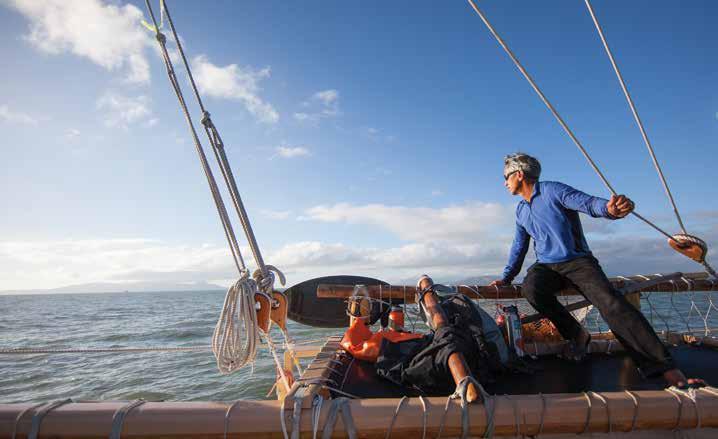
Early on in his journey as a navigator, PVS President Nainoa Thompson was quick to seek out mentors in his effort to revive ancient voyaging traditions.
Today, Thompson credits his own navigational success to a storied list of individuals who helped to revitalize the art of traditional wayfinding: PVS founder Herb Kane; big-wave surfer Eddie Aikau; his father, Myron “Pinky” Thompson; and Micronesian master navigator Mau Piailug. “The Hōkūle‘a began as a kind of cultural renaissance recovering traditions,” Thompson explains. “Today it’s evolved into protecting what we learn and honoring our teachers.” That list of teachers continues to grow.
Now in his late sixties, Thompson shares that he sometimes contemplates a solo voyage from Tahiti to Hawai‘i, a feat that his close circle considers a crazy endeavor. The voyage is challenging enough for a full crew, but to sail Kealaikahiki, the ancient sea road to Tahiti, on one’s own? Thompson, a private man, offers a simple response: He wouldn’t be alone. “My crew would be my father,” he answers, “it would be Mau and Eddie too … We carry our teachers with us.”
も青写真もありませんでした」。そこで彼は、いつものやり方に従うことにし た。先生を探したのだ。
トンプソンさんは、自らの航海の成功は、伝統的なポリネシア航法を 復活させるのを支援してくれた多くの先生たちのおかげだと考えている。例 えば、PVSの創設者ハーブ・カーネ、ビッグ・ウェーブ・サーファーのエディ・ アイカウ、自身の父マイロン・ピンキー・トンプソン、そしてミクロネシアの熟 練航海士マウ・ピアイルックなどだ。「ホクレア号は、伝統を復活させるため の文化的ルネッサンスのような活動としてスタートしました。それが今や、 私たちが学んだことを守り、師を称えるためのプロジェクトへと発展しまし た」。先生のリストは増え続けている。
60代後半になった今、トンプソンさんは時折、タヒチからハワイへの 単独航海に思いを馳せているが、親しい仲間たちからは、クレイジーな挑 戦だと言われているらしい。タヒチへの古代海路であるケアライカヒキは、 十分な人数のクルーが揃っていても難しいとされているのに、それをひとり で航海するなんて……。自分のことをあまり語らないトンプソンさんの答え は「ひとりではありませんから」と至ってシンプルだ。「私にはクルーがいま す。父やマウ。そしてエディも。そばにはいつも、我々の師である先人たちが ついていてくれますから」
66 C CULTURE Moananuiākea
PALM
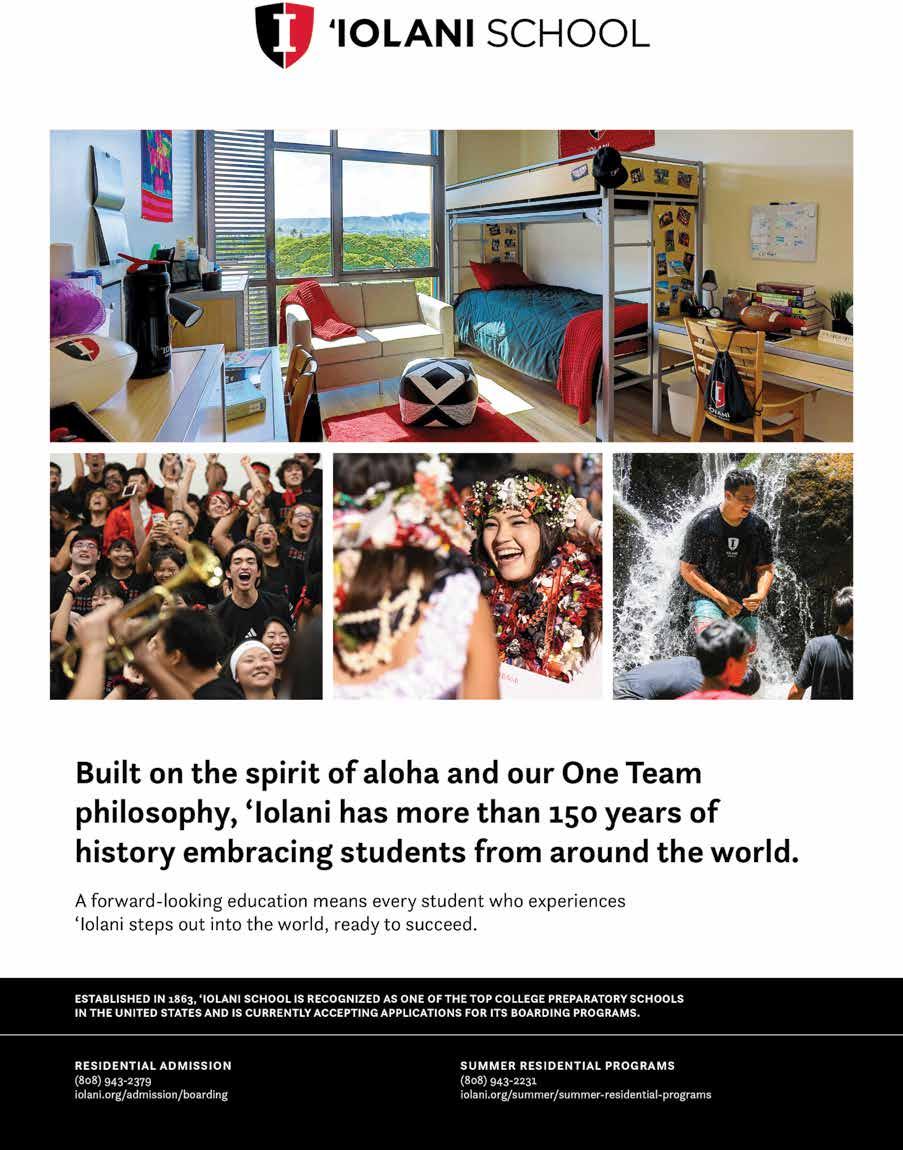
DE SI GN
The
D PALM デザイン
flourishing of
facilities creative 69 PALM D
Building for Tomorrow
未来の建築
Text and images by Ijfke Ridgley
70 PALM D DESIGN Living Building Challenge
文と写真 = アイフク・リッジリー

An architect’s utopian family home in Pālolo Valley rises to a unique challenge.
Tパロロヴァレーには、ある建築家が理想を追求 して建てた「ユートピア住宅」があります。彼が 家族と暮らすこの家は今、ユニークな課題に挑 戦しています。

ucked deep in the recesses of Pālolo Valley, where clouds hang over green creases of jungle infringing upon twisted streets, sits a house hidden high in the foliage. To reach it, you must enter the property at the bottom of a steep hill and climb a long flight of stone pavers through ferns and heliconia. Gazing up from the end of the path at reclaimed redwood dripping with flora—Spanish moss hanging in front of windows, acting as natural sunscreens—it is hard to tell where house ends and forest begins. That is exactly the point
When architect Aaron Ackerman bought this plot in 2011, his wife, Jessica, was pregnant with their first child, and they ambitiously set out to build a green home, a living space in sync with its environment. They fixed up and moved into a humble structure on the property and spent the next few years studying the land: the vegetation, topography, and where the water went when it rained. It wasn’t until four years later that they started construction on the home they imagined, using this data to inform how and where they built.
The site, like any structure evocative of a treehouse, is a child’s dream. The couple’s three children, who are aptly named for the three elements found in every woody plant—Xylem, Cambium, and Phloem—hang out in nets high in the trees. The home has a zipline winch system that looks like a prop out of Hook, featuring a repurposed WWII Marine cauldron from Maui found buried on the property as a carrying container, which Ackerman installed to haul a 500-pound stone birthing tub up to the house. Of the house’s
垂れ込める雲の下に緑深いジャングルが広がるパ ロロヴァレー。生い茂る木々がすぐ横に迫る曲がり くねった道を進むと、森のなかにひっそりと佇む一 軒の家がある。そこにたどり着くには、急な坂の下か ら敷地に入り、シダやヘリコニアをかき分けながら 長い石畳の道を登っていかなければない。行き止ま りまでたどり着いたら、目の前にレッドウッドの再生 材でできた建物がある。窓の外に垂れ下がるスパニ ッシュモスは天然のカーテン。家全体が植物に覆わ れ、どこまでが建物でどこからが森なのか、一見した だけではよくわらからない。まさにそれが、この家の 最大の特徴だ。
建築家であるアーロン・アッカーマンさんが 2011年にこの土地を購入したとき、妻のジェシカさ んは第一子を妊娠中だった。夫妻は環境と調和した 生活空間「グリーンホーム」の建設に意欲的に取り 組んでいく。まずはもとからあった粗末な小屋を修繕 して住み、植生や地形、雨が降ったときの水の流れな ど、土地の研究に数年を費やした。そして4年後、そ の研究データをもとに建物の立地や仕様を決め、思 い描いてきた理想の家の建設に着手した。 木の上の家(ツリーハウス)を彷彿とさせるこ の家は、子どもにとっては夢の空間だ。アッカーマン 夫妻にはザイレム、キャムビアム、フロウエムという 名前の3人の子どもがいる。樹木を構成する3つの 要素「木部」「形成層」「師部」にちなんでつけた名前 だ。高い木々のあいだに張ったネットの上で遊ぶ子 どもたちにぴったりだ。映画『フック』に出てくるよう なジップラインもある。荷物を乗せるコンテナは、敷 地内に埋まっていた大釜で、第二次世界大戦中、マ ウイの海兵隊が使っていたもの。ジップラインは、重 さ約230kgもある水中出産用の石の浴槽を運ぶた めにアッカーマンさんが設置した。家の建設に使わ れた資材は75%が廃品、あるいは再利用されたも のだ。
72 팔롤로 계곡에 있는 한 건축가의 유토피아 패밀리홈이 독특한 도전을 받고 있습니다. D DESIGN Living Building Challenge
翻訳
Translation by Mikiko Shirakura
= 白倉三紀子


“The house is an experience,” says architect and homeowner Aaron Ackerman. “It offers perspective, sanctuary, mystery, and risk. As you are experiencing the house, it draws you around the next corner. You never really see the whole thing.”
building materials, 75 percent are salvaged or reused.
Ackerman has worked as an architect and sustainability facilitator at Bowers and Kubota for going on 18 years. This might be the firm’s most ambitious project yet. Its name is Haleola‘ili‘āinapono, an amalgamation of the Hawaiian ideas of a living house (hale ola) managed by an individual for the betterment of the community (‘ili ‘āina) in a morally conscious way (pono).
The purpose of this house is to raise the bar for what people consider an environmentally friendly building. “How we live has an impact, and we spend, on average, 90 percent of our time indoors,” he says. “That means that we are very impacted by the buildings that we occupy.” There have been LEED-certified developments in Hawai‘i before, but Ackerman built his house based on the much more stringent set of standards outlined in the Living Building Challenge.
アッカーマンさんは、建設会社バウアーズ・ アンド・クボタ社で建築家兼サステイナビリティ ファシリテーターとして勤務して18年目。この家 は同社にとっても、もっとも野心的なプロジェク トだ。プロジェクト名は「ハレオラ・イリ・アイナポノ (Haleolaʻiliʻāinapono)」。ハワイ語で「個人がコ ミュニティ(イリ・アイナ)の向上のために、良心的に (ポノ)管理する家(ハレ・オラ)」を意味する。 この家の目的は「環境にやさしい建物」の基 準を引き上げることだ。アッカーマンさんは語る。 「暮らし方は人に影響を与えます。私たちは平均し て1日の9割を室内で過ごしています。つまり、自分た ちが暮らす建物から大きな影響を受けているので す」。これまでにもハワイにLEED認証を受けた建物 はあったが、アッカーマンさんがこの家を建てるとき に用いた基準は、それよりもさらに厳格な 「リビング・ビルディング・チャレンジ」という建築 基準だった。
20項目の条件で構成されるこの基準はイン ターナショナル・リビング・フューチャー・インステ
74 D PALM DESIGN Living Building Challenge
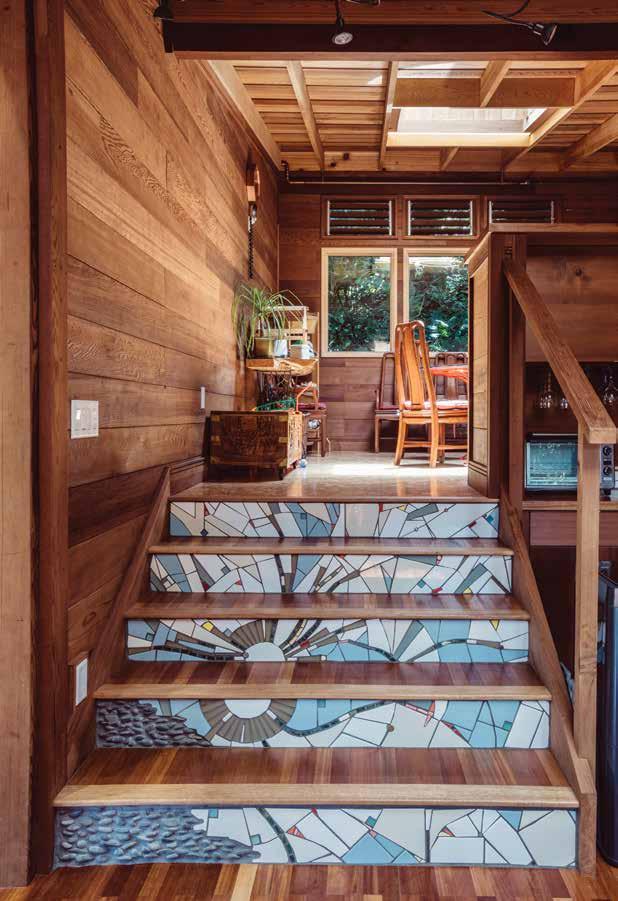
“How we live has an impact, and we spend, on average, 90 percent of our time indoors,” Ackerman says. “That means that we are very impacted by the buildings that we occupy.”
Created by the International Living Future Institute, the Living Building Challenge consists of 20 imperatives a building must fulfill to receive Living Building certification. The criteria are challenging, including sourcing the majority of its materials locally, generating all of the building’s energy from renewable resources, and using rain catchment for all its water, with all wastewater and stormwater reused for urban agriculture or groundwater recharge. In short, a building that passes this test aims to do more than just save some energy—it aims to have a net-positive impact, giving back more to the land than it takes.
While the home is well equipped with state-of-the-art appliances and devices, the project’s real innovation is its symbiotic relationship with nature. The roof is vegetated with laua‘e ferns to absorb stormwater and keep the house cool. Wastewater from the toilets and kitchen sink is treated aerobically and then used for subsurface irrigation of nonedible plants, including the a‘e tree (Hawaiian soap berry), whose berries can be used as a laundry detergent. Greywater is stored under the house for future use after any heat it retains is extracted to heat new water. Collected rainwater is used for everything from drinking water and showers to irrigation for the more than 25 varieties of fruit trees on the property, including lychee, macadamia nut, coffee, and mango.
Some of the parameters of the Living Building Challenge are harder to measure than others. To Ackerman, it’s these qualitative imperatives that are the most important. Biophilia, for example, is the innate human tendency to seek connections with nature; to meet the Living Building Challenge’s biophilic design imperatives, he employed natural ventilation and biomorphic forms to echo the surrounding environment.
“The house is an experience,” he says. “It offers perspective, sanctuary, mystery, and risk. As you are experiencing the house, it draws you around the next corner. You never really see the whole thing.”
After years of work by the Bowers and Kubota team and with assistance from donors and partners, the house was completed at the end of 2019. The team is now working to finance the last phase of the project: a solar structure that will generate enough renewable energy to support the property on an annual basis and offer enough battery energy storage to support up to a week of refrigeration in the event of a power disturbance. The structure will double as a rainwater catchment system and carport, and Ackerman hopes to have it installed and operational by mid-2023.
If, after its performance period, the project passes Living Building certification, it will be the first residence of its kind in Hawai‘i. (The Energy Lab at Hawai‘i Preparatory Academy is a certified Living
ィテュートが策定したもので、この条件を満たさなければリビング・ビルディン グ認証を取得できない。たとえば、資材の大部分を現地調達すること、建物で 使用するエネルギーはすべて再生可能資源でまかなうこと、水はすべて雨水 を利用し、廃水や雨水はすべて都市農業に再利用するか地下水となるよう地 面に浸透させることなど、基準をクリアするのは簡単ではない。つまり、この基 準をクリアした建物は、ただ省エネというだけではなく、使う以上のものを還元 し、環境に「ネットポジティブ」な影響をもたらすことを目的としている。 「ハレオラ・イリ・アイナポノ」は最先端の家電やデバイスを完備してい るが、このプロジェクトが真に革新的なのは、自然と共生している点だ。屋内を 涼しく保つために、屋根には雨水を吸収するラウアエというシダが植えられて いる。トイレやキッチンのシンクからの排水は酸素を必要とする微生物を使っ て処理された後、アエ・ツリー(果実が洗剤として使えるハワイのソープベリー) のように非食用植物の地下灌漑に利用される。飲用には適さないが人体に影 響はない中水は、新しい水を温めるのに熱を利用したあと、再利用するために 家の下に貯めておく。集めた雨水は、飲料水やシャワーはもちろん、敷地内のラ イチ、マカデミアナッツ、コーヒー、マンゴーなど25種以上の果樹の灌漑など、 あらゆる用途に使われる。
リビング・ビルディング・チャレンジの条件には測定が困難なものもあ る。アッカーマンさんは、こうしたクオリティ的な側面こそがいちばん重要だと 考えているそうだ。たとえば、生まれつき人間が持っている、自然とのつながり を求める性質「バイオフィリア」。リビング・ビルディング・チャレンジでは必須の この「バイオフィリア設計」の条件を満たすため、アッカーマンさんは自然換気 と有機的なフォルムを取り入れて周囲の環境との調和を図った。「この家はひ とつの体験です。この家を通じて、新しい視点を得て、安らぎや神秘と対峙し、 危機感を感じてほしいのです。その体験は次々に新たな体験へとあなたを導き ます。全体を完全に把握することはなかなかできません」
バウアーズ・アンド・クボタ社のチームが何年もかけて取り組んだこの家 は、多くの寄付や支援を受けながら2019年末に完成した。チームは現在、プロ ジェクトの最終段階であるソーラーシステム導入のための資金調達に奔走し ている。年間を通してこの家を維持していくのに十分な再生可能エネルギーを 生み出し、停電の際にも最大1週間は冷蔵機能をたもてるだけの電力を貯めら れるソーラーシステムだ。アッカーマンさんは、雨水の貯水と車庫も兼ねたこの システムを2023年半ばまでに設置し、稼働させたいそうだ。 一年間のパフォーマンス期間を無事に終えてリビング・ビルディング認 定を受けられれば、「ハレオラ・イリ・アイナポノ」はハワイ初のリビング・ビルデ ィング認定住宅となる(ハワイ島にある私立校ハワイ・プレパラトリー・アカデ ミーのエネルギーラボは、すでにリビング・ビルディングの認定を受けている)。 こうした住宅は、汚水槽による環境汚染、水不足、建設廃棄物用埋立地の不足 など、ハワイが抱える環境問題へのひとつの答えとなるだけでなく、より高いレ ベルで地球と調和する暮らし方へとわたしたちを導いてくれるのだ。
76 B PALM DESIGN Living Building Challenge
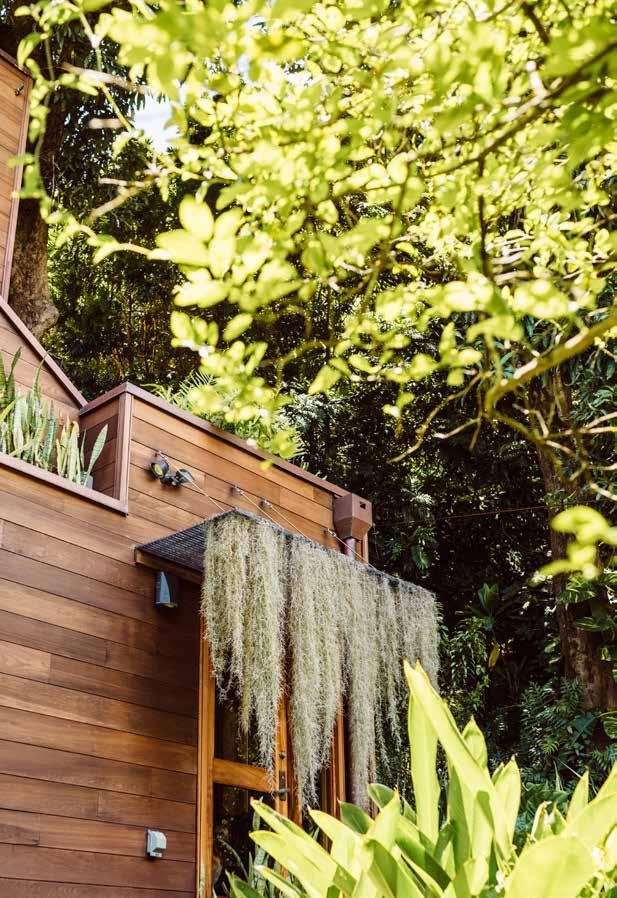
While the home is well equipped with state-of-the-art appliances and devices, the project’s real innovation is its symbiotic relationship with nature.
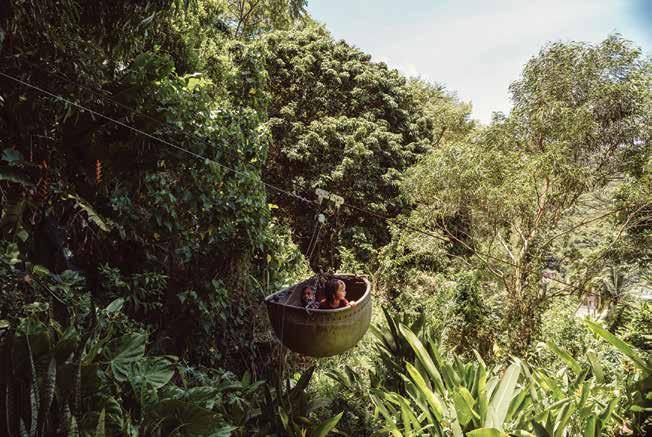
A certified Living Building aims to do more than just save energy—it aims to have a net-positive impact, giving back more to the land than it takes.
Building.) Homes like these are not only an answer to local environmental issues such as cesspool pollution, freshwater shortages, and declining landfill capacity from construction waste, but they are also an invitation to live in greater harmony with the land.
Ackerman believes the human desire for connection with the natural world is the driving force behind Living Buildings, and what will ultimately inspire others to live more sustainably. “Solar panels don’t inspire humans,” he says. “Humans are inspired by nature, and they respond positively—mentally, spiritually, physically—to an enhanced relationship with nature. This is the utopic feeling people get when they experience a building like this.”
リビング・ビルディングを建設する原動力は、自然とのつながりを求める 人間の欲求で、その欲求がもっとサステイナブルな暮らしへと人々を導いてい く。アッカーマンさんはそう考えている。「人はソーラーパネルからひらめきや 感動を受けるのではありません。自然に鼓舞され、精神的にも肉体的にもいい 影響を受けるからこそ、自然との絆を深めようとするのです。それが、こうした建 物を体験したときに感じる理想郷(ユートピア)的な感覚なのです」
78 D PALM DESIGN Living Building Challenge

FREE WIFI FASHION, DINING, CULTURE, IN THE HEART OF WAIKI –KI –. WELCOME TO OUR LEGACY. Apple Store | Fendi | Harry Winston | Hermès | Jimmy Choo | kate spade new york | KITH | Loro Piana | Rimowa | Saint Laurent Salvatore Ferragamo | Tiffany & Co. | Tory Burch | Tourneau | Valentino | Doraku Sushi | Island Vintage Wine Bar | Noi Thai P.F. Chang’s | Restaurant Suntory | The Cheesecake Factory | Tim Ho Wan | TsuruTonTan Udon | Wolfgang’s Steakhouse See daily Center & restaurants hours, culture schedule & all there is to discover at RoyalHawaiianCenter.com Open Daily | Kalākaua Avenue and Seaside, Waikīkī | 808.922.2299 HOALOHA HERE, YOU’RE IN THE COMPANY OF FRIENDS.
Downtown Dapper
Master the art of standing out while dressing down with casual wear that’s equal parts comfort and style.
80 PALM
Images by Mark Kushimi
Styled by Ara Laylo
Hair & Makeup by Tamiko Hobin
ダウンタウンダッパー
Modeled by Allen Freese
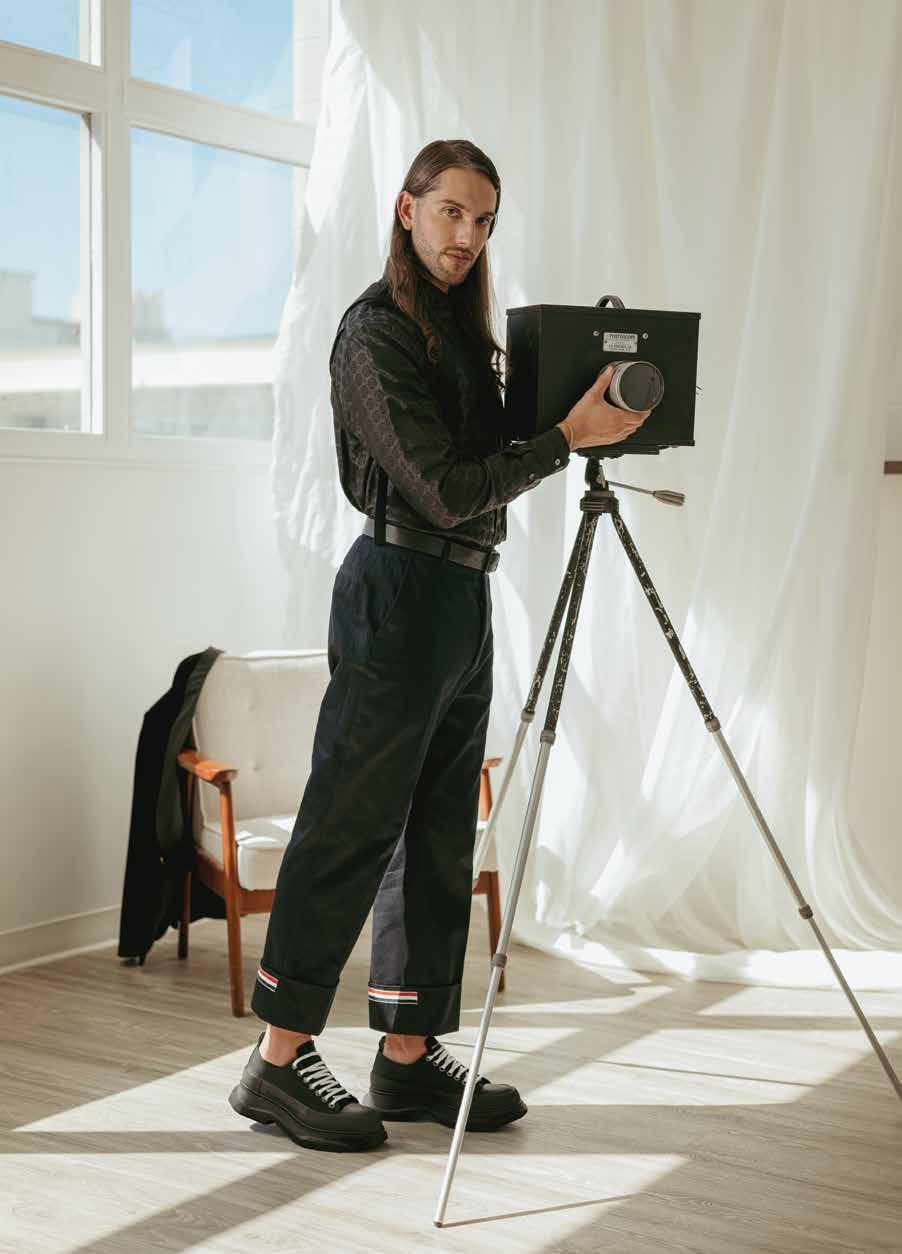
Hermés zipped sweatshirt in greige suede reindeer skin with coloured zips and saddle nails, T-shirt with Tunisian collar in H red cotton with double
dévoré Mors et Gourmettes print, and pleated trousers in chocolate stretch cotton serge. Tiffany HardWear wrap necklace in 18K gold from Tiffany & Co.
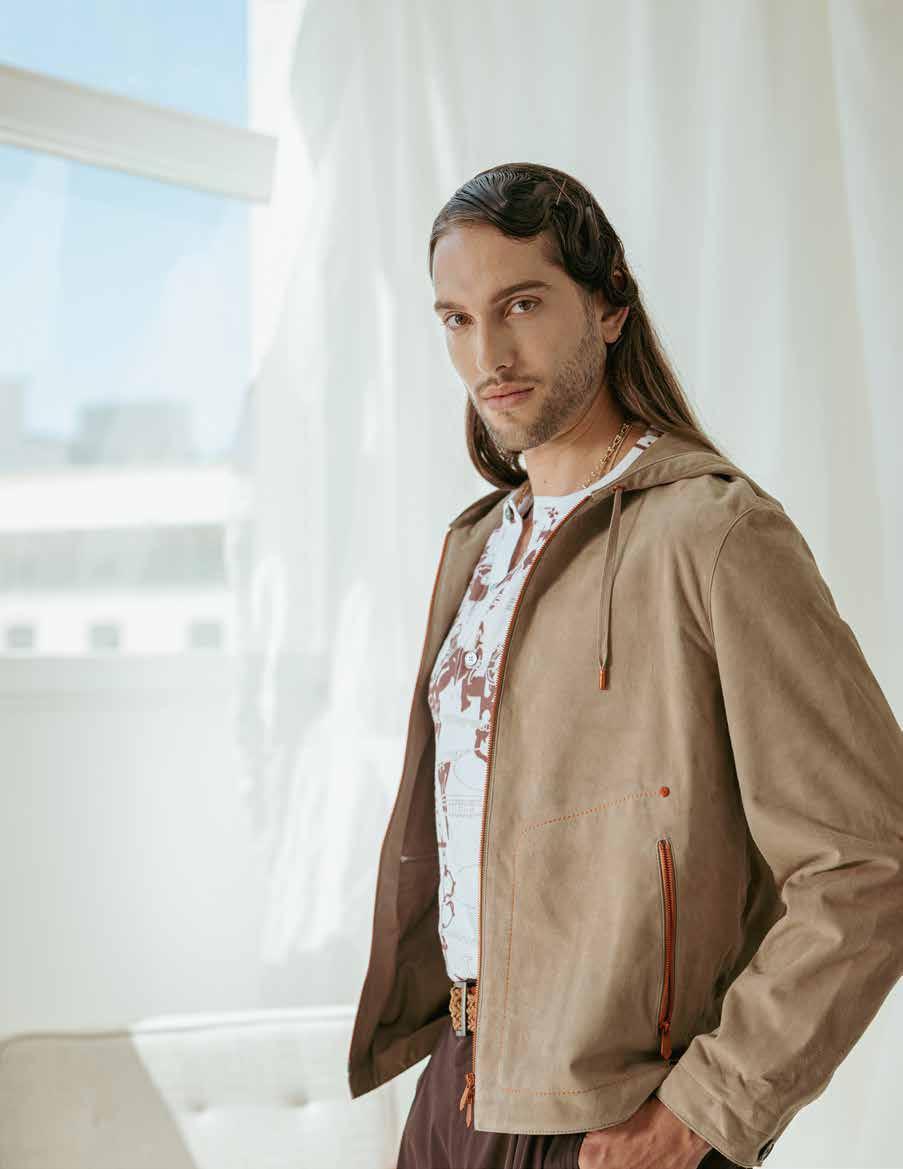
 Louis Vuitton Men’s velvet Pont Neuf evening cocktail jacket. Black floral dress from Saks Fifth Avenue.
Louis Vuitton Men’s velvet Pont Neuf evening cocktail jacket. Black floral dress from Saks Fifth Avenue.
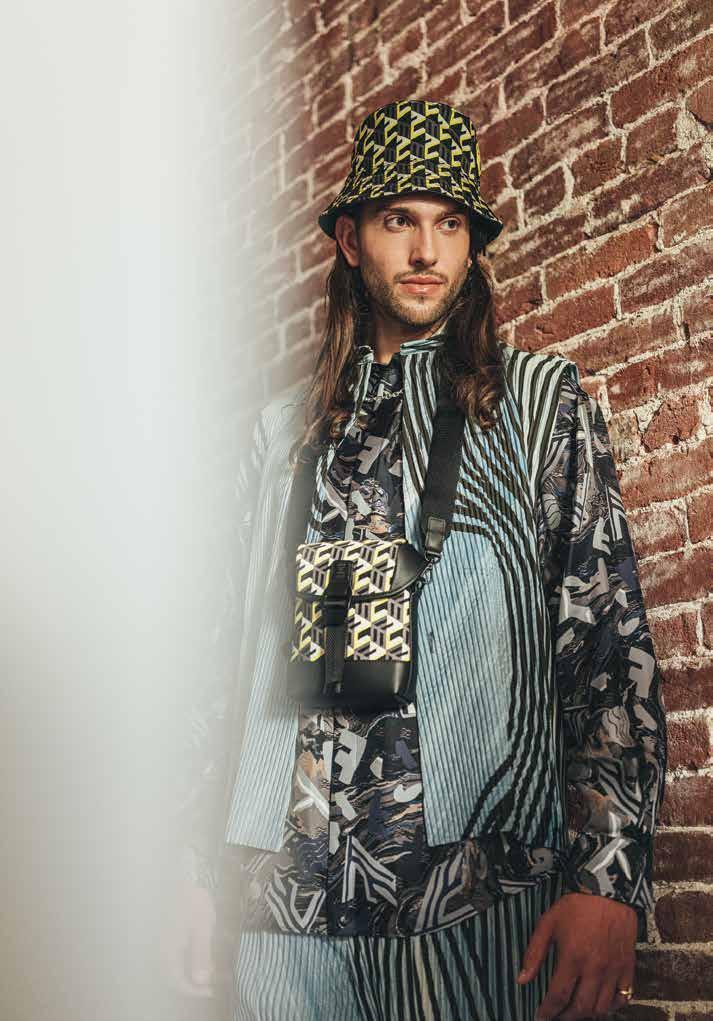 Fendi fragment silk button-down shirt from Saks Fifth Avenue. Homme Plissé Issey Miyake blue Body Movement vest and pants from Saks Fifth Avenue. MCM cube nylon crossbody bag and cubic logo nylon hat from Saks Fifth Avenue. Tiffany HardWear medium link necklace from Tiffany & Co.
Fendi fragment silk button-down shirt from Saks Fifth Avenue. Homme Plissé Issey Miyake blue Body Movement vest and pants from Saks Fifth Avenue. MCM cube nylon crossbody bag and cubic logo nylon hat from Saks Fifth Avenue. Tiffany HardWear medium link necklace from Tiffany & Co.
Versace printed short-sleeve silk shirt from Saks Fifth Avenue. Tiffany HardWear wrap necklace in 18K gold from Tiffany & Co.
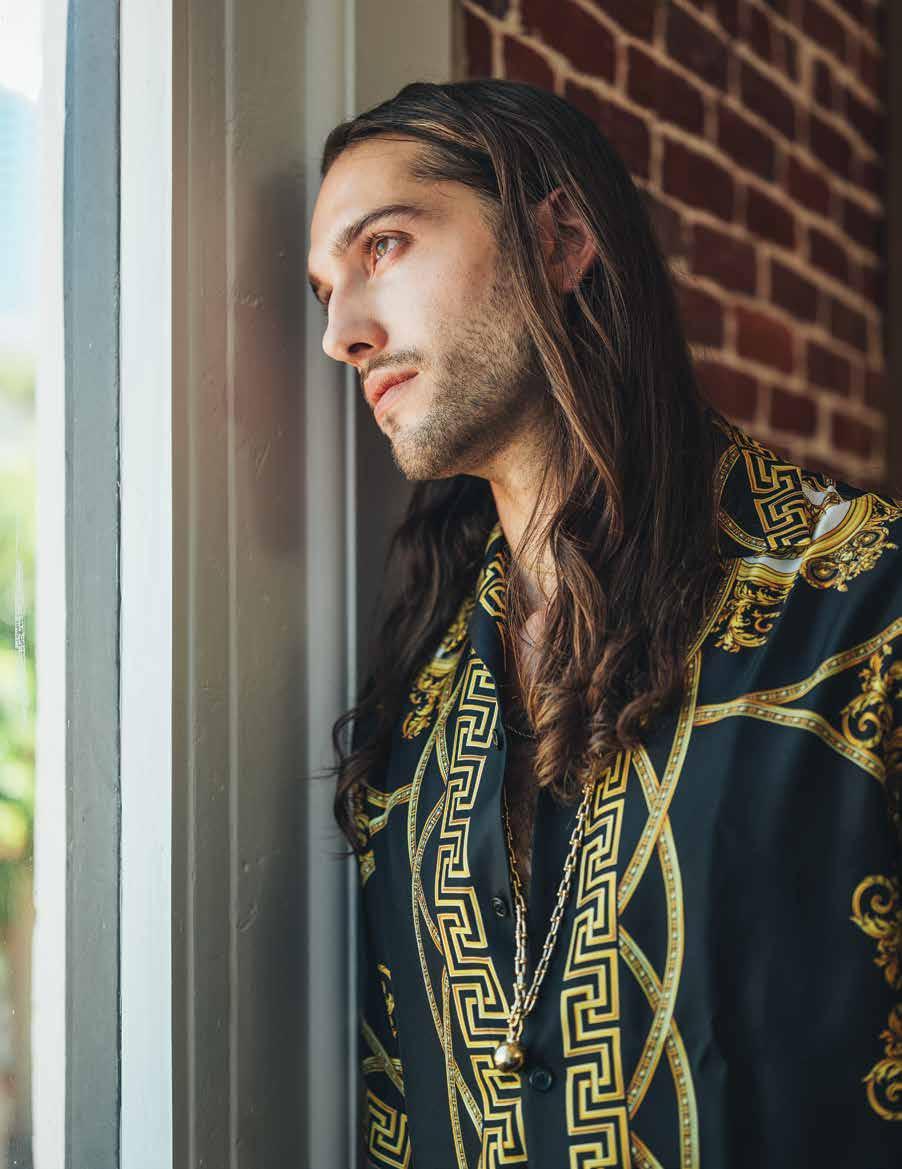
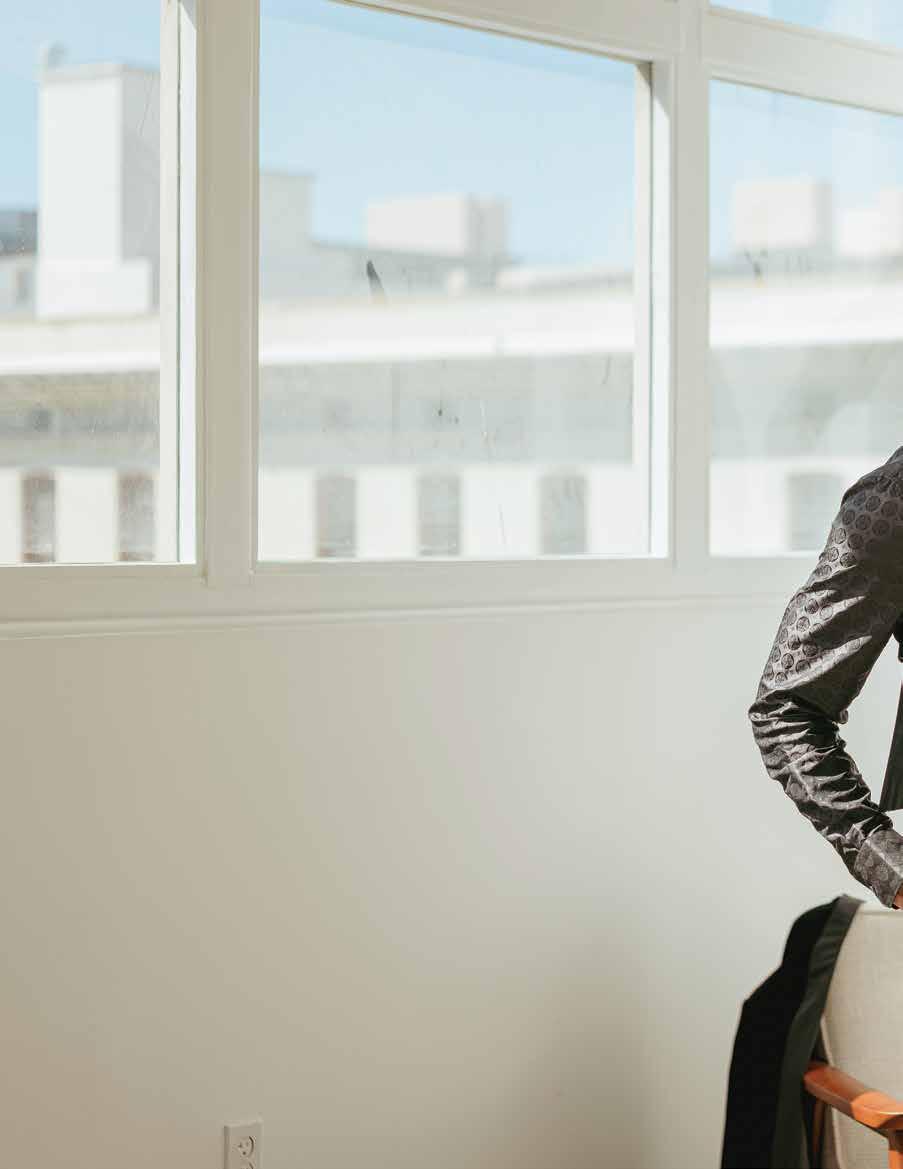 Louis Vuitton Men’s regular DNA flower tiles evening shirt, monogram embossed mid layer, and velvet Pont Neuf evening cocktail jacket. Thom Browne straight-leg cuffed trousers from Saks Fifth Avenue. Tiffany HardWear medium link necklace from Tiffany & Co.
Louis Vuitton Men’s regular DNA flower tiles evening shirt, monogram embossed mid layer, and velvet Pont Neuf evening cocktail jacket. Thom Browne straight-leg cuffed trousers from Saks Fifth Avenue. Tiffany HardWear medium link necklace from Tiffany & Co.

 Tiffany HardWear double link pendant and wrap necklace in 18K gold from Tiffany & Co.
MCM Visetos monogram bucket hat from Saks Fifth Avenue. Tod’s maroon button-down shirt and brown cotton jacket.
Tiffany HardWear double link pendant and wrap necklace in 18K gold from Tiffany & Co.
MCM Visetos monogram bucket hat from Saks Fifth Avenue. Tod’s maroon button-down shirt and brown cotton jacket.
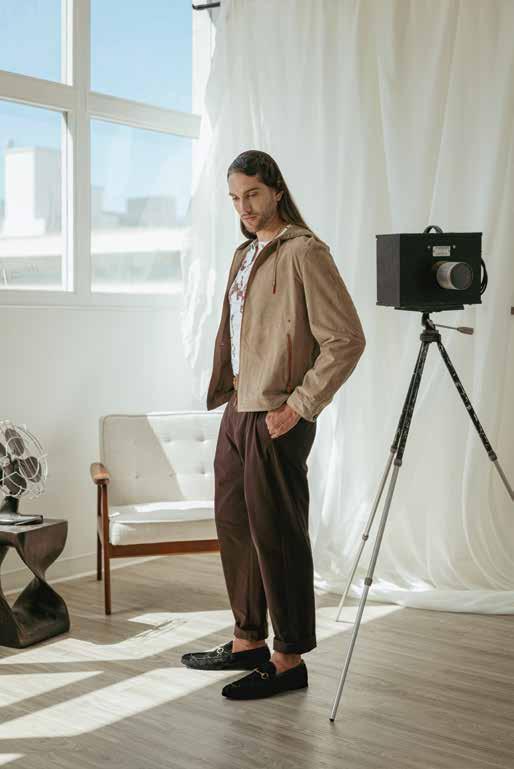 Hermés zipped sweatshirt in greige suede reindeer skin with coloured zips and saddle nails, T-shirt with Tunisian collar in H red cotton with double dévoré Mors et Gourmettes print, and pleated trousers in chocolate stretch cotton serge. Gucci Jordaan GG velvet loafer from Saks Fifth Avenue.
Hermés zipped sweatshirt in greige suede reindeer skin with coloured zips and saddle nails, T-shirt with Tunisian collar in H red cotton with double dévoré Mors et Gourmettes print, and pleated trousers in chocolate stretch cotton serge. Gucci Jordaan GG velvet loafer from Saks Fifth Avenue.
 Hermés zipped sweatshirt in greige suede reindeer skin with coloured zips and saddle nails, T-shirt with Tunisian collar in H red cotton with double dévoré Mors et Gourmettes print, and pleated trousers in chocolate stretch cotton serge. Tiffany HardWear wrap necklace in 18K gold from Tiffany & Co. Tiffany Knot double row ring in yellow gold and T T1 Ring in yellow gold with diamonds, 4.5 mm wide.
Hermés zipped sweatshirt in greige suede reindeer skin with coloured zips and saddle nails, T-shirt with Tunisian collar in H red cotton with double dévoré Mors et Gourmettes print, and pleated trousers in chocolate stretch cotton serge. Tiffany HardWear wrap necklace in 18K gold from Tiffany & Co. Tiffany Knot double row ring in yellow gold and T T1 Ring in yellow gold with diamonds, 4.5 mm wide.
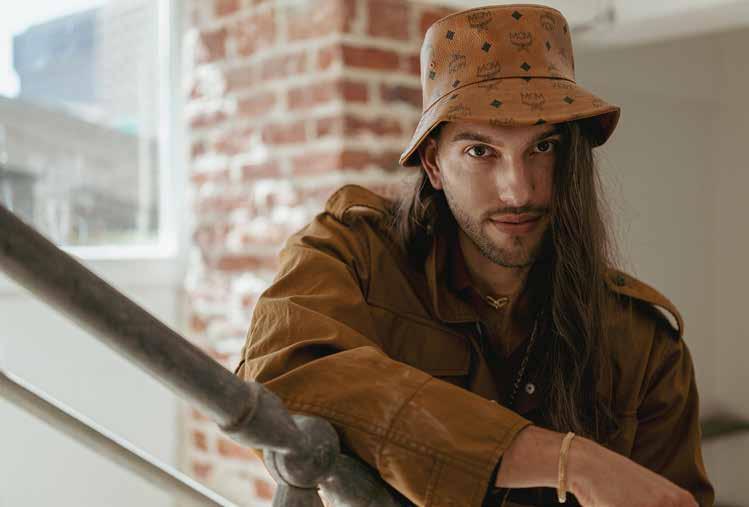
Alexander McQueen
Ala Moana Center 1450 Ala Moana Blvd. alexandermcqueen.com
808.664.7610
Hermès Available at stores nationwide 1.800.441.4488 hermes.com
MCM Visetos monogram bucket hat from Saks Fifth Avenue. Tod’s maroon button-down shirt and brown cotton jacket. Tiffany HardWear double link pendant and wrap necklace in 18K gold from Tiffany & Co.
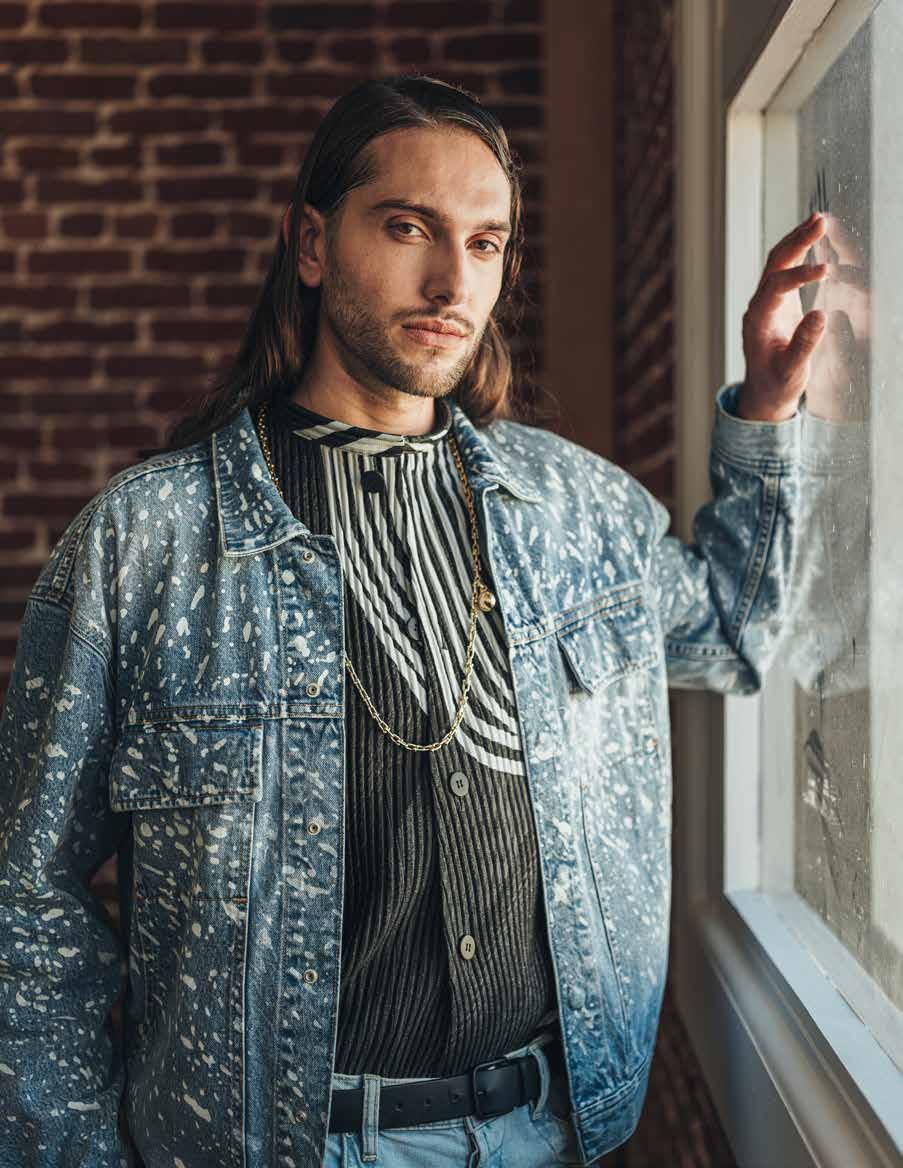 Boxy trucker jacket and Hudson D-Blinder V2 Elements skinny jeans from Saks Fifth Avenue.
Homme Plissé Issey Miyake black Body Movement vest. Tiffany HardWear wrap necklace in 18K gold from Tiffany & Co.
Boxy trucker jacket and Hudson D-Blinder V2 Elements skinny jeans from Saks Fifth Avenue.
Homme Plissé Issey Miyake black Body Movement vest. Tiffany HardWear wrap necklace in 18K gold from Tiffany & Co.
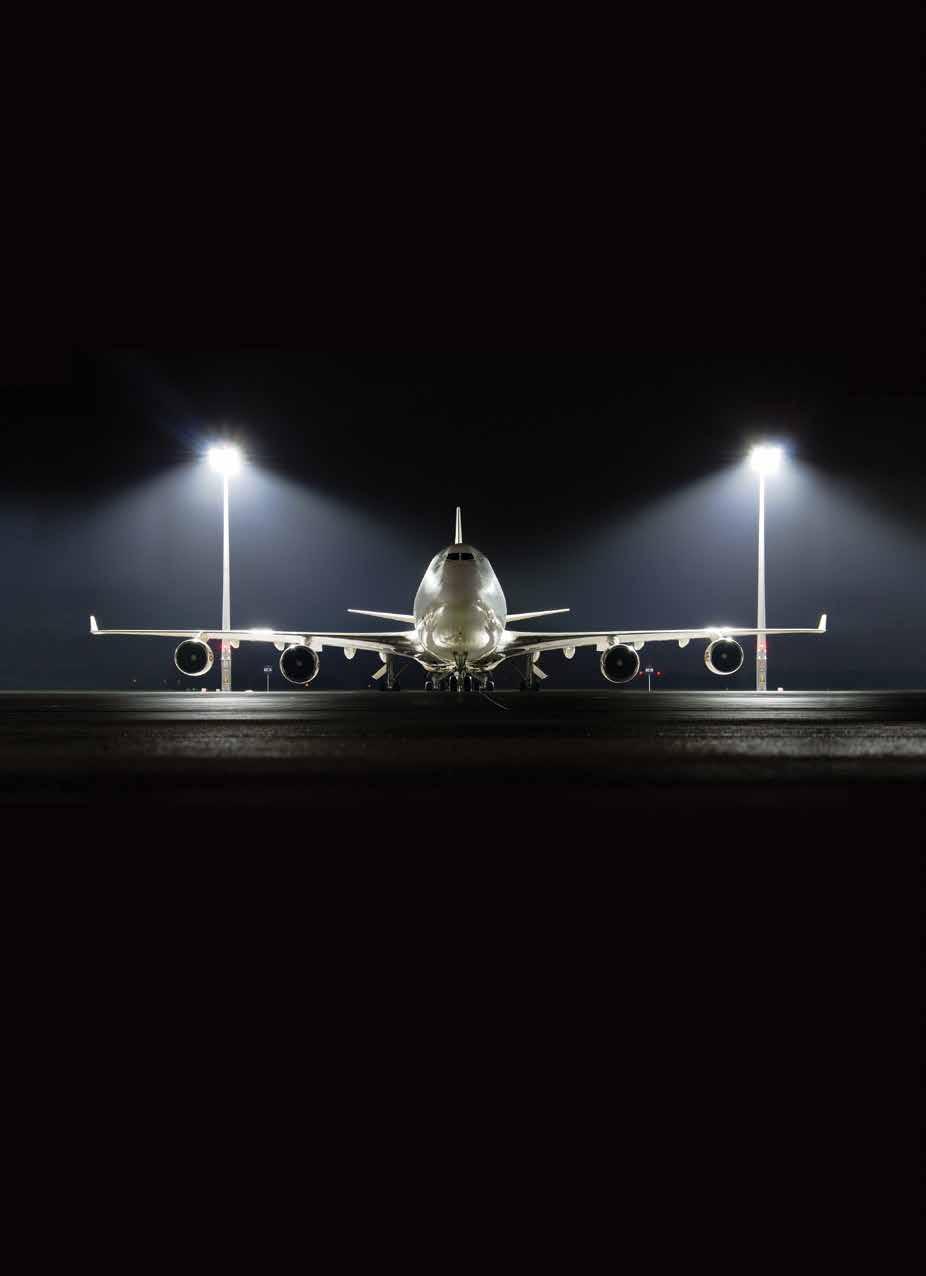
Boeing 747-400 Nose Loader service and Ad Hoc charters on demand. Connecting LAX and HNL For more information, a free quote or to book online visit pacificaircargo.com or call 808.427.1235 AIR FREIGHT SPECIALISTS EXCEEDING ALL EXPECTATIONS daily with daily connections to Neighbor Islands and weekly service to Pago Pago and Guam.
Feels Like Home
Text by Mia Noguchi
文 = ミア·ノグチ
Images courtesy of Hale Kālele
写真 = ハレ·カレレ提供

94 PALM
まさに我が家
D DESIGN Hale Kālele x Palm
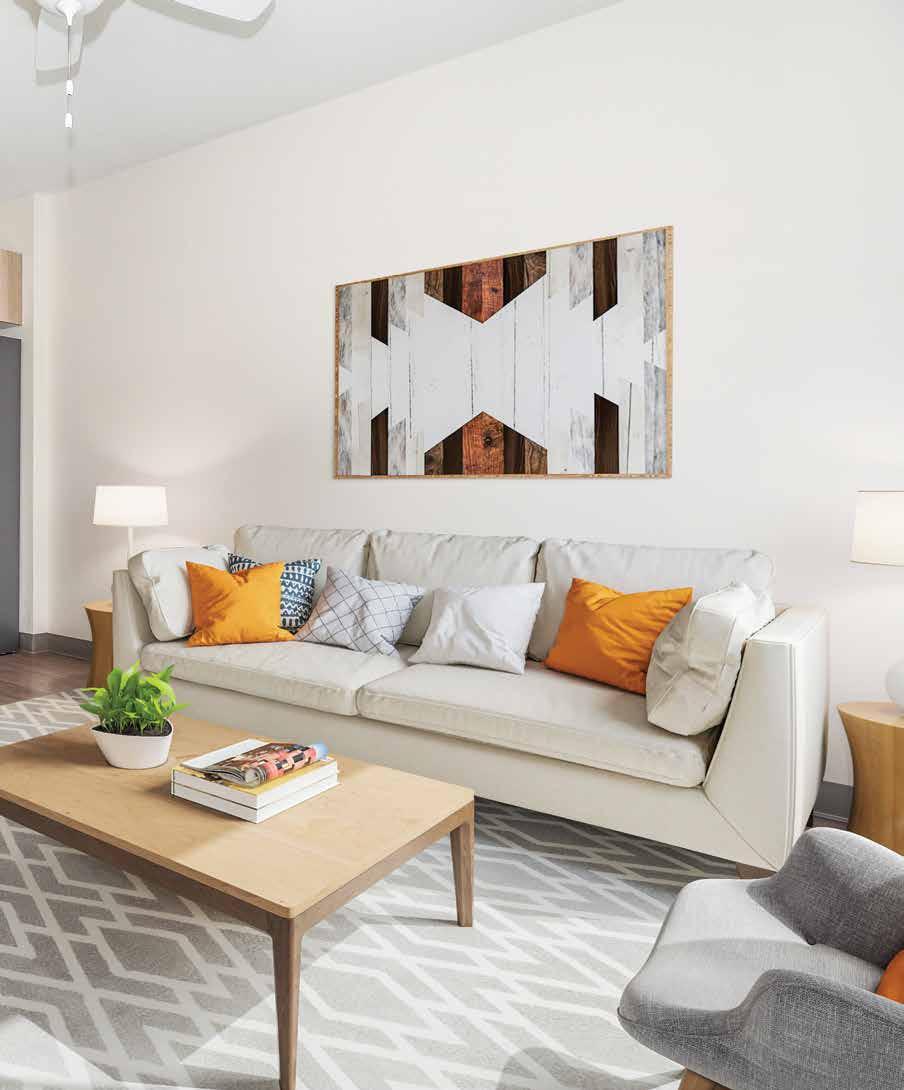
In a city with no shortage of high-end builds, a unique residential development aims to move the needle on Hawai‘i’s affordable housing landscape.
Hawai‘i is known as paradise to many, but to those who live here, Hawai‘i is simply home. It’s a place to be with family and friends, a place to work, and a place to contribute to our community while creating a pathway for future generations. These are things Kobayashi Group had in mind when it built Hale Kālele Residences, its first affordable housing project conveniently located in a neighborhood near Ala Moana.
“Hale Kālele was meant to be a place that would invoke a feeling of comfort and safety while providing an atmosphere that would open a pathway forward for its residents,” said Alana Kobayashi Pakkala, chief operating officer for Kobayashi Group. “Nothing provides more sense of security than having a place to call home.”

The newly constructed Hale Kālele Residences have a modern feel, with clean, open spaces and features you might find in a marketrate condominium. There are recreational spaces, a barbecue area, floor-to-ceiling windows, Energy Star appliances, controlled access, and more. They also incorporate technology that provides added safety, such as Aerapy ultraviolet germicidal equipment on the first floor (to destroy 99 percent of tested virus and bacterial pathogens) and UV-C light purification devices in the elevators.
The building was also designed to be conscious of the environment, utilizing a significant PV installation to make the project more sustainable and provide residents with renewable energy. Residents will have access to centralized solar hot water heating, electric vehicle (EV) charging stations, and two 100 percent electric EV car-sharing programs. Hale Kālele will also offer 100 percent electric micro-mobility options for rent to provide more transportation options for residents.
The project is also the first in the state to use CarbonCure in vertical construction. CarbonCure uses clean technology to create concrete with less cement, resulting in a reduced carbon footprint without compromising strength.
Another unique aspect of the project is how it came to fruition. Thanks to an unprecedented crossagency partnership between the Hawai‘i State Judiciary and Hawai‘i Housing Finance and Development Corporation (HHFDC), Kobayashi Group was able to develop needed affordable rentals on the same site as the new Juvenile Service Center, maximizing the use of state lands for the benefit of the community.
“This is just one fine example of how partnerships between government entities and the private sector can contribute to making Hawai‘i a place where locals can continue to live, work, and play.
96 D DESIGN Hale Kālele x Palm
고급 건물들이 적지 않은 도시에서, 독특한 주거지 개발은 하와이의 저렴한 주택 풍경을 조금씩 움직이는 것을 목표로 하고 있습니다.
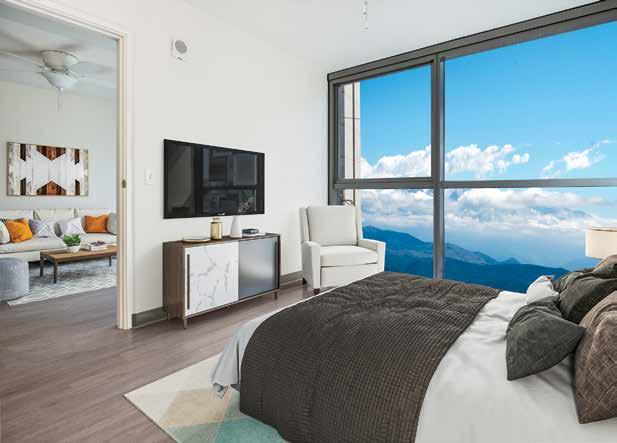
Featuring amenities one might find in a market-rate condominium,
Hale Kālele is redefining affordable housing in Honolulu’s urban core.
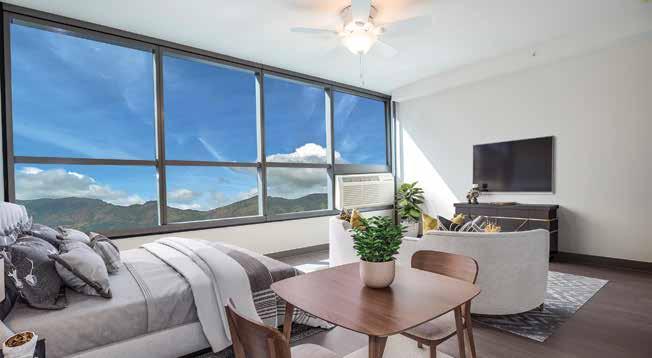
Hale Kālele occupies the same site as the new Juvenile Service Center, maximizing the use of state lands for the benefit of the community.
We are thankful for the opportunity to be a part of it,” said Patrick Kobayashi, president and CEO of Kobayashi Group.
HHFDC Executive Director Denise Iseri-Matsubara said, “We’re proud of the work they’ve done to bring the project to life. This is the state’s first interagency development project on underutilized state land, and we hope that this can serve as a model for the future.”
While they sit on the same property, Hale Kālele and the Juvenile Service Center are distinct, featuring separate entrances and parking areas. The Center will serve status offenders (youth who violate laws that would not be crimes if they were over the age of 18, such as truancy, running away from home, and other low-end law violations) with the intent to help improve their lives via youth partnerships with social services agencies. Agencies will provide services to help them cope with issues such as anger management, substance abuse, and more.
“We are pleased to be part of this partnership which serves two vital needs in the urban core,” said Chief Justice Mark E. Recktenwald. “The first is to continue providing services and shelter for at-risk youth who need our support and guidance during a critical time in their lives. The second is the creation of much-needed affordable rental housing. This is truly a win-win for the community, and we are grateful to the Legislature for its support of this important project.”
Hale Kālele will offer a total of 200 units: 36 studios, 54 one-bedroom units, and 110 two-bedroom units within the 20-story high-rise building. Families
earning between 30 and 60 percent of the area median income (AMI) were invited to participate in a lottery that began accepting applications on February 1, 2022. The monthly rent for a studio unit ranges from $542 to $1,177. A one-bedroom unit will range from $570 to $1,250 per month. Rent for a two-bedroom unit will be between $664 and $1,480 per month.
“While our company has been involved in many projects throughout the state, this project is near and dear to our hearts, and it is just the first of many more to come for us. Our next rental project, Kapolei Parkway, will bring 405 much-needed 30 to 60 percent AMI rentals as well as 180 preschool seats to benefit members in our community,” Pakkala said. “This is our home, and the Kobayashi family is committed to more projects that will give locals access to secure and stable housing, allowing them to achieve the dream of one day buying their own home in Hawai‘i and not having to move to the mainland.”
BlackSand Capital, which is also operated by a member of the Kobayashi family, has also been partnering with other affordable housing developers focused on providing residents with affordable housing options and bringing more beneficial projects like Hale Kālele to fruition.
“Affordable housing has been a challenge for many years in Hawai‘i, and it’s going to take more collaboration to create the balance we need so people will have options and opportunity,” said BJ Kobayashi, CEO and founder of BlackSand Capital. “It’s a balance we are working toward every day.”
98 PALM D
DESIGN Hale Kālele x Palm
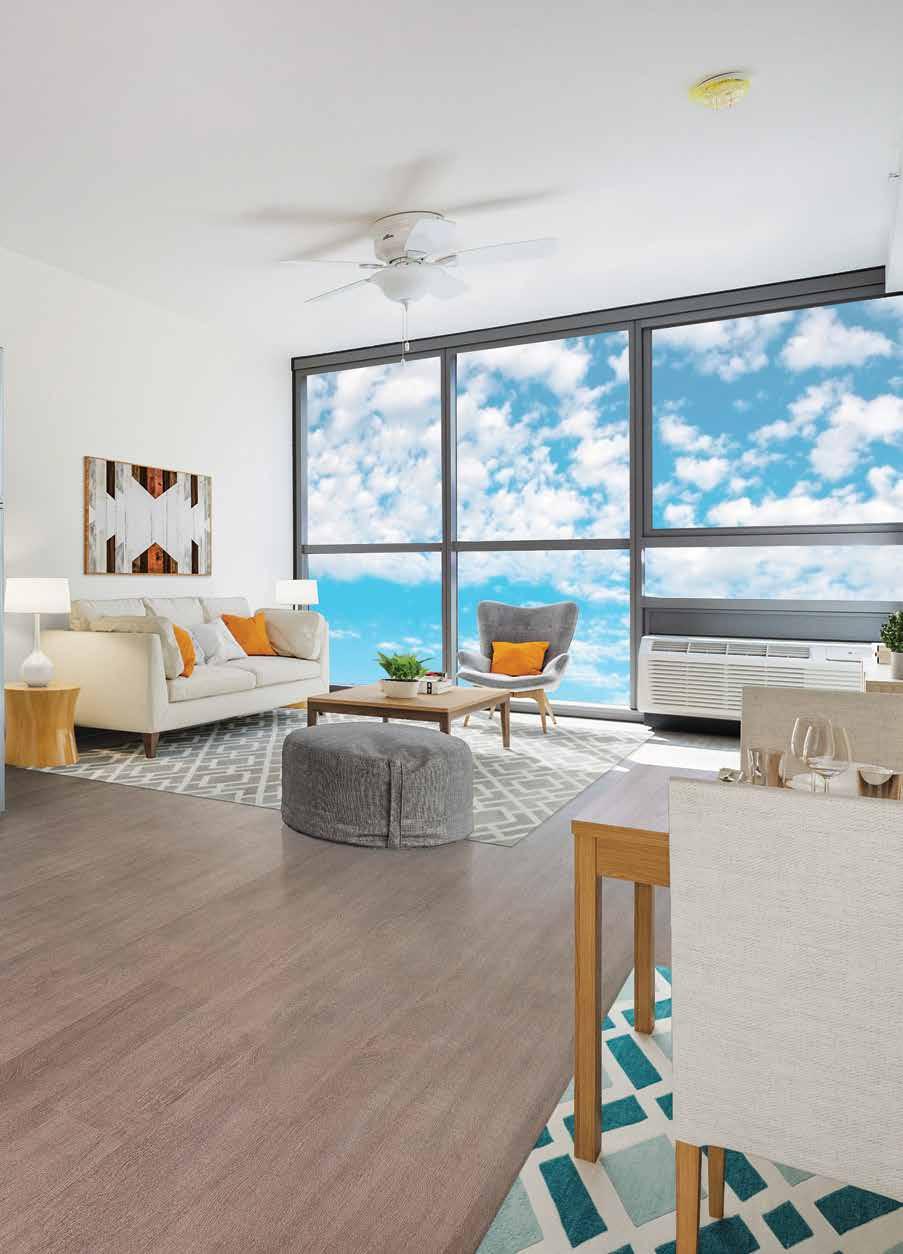
experiences
ES CA PES
both
Travel
E エスケープ PALM
faraway and familiar
101
E PALM
Future Perfect
Text by Sarah Gamboni
Images by Dany Eid, Antony Fleyhan, Mahmoud Khaled, Katarina Premfors, Suneesh Sudhakaran, and Christophe Viseux

102 E PALM ESCAPES Dubai
ムフォース、サニーシュ・スダカラン、 クリストフ・ヴィソー
写真 = ダニー・イード、アントニー・フレイ ハン、マーマウド・カーレド、カタリナ・プレ
未来型の都市へ
文 = サラ・ガンボーニ

The transient is made permanent at Expo 2020 Dubai, a hyperglobal feast of ideas with a vision set on innovation and sustainability.
イノベーションと持続可能性をビジョ ンに掲げ、世界各地から多彩なアイデ アを集結させたドバイ万博では、一時 的なものが永続的なものに変わろうと していました。
Acity of superlatives, Dubai is a living embodiment of the mantra that bigger is better. Boasting the world’s tallest building, highest restaurant, and deepest swimming pool, and a fleet of police vehicles that includes Lamborghinis, Ferraris, and Bugattis, you’d be forgiven for thinking there’s little substance beneath Dubai’s brash, shiny surface.
Beyond all that gloss and glamour, however, you’ll find traditional touchpoints embedded in Arabia: the quiet calm of the sikkas (alleyways) that weave through Al Fahidi’s souks (bazaars) and mud-brick houses; the persistent put-put of the abra boats that ferry you across Dubai Creek for a dirham (approximately 27 cents); the heady scent of oud (incense) in your hotel lobby; and the newly opened Museum of the Future, a shimmering edifice inscribed with Arabic poetry.

Dubai is a high-tensile balance between heritage and high-tech, and nowhere has that been more apparent than Expo 2020. Beginning with the United Kingdom’s Great Exhibition of 1851, world expos have long acted as a stage for innovation and collaboration, bringing together countries and ideas with the common goal of forging a better future. Some of their most enduring legacies include Alexander Graham Bell’s first public demo of the telephone at the Philadelphia Centennial Exposition in 1876; the Eiffel Tower, built for Paris’s Exposition Universelle de 1889; and Seattle’s Space Needle for the Century 21 Exposition in 1962.
何につけても最高を目指す都市ドバイは「大きけ れば大きいほどいい」という考えを体現した街だ。 世界一高いビル、世界一高級なレストラン、世界一 深いプールがあり、ランボルギーニ、フェラーリ、ブ ガッティなどの高級車がパトカーとして使われてい る。あまりにも豪華絢爛で、派手な見かけの下には 何もないような印象をつい抱いてしまいがちだ。 だが、そんなきらびやかな世界の向こうには、 アラブの伝統を色濃く感じさせる側面もある。たと えば、アルファヒディ歴史地区のスーク(市場)や泥 レンガの家々のあいだを縫って張り巡らされたシッ カ(細い路地)の静けさ。わずか1ディルハム(約30 円)でドバイクリークを渡れるアブラボートからぽ んぽんぽんぽんと絶え間なく聞こえてくるエンジン 音。ホテルのロビーに漂う魅惑的なウード(お香) の香り。新しくオープンした未来博物館のきらきら 輝く建物にはアラビア語の詩が刻まれている。 ハイテクと伝統がみごとに共存する都市ドバ イ。その特徴がもっとも顕著に表れていたのが「エ キスポ2020・ドバイ万博」だ。1851年にイギリス で開催されたロンドン万博を皮切りに、これまで世 界各国で開催されてきた万国博覧会は、よりよい 未来を築くという共通の目標を掲げ、多くの国やア イデアが一堂に集まり、イノベーションとコラボレ ーションの花を咲かせる舞台となってきた。1876 年のフィラデルフィア万博では、アレキサンダー・ グラハム・ベルが電話機を初めてお披露目した し、1889年のパリ万博のエッフェル塔、1962年の シアトル万博のスペースニードルなど、今もランド マークとして残る建造物も多い。
エキスポ2020(ドバイ万博)は史上最大の 万博を目指しただけでなく、持続可能性に優れた 博覧会として6か月の開催期間後も長く残るレガ
104 E ESCAPES Dubai
이러한 과도기는 혁신과 지속 가능성에 대한 비 전을 가진 하이퍼 글로벌 아이디어의 향연인 엑 스포 2020 두바이에서 상설화됩니다. Translation
翻訳 = 白倉三紀子
by Mikiko Shirakura
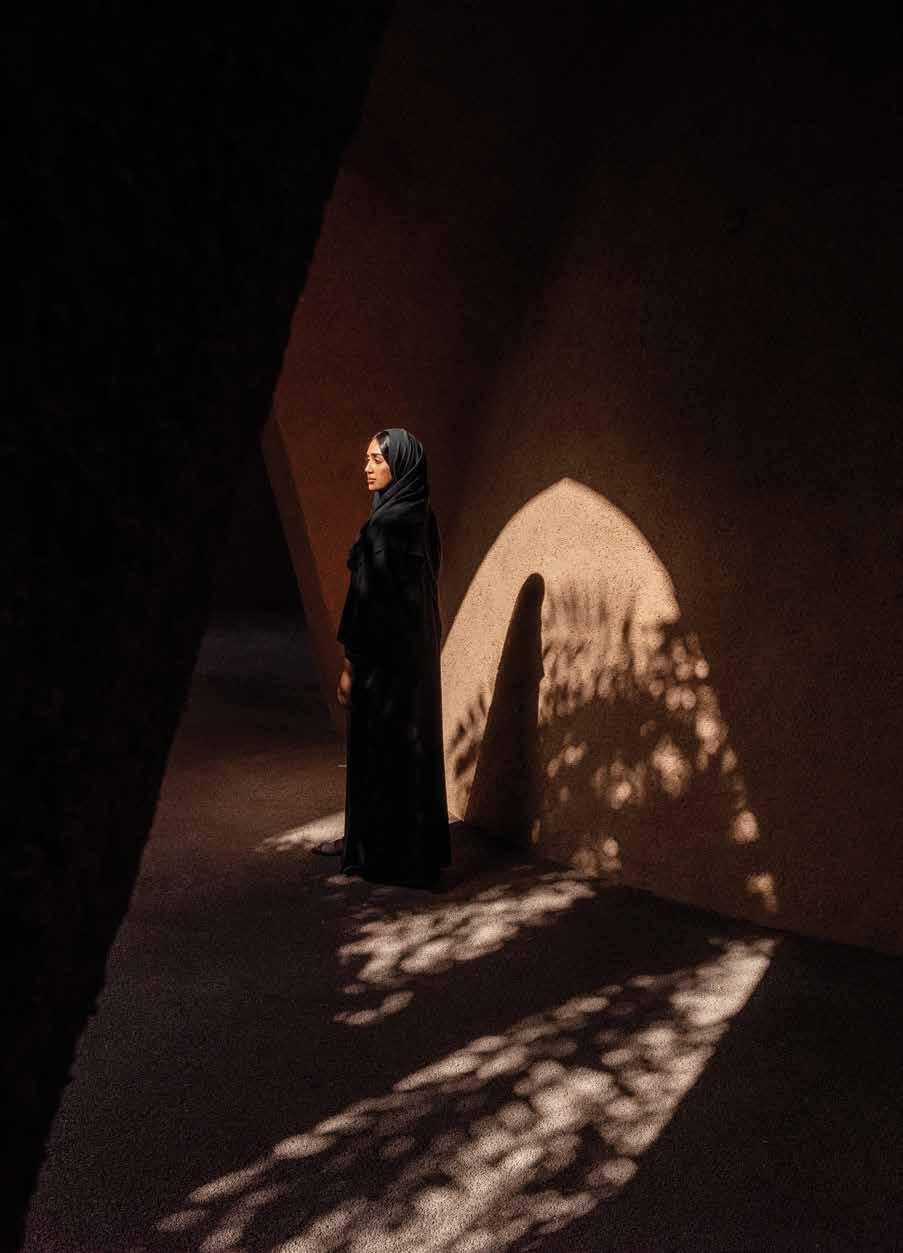
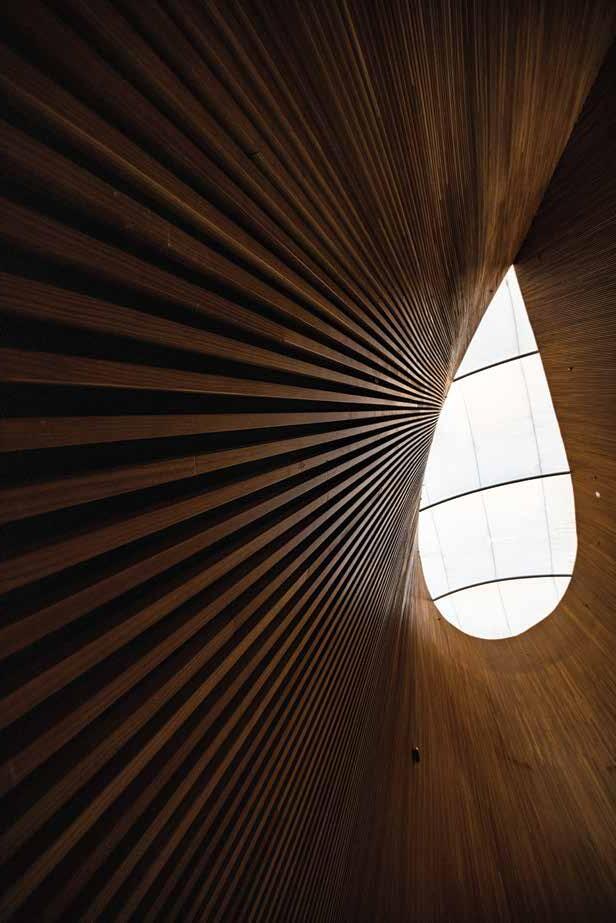


Beginning with the United Kingdom’s Great Exhibition of 1851, world expos have long acted as a stage for innovation and collaboration.
For Expo 2020, organizers set out to make Dubai’s the biggest world fair ever, but also one of the most sustainable, with a legacy that extends well beyond the exhibition’s six-month duration. The pandemic delayed plans by a year, but when Expo 2020 Dubai opened in October 2021, it featured a record-breaking 192 participating countries and a masterplan for the city’s future. The first thing that strikes you is the sheer scale of the Expo 2020 site. Spanning more than 1,000 acres, it is arranged into three distinct districts, thematically named Mobility, Sustainability, and Opportunity, fanning out from Al Wasl Plaza, named after the Arabic for “connection.”
At each entrance stands a pair of 70-foot-high carbon fiber gates. Inspired by the intricate mashrabiya
シーを築くことを目標としていた。新型コロナウイ ルスの影響で開催は1年遅れたが、2021年10月 にオープン。過去最高の192か国が参加し、ドバイ の未来を見据えた都市計画の骨格を示した。 まず驚かされるのはエキスポ2020の会場の 大きさだ。広さ4キロ四方以上の会場は、アラビア 語で「つながり」を意味するアル・ワスル・プラザを 起点に、モビリティ(移動性)、サステイナビリティ (持続可能性)、オポチュニティ(機会)の3つのエ リアで構成されている。
それぞれの入り口には、高さ20メートルほど の一対のカーボンファイバー製ゲートが設置され ている。アラブの伝統的な家屋に見られる複雑な マシュラビーヤ(格子状のスクリーン)からインスピ レーションを得たデザインは、現在と未来の境界 線を表現しているという。期待どおり、ゲートをくぐ るやいなや最初のロボットが出迎えてくれた。TV アニメ『宇宙家族ジェットソン』から出てきたような
108 PALM E ESCAPES Dubai



(latticework screens) of traditional Arabian homes, they are designed to act as a demarcation between present and future. Sure enough, no sooner am I through the gates that I encounter my first robot. A retro-looking lady-bot who could’ve been plucked straight from The Jetsons, she tersely reminds me to wear a mask before trundling on her way.
I soon realize it’s impossible to do the expo justice in just one visit. On my first day I dart among pavilions with my son and daughter, as they rush to collect stamps in their passports like contestants on a reality television show. Respite comes in the form of a mesmerizing water feature named Surreal, a four-story installation near the main plaza. Waves of water crest over the walls, surging down the curved pebbled surface to the delight of barefooted visitors below, before seeming to flow upwards again, all to an orchestral soundtrack by Game of Thrones composer Ramin Djawadi.
After that first foray, barely scratching the surface of the Mobility district, I upgrade our day tickets to a season pass. Future visits over the coming months take a more leisurely pace. We wander the palm-lined boulevards and shaded sikkas, ogling the architecture of every nation’s structures. There’s the delicate whimsy of Poland’s pavilion, adorned with hundreds of white sculpted birds that turn in the breeze; the bravado of Russia’s rainbow facade, coiled with brightly coloured cables; the awesome might of Saudi Arabia’s LED edifice, laid open like a book; and the quiet majesty of Sweden’s spruce forest, a sustainable tour de force that will be dismantled and then reassembled elsewhere at the end of its tenure.
Admittedly, as Australian expats living in Dubai, my family and I spend more time in the Australia Pavilion than anywhere else, returning time and again to feed our homesick souls with fried potato cakes, chocolatecoated lamingtons, and First Nations dreamtime stories presented within the pavilion’s immersive dome. There’s much more to be savored, elsewhere, of course, from African snacks and baobab-infused cocktails to Belgian frites and beers, and multi-course dinners from Michelin-starred chefs.
For all of the fair’s facades, it’s the transition from day to night that is most beguiling, when the understated elegance of Oman’s timber and white exterior transforms into a technicolor bulb, the wings of the Sustainability Pavilion appear in full flight, and sunset lingers for an additional hour thanks to the warm, rosy glow of LED streetlights.
Now that Expo 2020 has drawn to a close, another transition is underway as the area transforms into District 2020, an integrated “15-minute city” of the future, wherein everything can be reached within a
レトロな女性ロボットは、キビキビした口調でマスクの着用をうながし、スーッ と移動していった。
1回訪れただけではすべてを見きれないのはすぐに明らかになった。初め て訪れた日、私はスタンプを集める息子と娘と一緒に、リアリティ番組のように パビリオンからパビリオンへと駆け巡った。慌ただしさのなかで、安らぎを与え てくれたのは巨大な滝「サリアル(超現実)」だ。メインプラザ近くに設置された 4階建ての高さがあるこの滝は、『ゲーム・オブ・スローンズ』の音楽を手がけた ラミン・ジャワディ氏によるオーケストラのサウンドに合わせて、小石が敷き詰 められた壁をせり上がっていく水が波のように次々と落ちてきて、また上に向 かうように見せかけながら一気に素足の観客たちめがけて落ちてくる趣向だ。 1回目の訪問ではモビリティエリアのほんのさわりしか見られなかった ので、私は1日券をシーズンパスにアップグレードした。数か月かけ、もっとゆっ たりしたペースで見て回るつもりだった。ヤシの木が並ぶ大通りや日陰のある シッカを歩きながら、各国のパビリオンに目を奪われる。ポーランドのパビリオ ンは、白い鳥をモチーフにした何百ものモビールが風に揺れる繊細で優美なフ ァサードを構えている。圧倒的な存在感を放つのは、色とりどりの鮮やかなケ ーブルで巻かれたロシアの虹のファサードだ。LEDを使用したサウジアラビア のパビリオンは、開いた本のようなフォルムが印象的。スウェーデンのパビリオ ンは、静かで雄大なトウヒの森を再現したサステイナブルな大作で、期間終了 後は解体され、また別の場所で組み立てられる予定だ。 ドバイに住むオーストラリア人である私たち家族は、どうしてもオースト ラリアのパビリオンにいる時間が長くなってしまう。フライドポテトケーキやチ ョコレートでコーティングされた伝統菓子ラミントン、パビリオン内の没入型 ドームで紹介されているアボリジナルの天地創造の神話などを楽しむために 何度も足を運び、ホームシックを癒す。アフリカのスナックやバオバブを使った カクテル、ベルギーのフリッツやビール、ミシュラン星を獲得した有名シェフに よるコースディナーなど、万博のあちこちで各国のグルメを楽しむことができる のは言わずもがなだ。
万博では多彩なファサードが見どころだが、特にすばらしいのは昼から 夜への転換だ。木材と白を基調としたオマーンの控えめでエレガントな外観は、 夜になるとテクニカラーの大きな球に変身する。サステイナビリティパビリオン のウイングは、大きく羽を広げているように見える。会場に設置されたLED街 灯の温もりあるバラ色の光のおかげで、夕焼けの空を1時間長く楽しめる。 エキスポ2020が閉幕に近づく今、もうひとつ別の転換がはじまろうとし ている。万博の敷地はやがて「ディストリクト2020」へと進化を遂げるのだ。あ らゆる機能に15分以内でアクセスできる「15分都市」をコンセプトにした未来 の統合型都市。万博史上初めて、エキスポ2020で使われたのインフラの最大 90%をオフィス、住宅、レストラン、店舗、学校、その他生活に不可欠なサービ スのために再利用するという。
112 PALM E ESCAPES Dubai

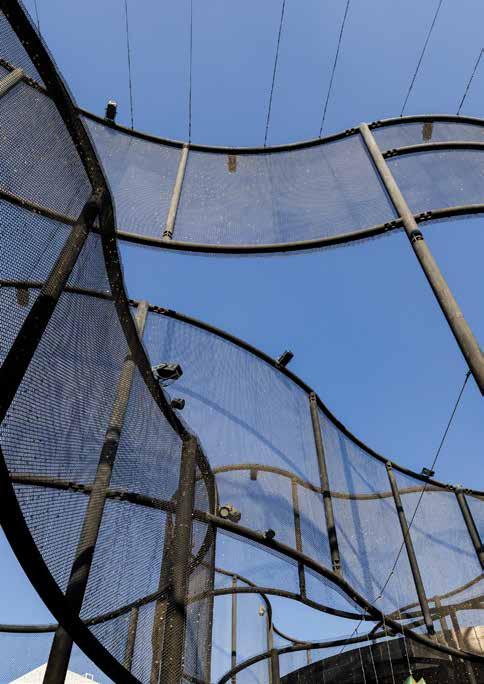

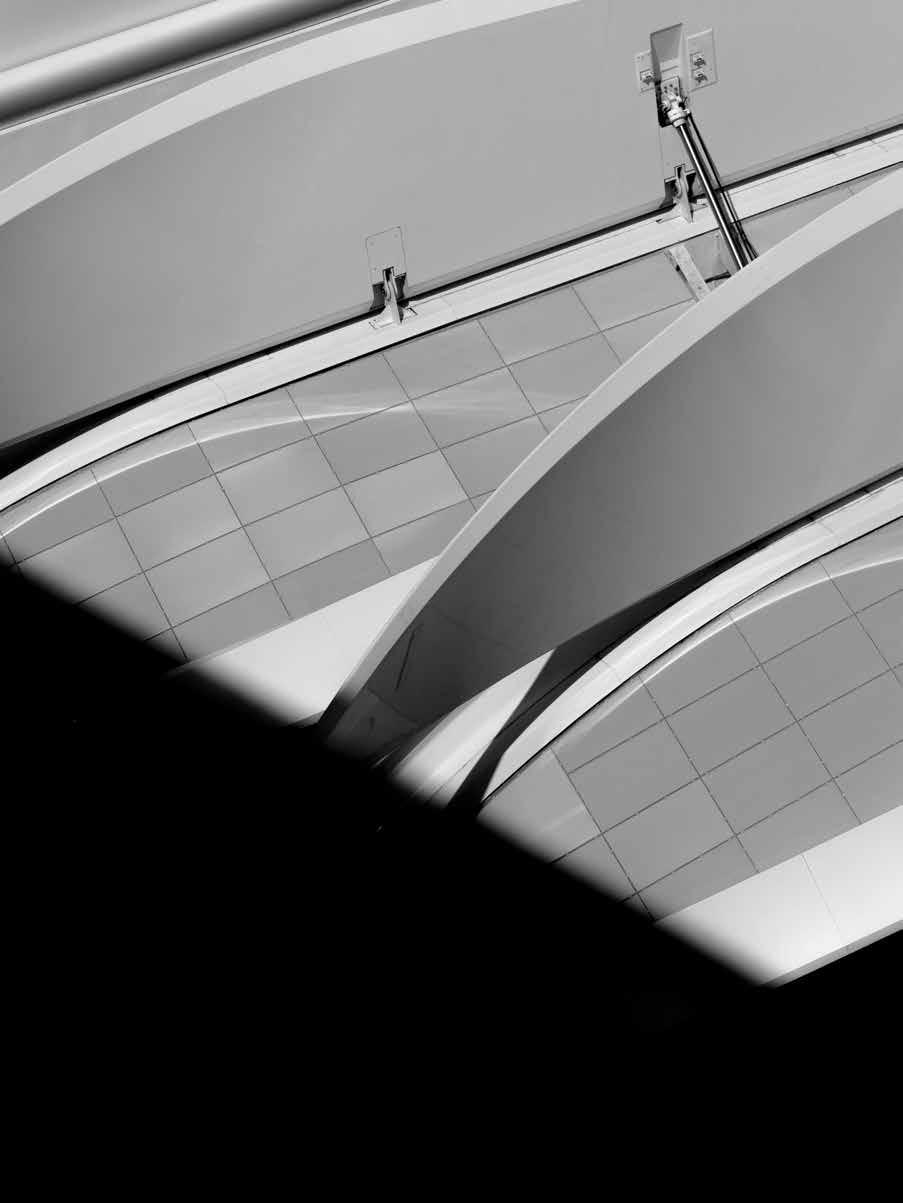
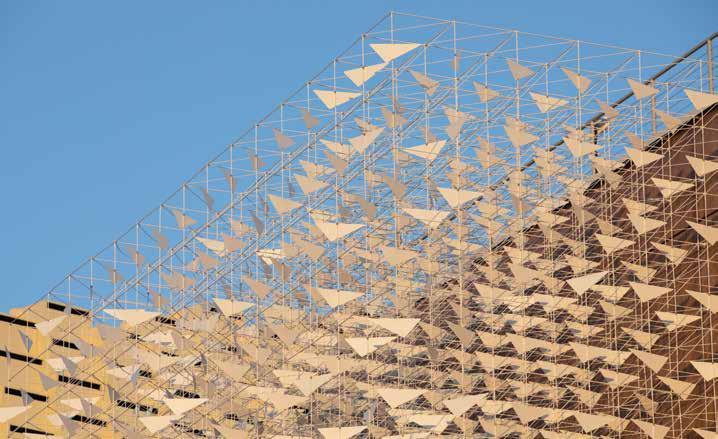
Dubai is a high-tensile balance between heritage and high-tech, and nowhere has that been more apparent than Expo 2020.
quarter-hour. For the first time in the history of the expo, the event’s developers will repurpose up to 90 percent of the existing infrastructure into offices, residences, restaurants, stores, schools, and essential services.
Sustainability is woven into the fabric of the district’s landscape. Solar panels atop steel canopies that mimic trees generate enough energy to power 370 households. Gardens have been planted with drought-tolerant ghaf trees and native grasses, and the LEED-certified buildings feature built-in water and waste recycling programs. The hope is that District 2020 will become the model for future living in Dubai, acting as an incubator for start-ups, transport, and tech businesses.
At a time when travel plans were curtailed and the world felt more unknowable than ever, Expo 2020 provided a sense of escapism and a chance for expats and travelers to reconnect with their home countries. In its next iteration as District 2020, it will soon become a permanent home for a new generation of dreamers and doers.
ディストリクト2020の景観には、サステイナビリティがしっかりと組 み込まれている。たとえば、木を模したスチール製のキャノピーに設置され たソーラーパネルは、370世帯分の発電能力を備えている。庭園には干ばつ に強いケジリの木や在来種の芝が植えられ、LEED認証を受けた建物には、 水やゴミのリサイクルプログラムがあらかじめ組み込まれている。ディストリ クト2020がスタートアップ企業、交通機関、テクノロジービジネスのインキ ュベーターとなり、ドバイの未来のライフスタイルを示すモデルとなることが 期待されている。
海外への自由な行き来が制限され、先行きの不透明感がかつてない ほど高まっている今の時代に、エキスポ2020は、厳しい現実を忘れて夢を 見る感覚や、異国で暮らす人や旅行者が母国とのつながりを取り戻す機 会を与えてくれた。これからはディストリクト2020として、夢を抱き、行動 を起こす新しい世代の人々の永続的な居場所となるだろう。
116 PALM E ESCAPES Dubai

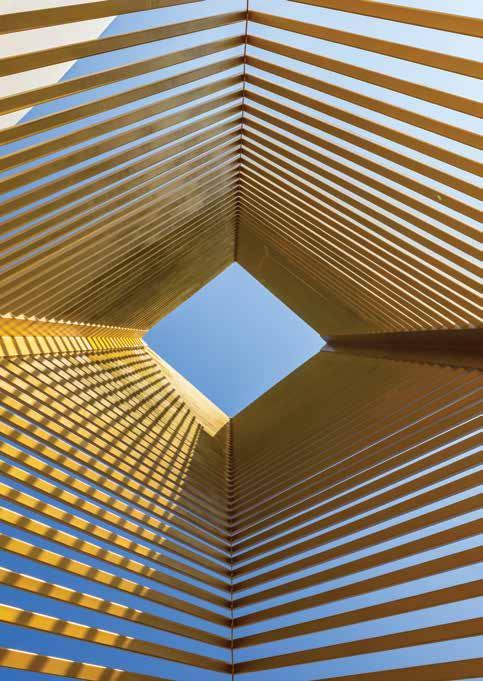
Human Nature
Text by Timothy A. Schuler
文 = ティモシー・A・シューラー
by Lenny Kaholo and Wayne Levin
写真 = レニー・カホロ、ウェイン・レヴィン
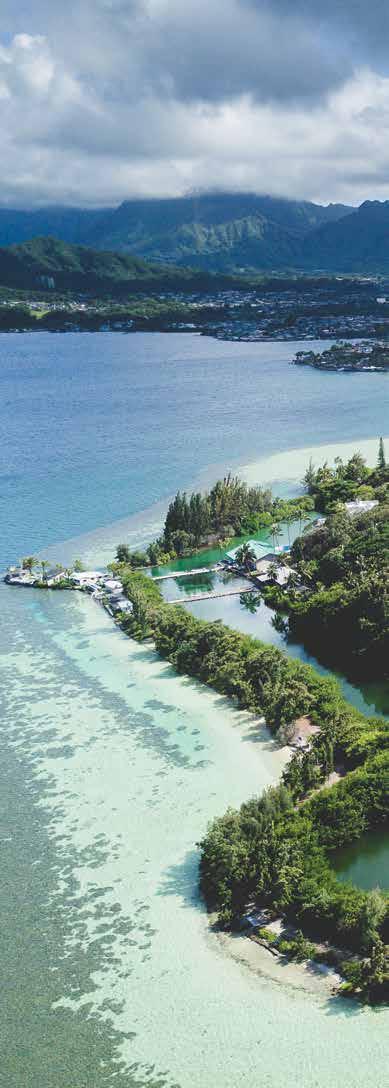
118 E PALM あるべき姿
ESCAPES Coconut Island
Images
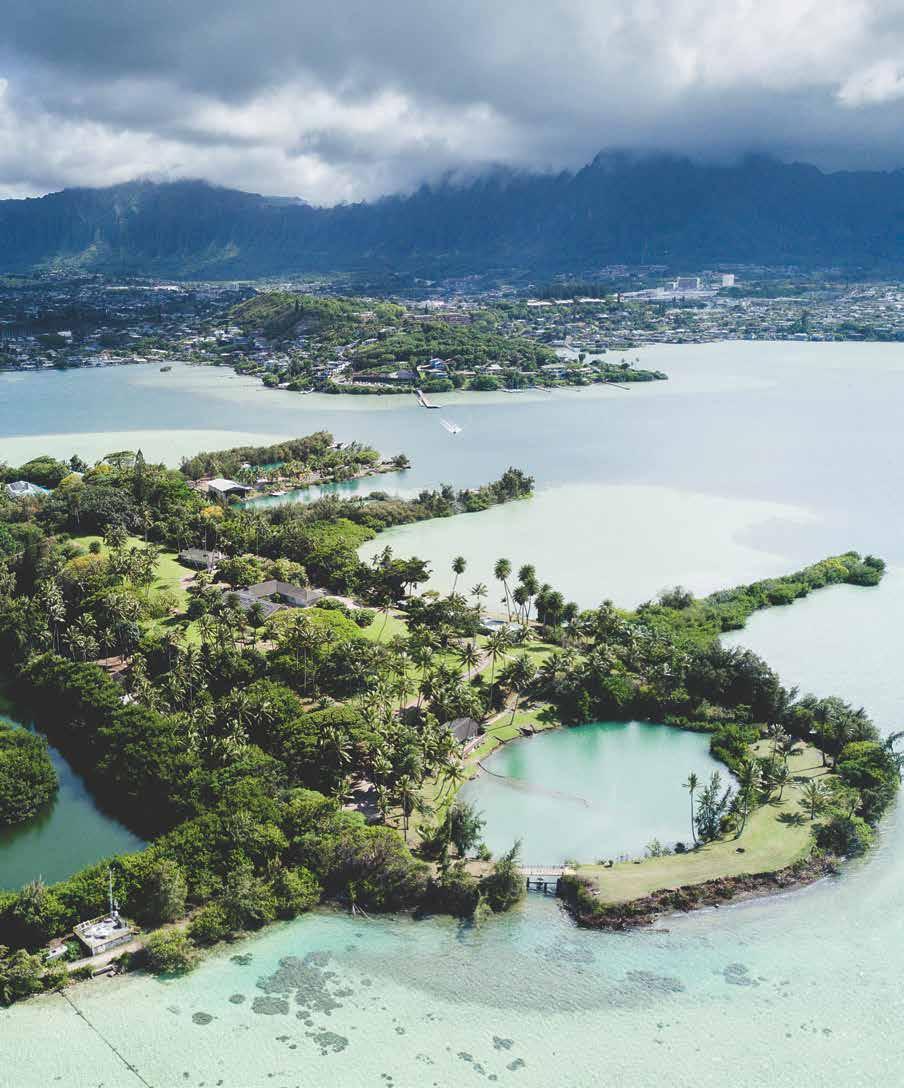
Journey to Coconut Island, where scientists are engineering “super corals” resilient to rising ocean temperatures.
ココナッツアイランドでは、海水温の上昇に耐えうる「スーパーコーラル」の 開発研究が進められています。
Translation by Mikiko Shirakura
翻訳 = 白倉三紀子
과학자들이 상승하는 해양 온도에 탄력적으로
반응하는 "슈퍼 산호"를 설계하고 있는 코코넛
아일랜드로의 여행입니다.

The Hawai‘i Institute of Marine Biology occupies several bland, bunker-like buildings near the center of Coconut Island, which sits a quarter mile offshore of Kāne‘ohe. It’s not the easiest place to reach. You don’t just drive up and park. Instead, to visit the institute, which is home to a series of research laboratories affiliated with the University of Hawai‘i at Mānoa, you must take at least two shuttle rides: the first in an aging, gray Honda CR-V, which ferries you from a parking area near Windward Mall to Lilipuna Pier; the second via a skiff that collects you from the end of the pier and takes you the rest of the way.
カネオへの沖合約400メートルに位置するココナッツアイランド。その中央に ある貯蔵施設のような味気ない建物が、ハワイ海洋生物学研究所(Hawai'i Institute of Marine Biology)の拠点だ。気軽に訪問できる場所ではない。 好きな時にぱっと車で乗りつける、というわけにはいかないのだ。ハワイ大学マ ノア校のラボが集まるこの研究所に行くには、少なくとも2つのシャトルを乗り 継がなければならない。まずウィンドワードモール近くのパーキングからリリプ ナ桟橋まで古いグレーのホンダCR-Vで、そして桟橋の端からココナッツアイラ ンドまでは小型ボートに乗ってたどり着く。
120 PALM E ESCAPES Coconut Island
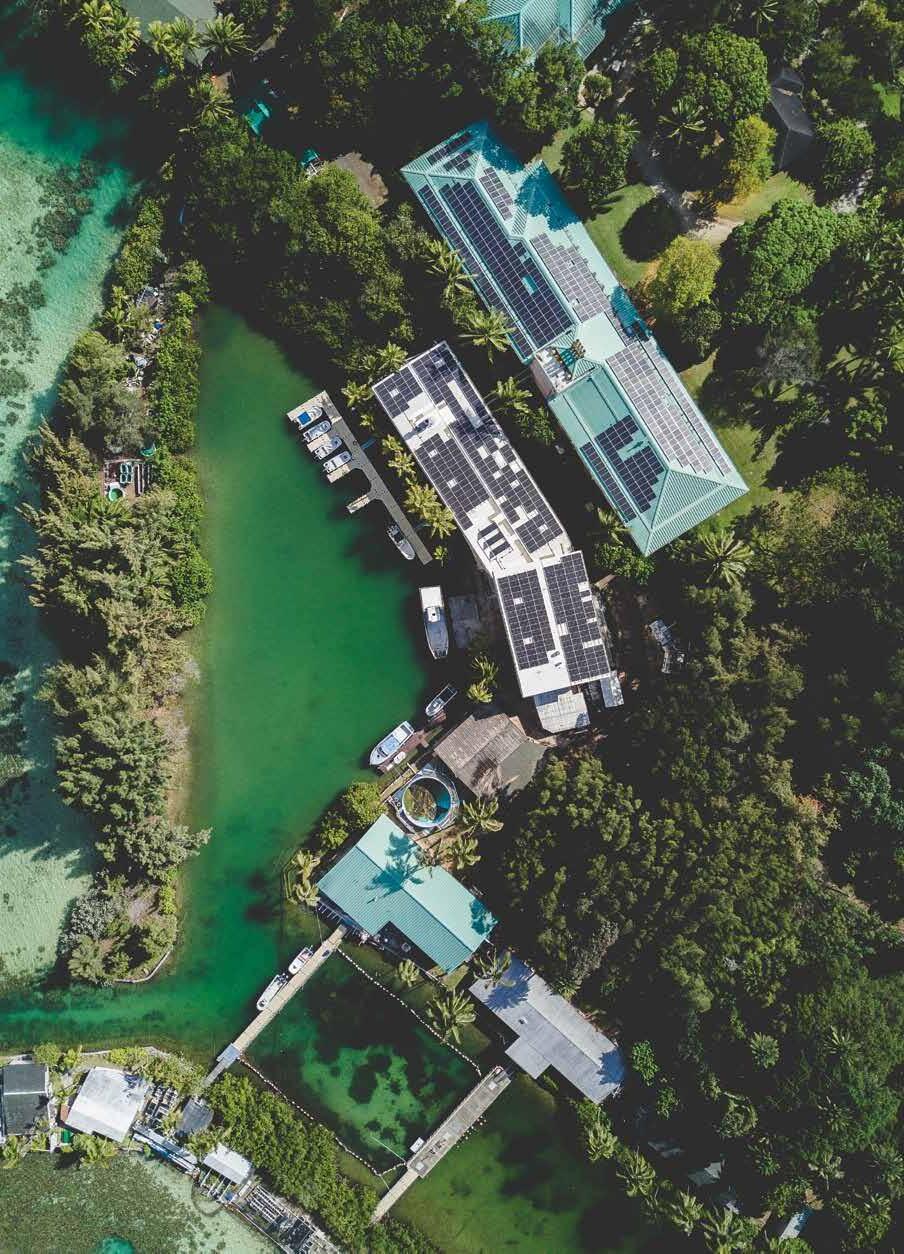
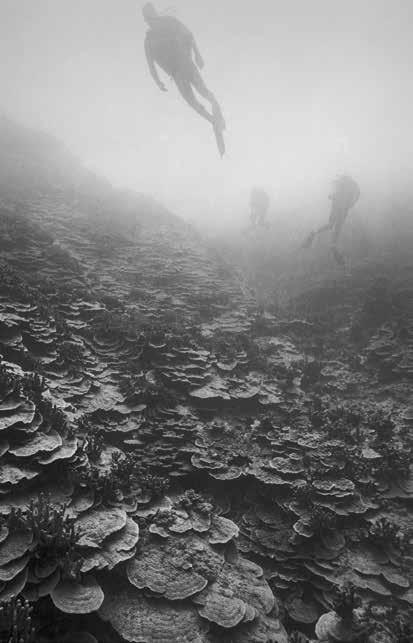
Researchers on Coconut Island made headlines for their innovative work of selectively breeding heat-tolerant corals, like those found in Kāne‘ohe Bay.
One spring, I made the multi-leg journey there to visit the Coral Resilience Lab. Founded in 2003 by marine biologist Ruth Gates, the lab has produced some of the world’s most important coral research. Gates gained international recognition when she issued a clarion call for the world’s coral—Earth’s coral reefs were in serious trouble, Gates insisted in interviews with National Public Radio and National Geographic. The oceans were warming, and corals couldn’t keep up.
Like most living things, corals are capable of adapting to environmental conditions, but the Earth’s oceans are warming too rapidly for most coral species. In 2013, Gates experimented with something she called “assisted evolution.” The idea was to artificially accelerate the process of natural selection and engineer “super coral” that could withstand the predicted increases in ocean temperatures. The work consisted of old-fashioned selective breeding, the same technique used to create everything from golden delicious apples to golden doodle puppies. Gates’ team took samples of reef-building corals found in Kāne‘ohe Bay that exhibited higher than average thermal tolerance and bred them with other corals, with the goal of producing more resilient offspring.
Gates’ work made international headlines. The Economist and Netflix produced documentaries about her research, and she was a fixture on Hawai‘i Public Radio. Then, on October 25, 2018, at the age of 56, Gates died of complications related to surgery for diverticulitis. The scientists at the Coral Resilience Lab, known then as the Gates Coral Lab, grieved the loss of their charismatic leader, even as they endeavored to continue her groundbreaking research. Taking over as principal investigator was Crawford Drury, whom everyone called Ford. When we first met outside the lab, he wore shorts and sunglasses and a backwards baseball cap. Neither he
ある春の日、私はそんなふうに車とボートを乗り継いで、コーラル・レジリ エンス・ラボを訪れた。海洋生物学者の故ルース・ゲイツさんが2003年に設立 し、サンゴの研究において世界的に重要な成果を挙げてきたラボだ。「地球上 のサンゴ礁は深刻な問題を抱えている」ゲイツさんはナショナル・パブリック・ ラジオや『ナショナルジオグラフィック』誌のインタビューで警鐘を鳴らし、世 界的に有名になった。「海の温暖化のスピードに、サンゴは追いつけていない」 彼女はそう訴えた。
他の生物と同様、サンゴも環境に適応する能力を備えているが、海の温 暖化が急速すぎてほとんどの種が適応できていない。2013年、ゲイツさんは 「アシステッド・エボリューション(補助を伴う進化)」と名付けたある実験を行 った。これは、自然淘汰のプロセスを人工的に加速させ、予測される海水温の 上昇に耐えられる「スーパーサンゴ」を生み出すというもの。りんごの交配種ゴ ールデンデリシャスや、人気の雑種犬ゴールデンドゥードゥルを生み出したの と同じ、昔ながらの品種改良法だ。カネオへ湾に生息する造礁サンゴのうち、 平均以上の温度耐性を持つサンゴを採取し、他の種類のサンゴと交配させる ことで、より強い種をつくり出そうとしたのだ。 この実験は国際的なニュースとなり、『エコノミスト』誌やNetflixがゲイ ツさんの研究に関するドキュメンタリーを制作し、ハワイのパブリックラジオで
122 PALM E ESCAPES Coconut Island
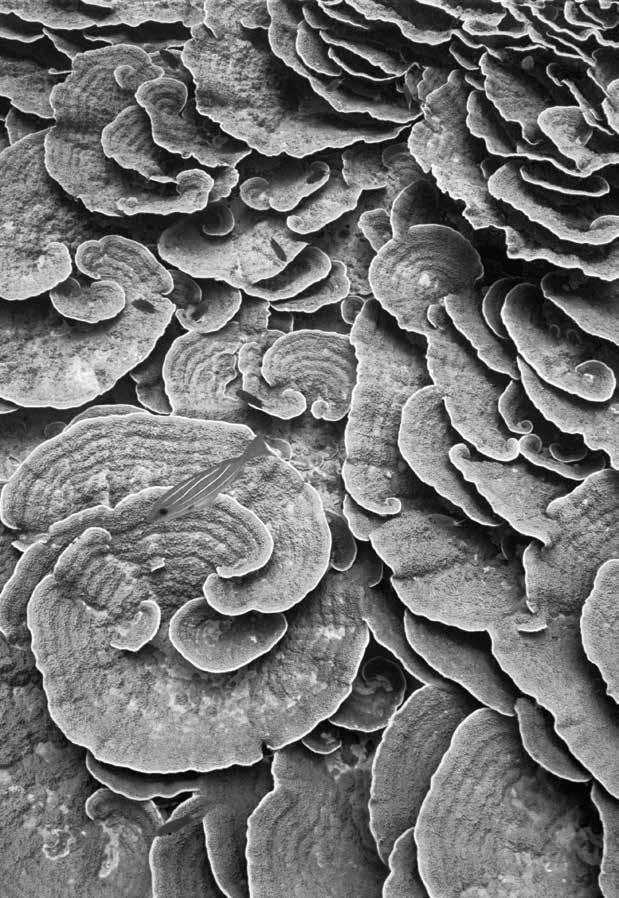 The Coral Resilience Lab on Coconut Island was established by the late Ruth Gates, a pioneer in the field of coral conservation.
The Coral Resilience Lab on Coconut Island was established by the late Ruth Gates, a pioneer in the field of coral conservation.

nor the institute were what I expected. I had imagined someone older, maybe wearing a white lab coat. And the island, well, it felt less like a place that produced worldclass research than a science experiment that had gone awry, a Frankenstein of dredged earth and mysterious ruins held together by fossilized bags of Quickcrete.
Coconut Island is traditionally known as Moku o Lo‘e, or the land of Lo‘e, named after one of four siblings who, stories say, traveled from Wai‘anae to make their home on O‘ahu’s windward shore. In the early 20th century, the island was purchased by entrepreneur Christian Holmes, who for much of the 1930s, used the island for a tuna cannery as well as a private retreat. He dredged the bay to expand the island, cutting trenches in the reef and building long, spindly fingers of land that stretched out as if to touch Kāne‘ohe. He added a house, a bowling alley, a shooting range, even a saltwater swimming pool.
Everywhere I looked, Holmes’ follies peeked through the foliage: large lava rock walls, stairs that led to nothing but jungle. Just inland from the now-abandoned swimming pool, a low-slung building housed a series of guest rooms, one of which was being cleaned by a young woman. She said the rooms were used by visiting researchers. When I mentioned all the strange ruins, she explained that the island used to be a zoo. “The elephant ponds were down there,” she said, pointing over the hill. Indeed, Holmes had a thing for animals. He imported monkeys, a giraffe, a baby elephant to the island. When he died in 1944, the animals became some of the first residents of the Honolulu Zoo. For a few years following, the island was used for R&R for Marine officers, which is how the barracks came to be built. A group of five oil and gas executives then bought the island in 1947, after which one named Edwin Pauley became the sole owner.
も頻繁に取り上げられた。だが2018年10月25日、ゲイツさんは憩室炎の手 術後の合併症により56歳の若さで帰らぬ人となる。当時はゲイツ・コーラル・ ラボと呼ばれていたコーラル・レジリエンス・ラボの科学者たちは、カリスマ的 リーダーの死を悼みながらも、彼女がはじめた革新的な研究を続けた。ゲイツ さんのあとを引き継ぎ、新たに研究の中心となったのは「フォード」の愛称で親 しまれるクロフォード・ドゥルーリーさん。研究所の前で初めて会ったドゥルー リーさんは、野球帽を後ろ前にかぶり、短パンにサングラスというラフないでた ちだった。ドゥルーリーさんにも研究所の建物にも、私の予想は裏切られた。ド ゥルーリーさんは白衣を着た年配の科学者ではなかったし、島そのものも、世 界的な研究所というよりは、むしろ実験が失敗して生まれたフランケンシュタ インを思わせる、コンクリートでつぎはぎされた謎の廃墟といった風情だった。 ココナッツアイランドは、もともとモク・オ・ロエ(Moku o Lo’e、ロエ の地)と呼ばれていて、オアフ島のワイアナエに住んでいた四兄弟のうち、ウ ィンドワードに移り住んだひとりにちなんで名付けられたという伝説が残っ ている。20世紀初頭、島はクリスチャン・ホルムスという起業家に買い取ら れ、1930年代はマグロの缶詰工場や個人の別荘として使用されていた。ホル ムス氏は砂をさらい、サンゴ礁に溝を堀り、カネオヘに届きそうな細長い埋め 立て地を作って島を拡張し、邸宅、ボウリング場、射撃場、さらには海水プール までつくってしまった。
大きな溶岩石の壁やジャングルにしか通じていない階段など、ホルムス 氏の愚行は島のあちこちに見受けられる。今はもう使われていないプールから 少し内陸に入ったところにある平屋の建物にはいくつかのゲストルームがあ り、若い女性が掃除をしていた。島を訪れる研究者たちの宿泊施設として使わ れているのだという。島のあちこちにある奇妙な廃墟の話をすると、女性は「こ の島は昔、動物園だったんです」と説明してくれた。「あそこに象の池があったん ですよ」と丘のほうを指差しながら彼女は言った。
124 PALM E
ESCAPES Coconut Island

Pauley hosted renowned guests including, presidents Harry Truman and Richard Nixon, on Coconut Island, and he also helped establish a marine research lab there. The facility eventually evolved into the Hawai‘i Institute of Marine Biology, an independent research station of UH Mānoa’s School of Ocean and Earth Science and Technology. In 1995, Pauley’s family donated $2 million to the University of Hawai‘i Foundation to help it purchase the island outright.
Coconut Island was still a menagerie of sorts when I arrived, though one with more scientific purpose than Holmes had in mind. Its most dramatic residents were the sharks, which cruised a small pond on the east side of the island, their tails flicking in a way that seemed almost feline. Just down the road was the lab, with its hundreds, if not thousands, of corals.
Drury explained that when coral reefs are subjected to abnormal temperatures for extended periods of time, the corals expel their zooxanthellae, a type of symbiotic algae, which turns the reef a ghostly white. This is what’s known as coral bleaching. Without the zooxanthellae, which provide corals with food and oxygen in exchange for shelter, the organisms are far more susceptible to disease and stress. It was something the scientists had seen firsthand. Between 2014 and 2015, more than half of Hawai‘i’s reef-building corals bleached. It was unprecedented. And it endangered not only Hawai‘i’s reefs but also the many hundreds of marine creatures— and human livelihoods—that depended on them.
In lieu of any meaningful action taken by U.S. lawmakers, scientists were being forced to take the lead on averting a climate catastrophe, Drury said, and there had been a noticeable shift in how researchers approached a subject like coral bleaching. Historically, scientists simply wanted to know how things were. Increasingly, they advocated for how they should be.
Drury’s team didn’t know why some corals were more thermally tolerant than others. But on some level, it didn’t matter. If they could build coral reefs that would survive the coming conditions, that was what they were going to do.
Coral reefs are vital not only to the health of the marine ecosystem—single-handedly supporting 25 percent of all ocean life—but to coastal communities around the globe, including in Hawai‘i. A coral reef is a natural defense against large waves and storm surges, which could otherwise destroy beaches, houses, and coastal infrastructure. When a reef dies, it doesn’t take long for the underlying structure to degrade. If it collapses entirely, any coastal protection provided by the reef goes with it. Surf breaks could disappear, along with beaches. Rising sea levels would become all the more menacing.
In the end, none of this is about coral. It’s about noticing. It’s about looking around and seeing not an island or an ocean but our collective home. It’s about acknowledging the interminable complexity that undergirds our world, that bright cord that binds us to Earth and to one another. It’s about our species’ endless quest for reciprocity, for symbiosis, for a way of life that leads not to grief but gratitude.
ホルムス氏は大の動物好きで、サルやキリン、赤ちゃん象などを島に輸入 した。1944年に彼が亡くなると、動物たちはホノルル動物園に移され、園の最 初の住人の仲間入りをした。その後の数年間、島は海兵隊の保養施設として 使われた。島にバラックがあるのはそのためだ。1947年、石油やガス会社の5 人の重役たちが島を共同購入し、やがてエドウィン・ポーリー氏個人の所有と なる。ポーリー氏は、ハリー・トルーマン大統領やリチャード・ニクソン大統領を はじめ著名な人々を島に招き、海洋研究所の設立にも貢献した。それが前身と なり、やがてハワイ海洋生物学研究所(ハワイ大学マノア校海洋地球科学技術 学部の独立研究機関)へと発展していく。1995年、ポーリー家はハワイ大学 基金に200万ドルを寄付し、それをもとにハワイ大学が島を買い上げた。
私が降り立ったココナッツアイランドは、ある意味では今も動物園だが、 ホルムス氏が考えていたよりずっと科学的な使命を帯びている。もっともドラ マチックな住人はサメだ。島の東部にある小さな池で、ネコ科の動物の尻尾の ようにゆっくりと尾びれを左右に揺らしながら、ゆうゆうと泳いでいる。そこか ら少し行ったところに数百、いや数千ものサンゴが集められたコーラル・レジリ エンス・ラボがあった。
ドゥルーリーさんの説明によれば、異常な温度に長時間さらされたサン ゴは共生藻の一種である褐虫藻を排出してしまうため、ゴーストのように白く なってしまう。いわゆる「サンゴの白化」だ。外敵から身を守るシェルターを提供 してもらう代わりにサンゴに食べ物や酸素を供給していた褐虫藻がいなくなる
と、サンゴは病気やストレスの影響を受けやすくなる。研究者たちもその現象 を目の当たりにした。2014年から2015年にかけて、ハワイの造礁サンゴの半 分以上が白化したのだ。前代未聞の事態だった。この現象によりハワイのサン ゴ礁だけでなく、それに依存する何百もの海洋生物、そして人々の生活手段も が危険にさらされた。
米国政府はなかなか具体的な対策を講じず、気候の変動による大惨事 を回避するためには科学者たちが率先して動かざるを得なくなり、その結果、 こうしたテーマに対する研究者のアプローチが大きく変化した。ドゥルーリー さんは説明する。それまで「ものごとについて理解する」ことだけが目的だった のに、次第に「あるべき姿」を追究するようになったのだ。
ある種のサンゴが他の種よりも温度耐性が高い理由はまだ解明できて いないが、理由はともかく、これからの環境に耐えうるサンゴを作れるのなら研 究を続ける意味がある。
海洋生物全体の25%を一手に支えるサンゴ礁は、健全な生態系を守る ために欠かせない存在であるだけでなく、ハワイはもちろん、世界の沿岸を守 る役割も果たしている。津波や高潮からビーチや家屋、インフラを守る天然の 防御壁であるサンゴが死滅すれば、その土台となる部分もすぐに劣化してしま う。サンゴ礁が完全に崩壊すれば、沿岸の防御機能も失われる。サーフィンで きる波もビーチも姿を消してしまうかもしれない。海面上昇の脅威もいっそう 切実になるだろう。
結局のところ、これは単なるサンゴの研究ではなく、気づくきっかけなの だ。ただ島や海というだけではなく、地球全体を自分たちのすみかとして捉え る。世界は複雑な仕組みでお互いを支え合っている。われわれはこの地球と も、そしてお互い同士ともしっかり結ばれた運命共同体だ。お互いに与え合い、 共存し、悲しみではなく喜びを感じて生きていく方法を求めて終わりなき探求 を続けていくべきなのだ。
126 PALM E ESCAPES Coconut Island

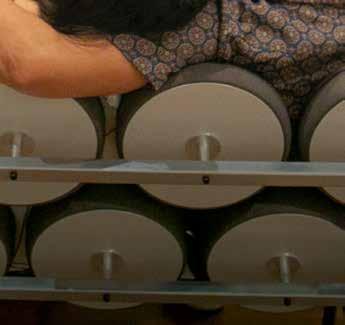
Cultivating creativity, wonder, and deeper connections to the world we share.

EXTENDED EVENING HOURS FRI & SAT 4-9PM
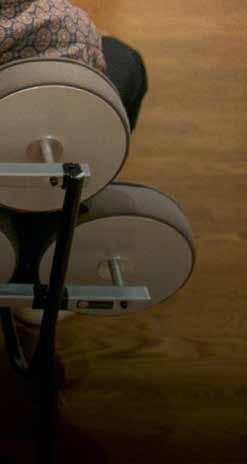
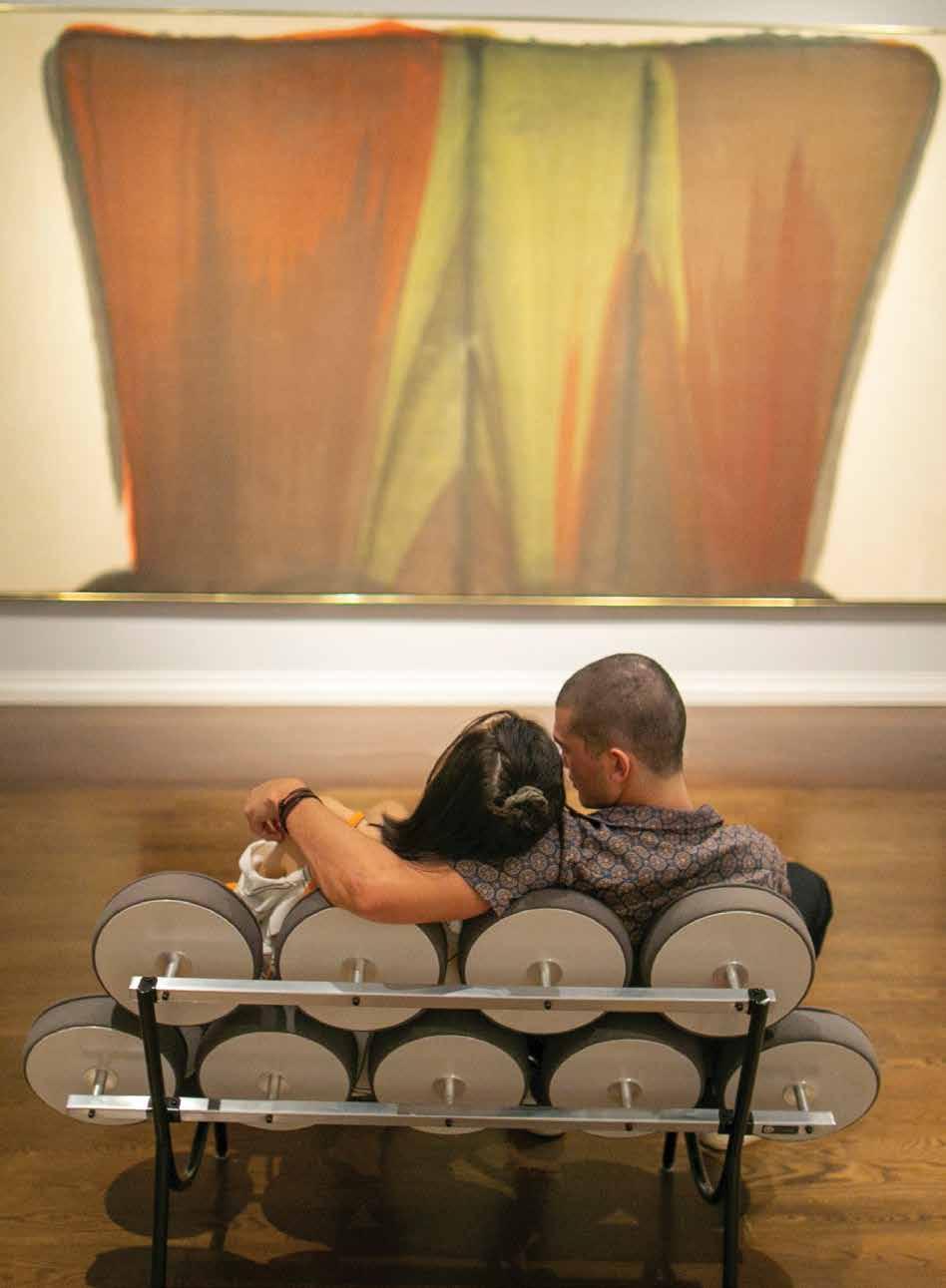

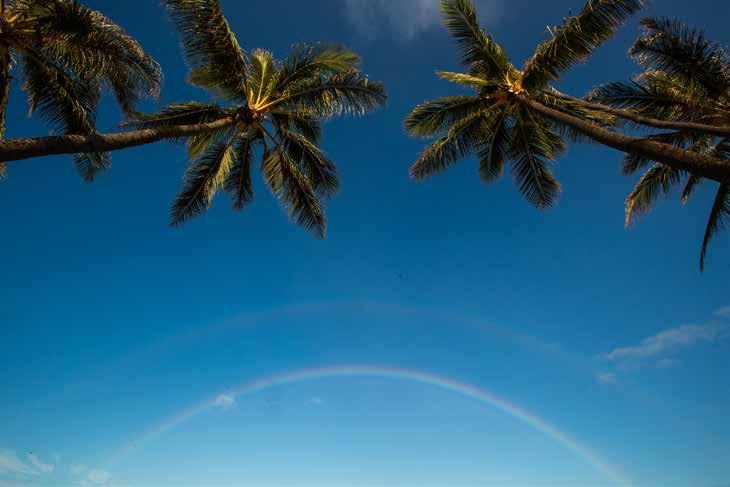
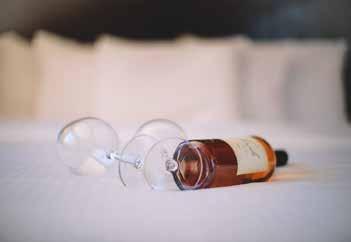
steps from waikiki beach An intimate oceanside escape for active travelers who prefer to explore Oahu o the beaten path. Whether traveling as a couple, small group, or even solo, MacNaughton owned and operated Hotel Renew is the perfect expression of mid-century meets modern tropical design. With spa-worthy bath amenities, exercise equipment for in-room use, and alluring views of the Pacific Ocean and Waikiki, this boutique oasis will sweep you o your feet. www.hotelrenew.com 808.687.7700 129 Paoakalani Avenue Honolulu, Hawaii 96815
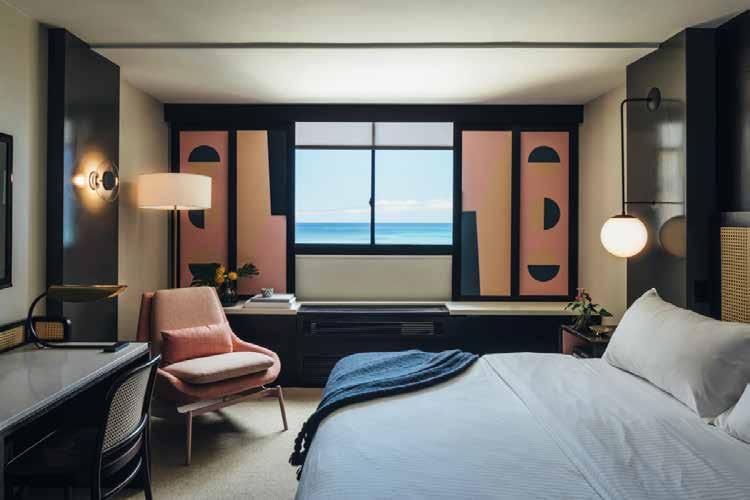
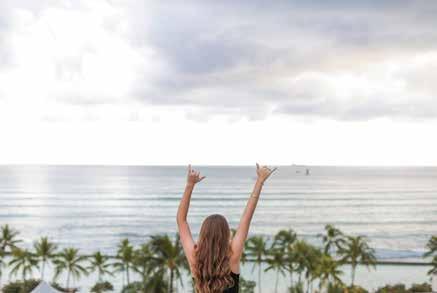
Use promo code "VIP" when you book and save 10% o our best flexible rate.
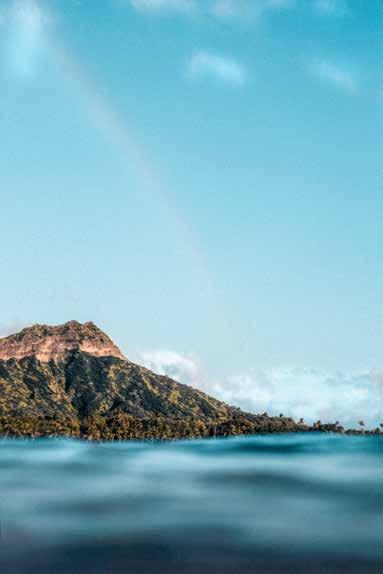
FA RE
Culinary delights and F PALM 食 PALM
delectable hidden
gems
131
F PALM
Baked with Aloha
アロハなおやつを召し上がれ 文 = キャスリーン・ウォン
写真 = リラ・リー
132 PALM FARE Pastries F
Text by Kathleen Wong
Images by Lila Lee

At pastry shops across the island, cultures clash in the sweetest ways possible.
ハワイのあちこちのベーカリーでは、多 様な文化が生んだ甘いパンやドーナツ がおいしさを競い合っています。
The small fuchsia plastic bag is hot to the touch. I open it and a geyser of steam releases into the air. I eagerly reach my hand in, my fingertips grazing a fresh malasada dusted in sugar crystals. Taking the first bite, my teeth break through the deep-fried skin and sink into the fluffy, still-warm doughnut flesh. The pressure causes sweet haupia cream to gush out. It tastes like bliss.
Since I was young, a visit to Leonard’s Bakery has been a mustdo whenever an out-of-towner visits, or if I’m feeling indulgent, or when I need some cheering up. Pre-pandemic, I’d wait in line near the shop’s small bake case, which showcases other treats like pao doce (sweet bread) and butter mochi. My sister would get a cinnamon sugar malasada, and my sweet tooth would drive me to the haupia-filled one.

If you look for malasadas in Honolulu, you’re guaranteed to come across Leonard’s Bakery, located on Kapahulu Avenue. Leonard Rego, the son of sugarcane plantation workers from São Miguel in the Azores, opened his namesake bakery in 1952, but it wasn’t until the following year that he added malasadas to the menu, crafting them using his grandparents’ recipe. Since then, Leonard’s Bakery has been a mainstay for malasadas in Hawai‘i.
For many locals, it’s hard to imagine a Hawai‘i without its beloved malasadas. And thanks to an influx of cultures that began in the plantation era and continues today, they’re one of many mouthwatering baked goods as uniquely multicultural as Hawai‘i itself. It doesn’t hurt that they’re all absolutely delicious.
フクシアピンク色の小さなビニール袋。中にはでき たて熱々のドーナツが入っている。袋を開くと、ほわ っと蒸気が上がる。たまらず袋に手を入れて、砂糖 をたっぷりまぶした揚げたてのマラサダに触れる。 さっそくひと口。カリカリの皮に歯をたて、まだ温か いふわふわのドーナツ本体にかぶりつく。とろりと 飛び出すココナッツ風味の甘いハウピアクリーム。 う〜ん、シ・ア・ワ・セ。
わたしが幼い頃からおなじみのレナーズベー カリーは、遠くから人が遊びに来たときや、自分に ご褒美をあげたいとき、元気になりたいときに必ず 訪れる店だ。コロナ禍前は、パオドースィ(スイート ブレッド)やバターモチなどが並ぶ小さなショーケ ース前に並んで順番を待った。姉はシナモンシュガ ー派で、激甘スイーツ好きの私のお気に入りはハウ ピアクリーム入りだ。
ホノルルでマラサダを探せば必ず行き当たる のがカパフル通りにあるこのレナーズベーカリー。 ポルトガル領アゾレス諸島にあるサンミゲル島出身 の創設者レナード・レゴさんは、サトウキビのプラン テーション労働者の息子だ。1952年、自分の名前 を冠したベーカリーをオープンし、翌年、祖父母伝 来のレシピで作ったマラサダをメニューに加えた。 それ以来ずっと、ハワイでマラサダといえばレナー ズ、といわれる老舗ベーカリーなのだ。 多くのローカルが、マラサダのないハワイな んて考えられないという大人気のおやつ。プランテ ーション時代から現在にいたるまでさまざまな文 化が流入したおかげで、多文化の魅力あふれる場 所となったハワイには、マラサダのように異国から 来たおやつがたくさんある。そのどれもが抜群に美 味しいのだから言うことなしだ。
Translation by Mikiko Shirakura 翻訳 = 白倉三紀子
134 F FARE Pastries
아일랜드 전역에 있는 페이스트리샵의 컬쳐 들이 가장 달콤한 방식으로 충돌합니다.
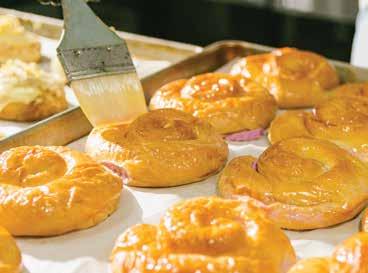
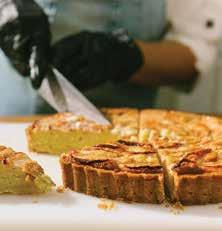
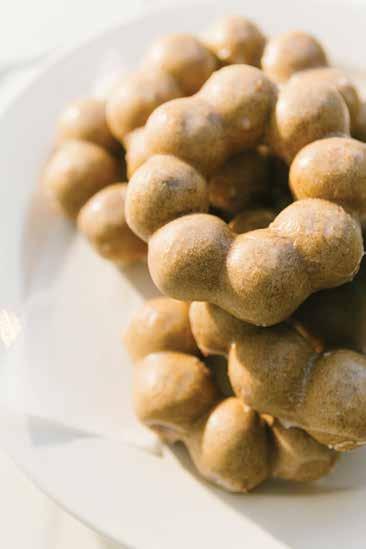
Thanks to an influx of cultures that began in the plantation era and continues today, the islands are home to an array of mouthwatering baked goods as uniquely multicultural as Hawai‘i itself.
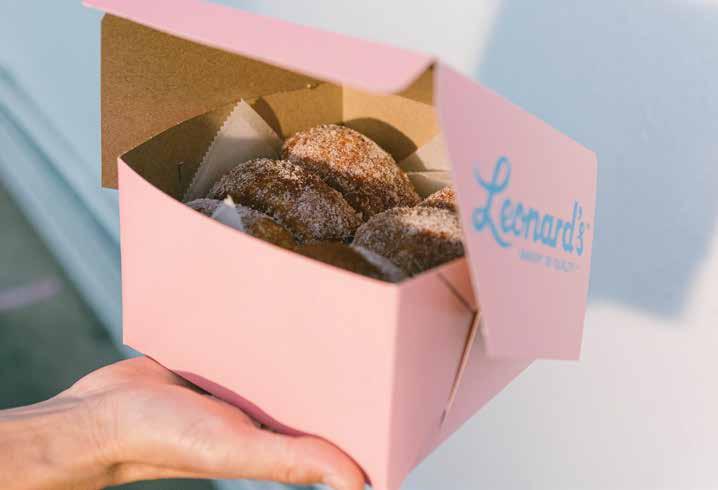
MALASADA
It’s believed that Portuguese immigrants from the Madeira and Azores islands brought malasadas over in the late 1870s when they came to work on Hawai‘i’s sugar and pineapple plantations. These workers already had experience working with sugarcane back on their respective home islands. In Portugal, the malasada has a cousin: a fried, globe-shaped doughnut called filhó. According to food historians, what separates the malasada from other doughnuts is its eggy dough made with evaporated milk, a departure from the typical yeast dough made with fresh milk. Here in Hawai‘i, malasadas have adopted local flavors and ingredients, like the haupia- or guava-filled choices at Leonard’s. These doughnuts are often eaten on Mardi Gras or Fat Tuesday, also known as Malasada Day in Hawai‘i.
マラサダ
マラサダは、サトウキビやパイナップルプランテーションの労働者として 1870年代後半にマデイラ諸島やアゾレス諸島からハワイにやって来たポ ルトガル系移民が持ち込んだとされている。故郷の島のサトウキビ畑でも 働いた経験のある人たちだ。ポルトガルには「フィリョ」と呼ばれるマラサダ の従兄弟のようなボール状のドーナツがある。食文化史の研究家によれ ば、マラサダとドーナツとの違いは、ドーナツはフレッシュミルクを使ったイ ースト生地で作るが、マラサダはエバミルク(無糖練乳)と卵を使った生地 で作る点だ。
ハワイならではのフレーバーや素材を取り入れたマラサダもあり、レ ナーズにはココナッツ味のハウピアクリームやグァバクリーム入りのマラサ ダがある。ハワイではマラサダデーとも呼ばれるマルディグラやファットチ ューズデイに食べられることも多い。
136 F FARE Pastries
PALM

SPANISH ROLL
Soft and warm are the hallmarks of freshly baked bread, but Spanish rolls have an extra oomph—a subtle, buttery sweetness. It’s easy to lose count of how many crescentshaped breads you’ve eaten in one sitting. Interestingly, Spanish rolls are a misnomer; they originally hail from the Philippines but can be traced to Spanish colonization of the islands in the 16th century. The baked goods are similar to ensaymadas, another sweet bread from Mallorca, Spain, or the classic Filipino bread called pandesal. Filipinos adopted bread-making techniques from the Spanish, such as using salt and sugar, and made them their own.
Opened by Filipino immigrant Fernando H. Paez, Nanding’s Bakery remains the same small, unassuming panaderia (bakery) it has been for over 20 years. On O‘ahu, you can visit the bakery’s three locations, or you can find its signature Spanish rolls at 7-Elevens statewide. For a modern, local spin on Spanish rolls, Beyond Pastry Studio in downtown Honolulu offers a mango-pineapple version. “I like to bake what I grew up with, like pandesal and Spanish rolls with chicken adobo, because I want to share that happiness with other people,” says Cristina Nishioka, its Philippines-born owner and pastry chef. “I wanted to raise the standard and elevate Filipino pastries, and to give more options to a good, quality pastry.” It’s believed that Portuguese immigrants from the Madeira and Azores islands brought malasadas over in the late 1870s when they came to work on Hawai‘i’s sugar and pineapple plantations. These workers already had experience working with sugarcane back on their respective home islands. In Portugal, the malasada has a cousin: a fried, globe-shaped doughnut called filhó. According to food historians, what separates the malasada from other doughnuts is its eggy dough made with evaporated milk, a departure from the typical yeast dough made with fresh milk.
KOUIGN-AMANN
While the plantation era had significant influences on Hawai‘i’s palate, cultures continue to borrow from each other today. The kouign-amann, pronounced “queen-amahn,” is a flaky pastry that looks like a mix between a croissant and a palmier. Although the exact origins of the buttery pastry is a mystery, signs point to Finistère, the westernmost tip of the French region Brittany, also home to the galette. People from the Finistère town of Douarnenez have even formed a kouign-amann association to protect the integrity and heritage of the rustic pastry. At Kona Coffee Purveyors’ B. Patisserie, which hails from San Francisco, the kouign-amann pastries come in tropical and Asian flavors. The pastry menu changes seasonally, based on what’s locally available, but expect flavors like guava coconut almond, coconut lychee, and black sesame. “Our inspiration comes from the fruit of our land,” says Kona Coffee Purveyors co-founder Jacqueline Suiter.
スパニッシュロール
温かくてフワフワというのが焼きたてパン最大の魅力だが、スパニッシュロール の場合はそこに、バターたっぷりでほのかに甘い、という魅力が加わる。三日月
型のこのパン。食べはじめるとついつい手が伸びて、いつのまにかたくさん食べ てしまう。面白いことに、名前はスパニッシュロールでも、じつはスペインではな くフィリピンが発祥の地なのだ。とはいえ、16世紀にスペインがフィリピンを植 民地化したことに由来しているのかもしれない。スペインのマヨルカ島の甘い パン「エンサイマダ」やフィリピンでは定番の「パンデサル」によく似ている。フィ リピンの人々は、塩や砂糖を使うスペイン流のパン作りの技術を取り入れ、独 自のパンを生み出した。
フィリピンから移住してきたフェルナンド・H・パエズさんがオープンした ナンディングスベーカリーは、こぢんまりとした気取らないパナデリア(ベーカリ ー)として、20年以上前から営業を続けている。オアフ島の店舗は3つだが、名 物のスパニッシュロールはハワイ州内のセブンイレブンで購入できる。
ホノルルのダウンタウンにあるビヨンド・ペストリー・スタジオでは、モダ ンにハワイらしくアレンジしたマンゴーパイナップル風味のスパニッシュロール を提供している。フィリピン出身のオーナー兼パティシエ、クリスティーナ・ニシ オカさんは語る。「鶏肉の煮込み料理アドボと一緒に食べるスパニッシュロー ルやパンデサルなど、自分が小さい頃から食べてきたパンをお届けしたいと思 っています。フィリピン風ペイストリーのレベルを引き上げ、質の高いペイストリ ーの幅を広げたかったんです」
クイニーアマン
プランテーション時代はハワイの食文化に大きな影響をもたらし、さまざまな 文化は今も互いに融合し合っている。クイニーアマンは、クロワッサンとパルミ エを合わせたようなサクサクした食感のペイストリーのことだ。バターをたっぷ り使ったこのお菓子の正確な起源は分かっていないが、ガレットの故郷である フランス、ブルターニュ地方の最西端、フィニステール県が発祥の地とされてい る。フィニステール地方のドゥアルヌネという町では、この素朴なペイストリー の伝統と真正性を守るため、クイニーアマン協会が発足したのだとか。コナ・コ ーヒー・パーベイヤーズに併設されたサンフランシスコ発のベーカリー「B・パ ティスリー」では、トロピカルフレーバーやアジアンフレーバーのクイニーアマン を販売している。地元の旬の食材に応じてメニューは季節ごとに変わるが、グ ァバ・ココナッツ・アーモンド、ココナッツ・ライチ、黒ごまなどのフレーバーを楽 しめる。コナ・コーヒー・パーベイヤーズの共同設立者であるジャクリーン・スイ ターさんは「ハワイのフルーツからインスピレーションを得て、メニューを考案 しています」と教えてくれた。
138 B PALM FARE Pastries

 MOCHI DOUGHNUT
MOCHI DOUGHNUT
Mochi is known for its sticky, chewy texture and ability to slowly revert to its original shape if you push your finger into its soft, pillowy surface. Mochi came to Hawai‘i from Japan by way of plantation workers in the 19th century. Since then, rice flour has become a popular replacement for wheat flour in local baked goods, giving the mochi versions a light, springy texture.
Inspired by Japan’s mochi donut craze, O‘ahu’s famed Liliha Bakery introduced the poi mochi donut in 2016. Entering Liliha’s bustling flagship location in Kalihi, I grab a number and wait for it to be called. As I wait, workers in white shirts and black aprons haul baking trays heavy with freshly baked doughnuts. At Liliha Bakery, they deep-fry sweet rice flour mixed with fresh, locally made poi, or taro, to make the doughnut: eight glazed balls linked together in the shape of a ring. I gently pull the doughnut apart and admire the vibrant purple inside. I pop a purple doughnut ball into my mouth for a surprisingly delicate treat.
モチドーナツ
指で押しても枕のような元のかたちにゆっくり戻る、噛みごたえのあるべたっと した食感が特徴の餅。日本からやってきたプランテーション労働者により、19 世紀にハワイに持ち込まれた。以来、軽くてもっちりした食感をもたらす米粉 は、小麦粉の代わりにパンや焼き菓子にもよく使われるようになった。
日本の「もちもち食感ドーナツ」ブームに触発され、2016年にポイ・モ チ・ドーナツを発売したのは、オアフ島の有名店リリハベーカリーだ。カリヒ にある賑やかな旗艦店に入った私は、番号札を手に取り、自分の番号が呼 ばれるのを待った。白いシャツに黒いエプロンをつけたスタッフが、焼きたて のドーナツがぎっしり並ぶ天板を運んでいる。ツヤツヤのグレーズでコーテ ィングされた8つのボールがリング状につながったドーナツ。甘い米粉に地 元産の新鮮なポイ(タロイモ)を混ぜた生地で作られている。そっとちぎると 鮮やかな紫色の生地が現れる。口に放り込んだ紫色のドーナツボールは、驚 くほど繊細な味わいだ。
140 PALM F FARE Pastries

A citywide exhibition of contemporary art from Hawai‘i, Asia-Pacific, and beyond
FEB 18— MAY 8, 2022
BISHOP MUSEUM FOSTER BOTANICAL GARDEN
HAWAII THEATRE CENTER
HAWAI ‘ I STATE ART MUSEUM
IOLANI PALACE
HONOLULU MUSEUM OF ART
ROYAL HAWAIIAN CENTER


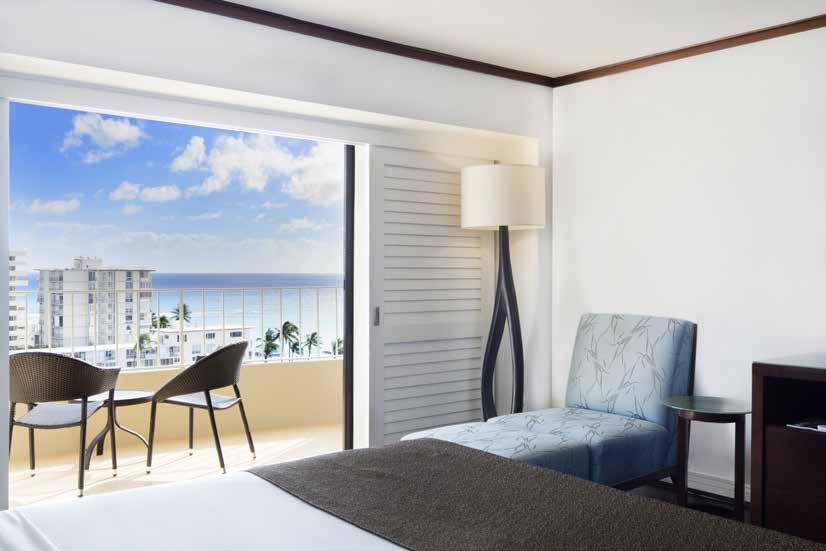
Seamless Blend of Island Living & Adventure
Tucked away along the Gold Coast of Waikiki is a haven welcoming you home. Unwind with upscale, personalized touches, pamper yourself with boutique amenities, or soak up sun and sand at the beach just steps away. We invite you to experience a different side of Waikiki at the MacNaughtonowned and operated Lotus Honolulu at Diamond Head.
Located on the second floor of Lotus Honolulu is TBD… by Vikram Garg, a contemporary and relaxing dining oasis featuring French classics curated with culture. For an unparalleled connoisseur experience, ask about Chef Vikram’s bespoke TABLE V.
Use promo code "VIP" when you book an Ocean View Premium room and receive a complimentary welcome bottle of prosecco www.lotushonoluluhotel com 1 808 922.1700 | 2885 Kalakaua Avenue, Honolulu, Hawaii 96815
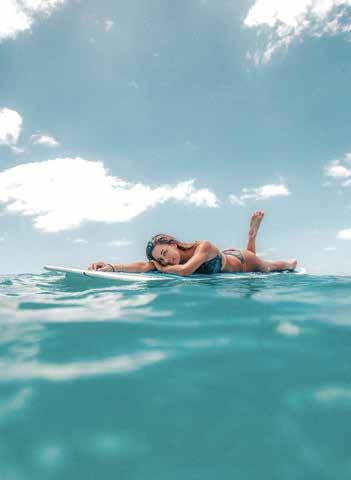

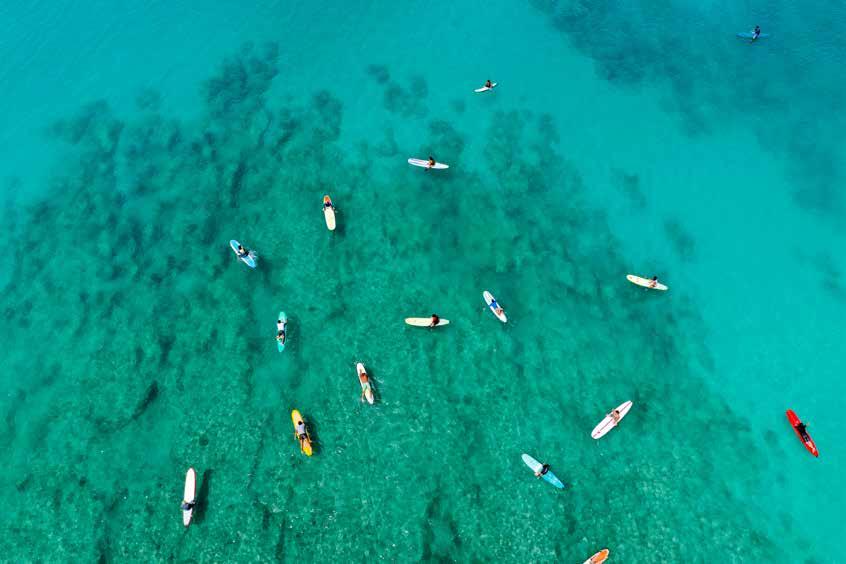
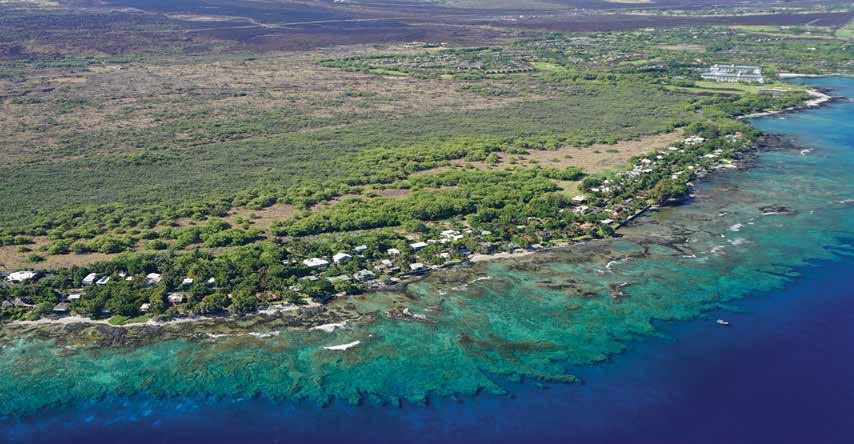
A Climate Of Change, A World Of Solutions
Climate change is all around us.
There is no question, we are seeing more frequent and severe storms, fires, and flooding around the world. And with them, astounding loss of lives, homes, neighborhoods, and wildlife habitat.
We can adapt.
We have the science, tools, and knowledge to set the planet on a course of correction and our islands on a course of recovery, but we need to muster the willpower and invest in the solutions that are available to us now while we develop new solutions to this crisis.
Working with nature is the most promising and cost-effective solution.
Nature-based solutions build resilience in the systems that protect us from the impacts of climate change, such as coral reefs, wetlands, and dune systems that protect our coastal infrastructure and communities from storm surge and flooding.
The time to act is now.
Scientists estimate that the next 10 years will be the defining decade for our climate future. In Hawai‘i, The Nature Conservancy is applying nature-based solutions from mauka to makai (the mountains to the sea) to chart a course toward greater resilience and sustainability.
Drawing on decades of experience and global expertise, The Nature Conservancy is uniquely positioned to develop and deliver natural climate solutions so that nature and people can thrive in a changing climate. Will you join us?
Contact: Lori Admiral | Director of Philanthropy 923 Nu‘uanu Avenue | Honolulu, HI 96817 | lori.admiral@tnc.org | 808-587-6249
Photo: Chad Wiggins


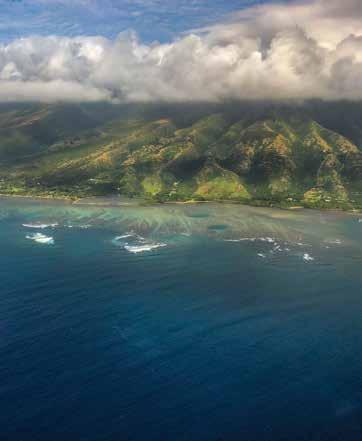
Increase carbon storage to reduce the impact of emissions
To minimize global temperature increases, we must increase carbon mitigation efforts, which include land stewardship. Each year, The Nature Conservancy manages 40,000 acres of native forest in Hawai‘i preserves, continually removing invasive plants and building fences to minimize threats to these critical natural areas.
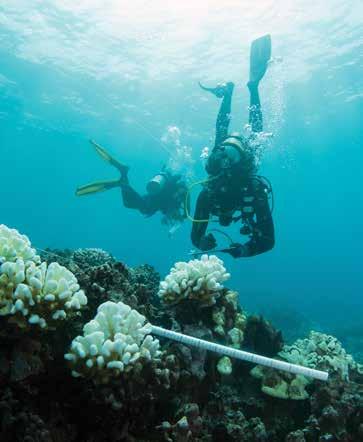
Advance climate science
Research, monitoring, and modelling provide us with a better understanding of climate impacts, which will help to ensure that we invest in the most promising strategies for climate mitigation and adaptation. The Nature Conservancy is working to unlock the secrets of the remarkably resilient reefs on Palmyra Atoll and investing in other reef resilience research to ensure funds are directed to reefs most likely to withstand future climate impacts.
Establish innovative funding streams for nature-based solutions
The Nature Conservancy has pioneered innovative financing mechanisms for conservation, including debt for nature swaps, blue carbon, and the world’s first reef insurance policy. Following a feasibility study showing that reef insurance is viable in Hawai‘i, The Nature Conservancy is working with insurance companies to develop a policy to fund the repair of reefs damaged by hurricanes.
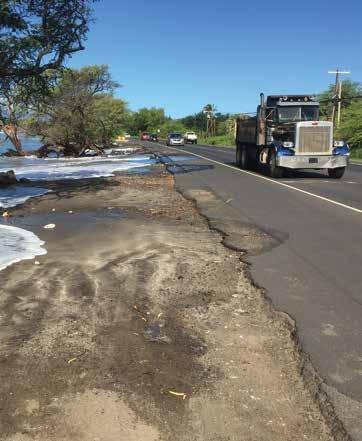
Demonstrate the value of green infrastructure
Restoring natural infrastructure—such as reefs, dunes, and wetlands that reduce wave energy and absorb storm surge—is the most cost-effective way of mitigating those threats. In Olowalu, Maui, The Nature Conservancy will work with local communities and agency partners to develop naturebased solutions to protect a four-mile stretch of coastline that is regularly inundated with flooding due to sea level rise and excessive wave action.
Photo: David Slater
Photo: Michelle Griffoul
Photo: Adriel Heisey
Photo: Molly Gordon






































 Above, NFT artwork by Jasper Wong titled Saturdaze On opposite page, Lucky Olelo in front of his completed mural for Pow! Wow! Hawai‘i 2019.
Above, NFT artwork by Jasper Wong titled Saturdaze On opposite page, Lucky Olelo in front of his completed mural for Pow! Wow! Hawai‘i 2019.















 According to ACM Director Sharla Hanaoka, the facility was designed to promote “as much dreaming as possible.”
According to ACM Director Sharla Hanaoka, the facility was designed to promote “as much dreaming as possible.”





















 Louis Vuitton Men’s velvet Pont Neuf evening cocktail jacket. Black floral dress from Saks Fifth Avenue.
Louis Vuitton Men’s velvet Pont Neuf evening cocktail jacket. Black floral dress from Saks Fifth Avenue.
 Fendi fragment silk button-down shirt from Saks Fifth Avenue. Homme Plissé Issey Miyake blue Body Movement vest and pants from Saks Fifth Avenue. MCM cube nylon crossbody bag and cubic logo nylon hat from Saks Fifth Avenue. Tiffany HardWear medium link necklace from Tiffany & Co.
Fendi fragment silk button-down shirt from Saks Fifth Avenue. Homme Plissé Issey Miyake blue Body Movement vest and pants from Saks Fifth Avenue. MCM cube nylon crossbody bag and cubic logo nylon hat from Saks Fifth Avenue. Tiffany HardWear medium link necklace from Tiffany & Co.

 Louis Vuitton Men’s regular DNA flower tiles evening shirt, monogram embossed mid layer, and velvet Pont Neuf evening cocktail jacket. Thom Browne straight-leg cuffed trousers from Saks Fifth Avenue. Tiffany HardWear medium link necklace from Tiffany & Co.
Louis Vuitton Men’s regular DNA flower tiles evening shirt, monogram embossed mid layer, and velvet Pont Neuf evening cocktail jacket. Thom Browne straight-leg cuffed trousers from Saks Fifth Avenue. Tiffany HardWear medium link necklace from Tiffany & Co.

 Tiffany HardWear double link pendant and wrap necklace in 18K gold from Tiffany & Co.
MCM Visetos monogram bucket hat from Saks Fifth Avenue. Tod’s maroon button-down shirt and brown cotton jacket.
Tiffany HardWear double link pendant and wrap necklace in 18K gold from Tiffany & Co.
MCM Visetos monogram bucket hat from Saks Fifth Avenue. Tod’s maroon button-down shirt and brown cotton jacket.
 Hermés zipped sweatshirt in greige suede reindeer skin with coloured zips and saddle nails, T-shirt with Tunisian collar in H red cotton with double dévoré Mors et Gourmettes print, and pleated trousers in chocolate stretch cotton serge. Gucci Jordaan GG velvet loafer from Saks Fifth Avenue.
Hermés zipped sweatshirt in greige suede reindeer skin with coloured zips and saddle nails, T-shirt with Tunisian collar in H red cotton with double dévoré Mors et Gourmettes print, and pleated trousers in chocolate stretch cotton serge. Gucci Jordaan GG velvet loafer from Saks Fifth Avenue.
 Hermés zipped sweatshirt in greige suede reindeer skin with coloured zips and saddle nails, T-shirt with Tunisian collar in H red cotton with double dévoré Mors et Gourmettes print, and pleated trousers in chocolate stretch cotton serge. Tiffany HardWear wrap necklace in 18K gold from Tiffany & Co. Tiffany Knot double row ring in yellow gold and T T1 Ring in yellow gold with diamonds, 4.5 mm wide.
Hermés zipped sweatshirt in greige suede reindeer skin with coloured zips and saddle nails, T-shirt with Tunisian collar in H red cotton with double dévoré Mors et Gourmettes print, and pleated trousers in chocolate stretch cotton serge. Tiffany HardWear wrap necklace in 18K gold from Tiffany & Co. Tiffany Knot double row ring in yellow gold and T T1 Ring in yellow gold with diamonds, 4.5 mm wide.

 Boxy trucker jacket and Hudson D-Blinder V2 Elements skinny jeans from Saks Fifth Avenue.
Homme Plissé Issey Miyake black Body Movement vest. Tiffany HardWear wrap necklace in 18K gold from Tiffany & Co.
Boxy trucker jacket and Hudson D-Blinder V2 Elements skinny jeans from Saks Fifth Avenue.
Homme Plissé Issey Miyake black Body Movement vest. Tiffany HardWear wrap necklace in 18K gold from Tiffany & Co.





























 The Coral Resilience Lab on Coconut Island was established by the late Ruth Gates, a pioneer in the field of coral conservation.
The Coral Resilience Lab on Coconut Island was established by the late Ruth Gates, a pioneer in the field of coral conservation.





















 MOCHI DOUGHNUT
MOCHI DOUGHNUT













